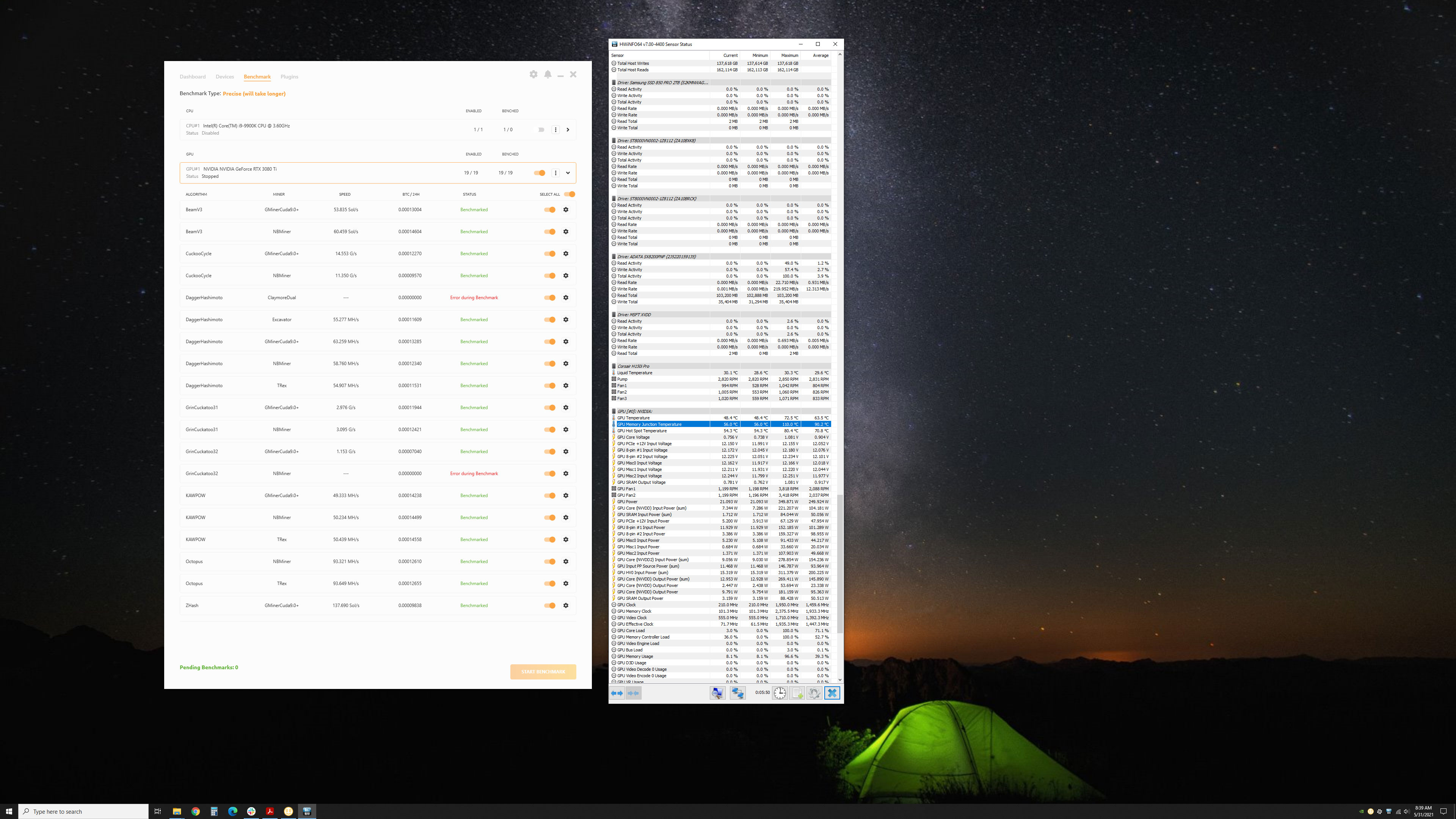Nvidia GeForce RTX 3080 Ti Review: Great Performance at a High Price
Basically a 3090 with half the VRAM and an inferior cooler
The Nvidia GeForce RTX 3080 Ti story should be familiar ground. Halfway through the regular product cycle, release a higher-spec, higher-performance variant of the existing x80-series part with a price that makes for a compelling upgrade. The GTX 1080 was a great card back in the day, and the GTX 1080 Ti upped the ante and basically redefined what we came to expect from a mid-cycle update. But anything even remotely competitive from our GPU benchmarks hierarchy, along with all the best graphics cards, are in a bad place right now with virtually no availability at retail and exorbitant prices on places like eBay. As a result, the RTX 3080 Ti ends up looking a lot more like the RTX 2080 Ti than the GTX 1080 Ti: Fast but expensive.
Fundamentally, nothing has changed with the Nvidia Ampere architecture. More games support ray tracing and DLSS, and driver improvements over the previous nine months have altered performance a bit since launch. Otherwise, the RTX 3080 Ti takes the same GA102 GPU found in the GeForce RTX 3090 and GeForce RTX 3080, disables two more SMs compared to the 3090, and slashes the VRAM capacity in half compared to the 3090. That's not actually that big of a deal in most games, and performance should generally be quite similar between the two.
The real question will be retail pricing and availability, which will undoubtedly be awful. Officially, the RTX 3080 Ti Founders Edition has a $1,199 price tag — $300 less than the 3090, but $500 more than the 3080. In practice, the RTX 3080 already sells for close to $2,000 on eBay, and even in the Newegg Shuffle, it routinely goes for over $1,200. Meanwhile, the RTX 3090 pushes closer to $3,000 on eBay and costs more than $2,000 in the Newegg Shuffles we've tracked — and your odds of getting picked in the Shuffle are extremely low, based on our experience.
Here's a quick overview of the specifications for the RTX 3080 Ti, along with similar Nvidia GPUs:
| Graphics Card | RTX 3090 | RTX 3080 Ti | RTX 3080 | RTX 2080 Ti |
|---|---|---|---|---|
| Architecture | GA102 | GA102 | GA102 | TU102 |
| Process Technology | Samsung 8N | Samsung 8N | Samsung 8N | TSMC 12FFN |
| Transistors (Billion) | 28.3 | 28.3 | 28.3 | 18.6 |
| Die size (mm^2) | 628.4 | 628.4 | 628.4 | 754 |
| SMs / CUs | 82 | 80 | 68 | 68 |
| GPU Cores | 10496 | 10240 | 8704 | 4352 |
| Tensor Cores | 328 | 320 | 272 | 544 |
| RT Cores | 82 | 80 | 68 | 68 |
| Base Clock (MHz) | 1395 | 1370 | 1440 | 1515 |
| Boost Clock (MHz) | 1695 | 1665 | 1710 | 1545 |
| VRAM Speed (Gbps) | 19.5 | 19 | 19 | 14 |
| VRAM (GB) | 24 | 12 | 10 | 11 |
| VRAM Bus Width | 384 | 384 | 320 | 352 |
| ROPs | 112 | 112 | 96 | 88 |
| TMUs | 328 | 320 | 272 | 272 |
| TFLOPS FP32 (Boost) | 35.6 | 34.1 | 29.8 | 13.4 |
| TFLOPS FP16 (Tensor) | 142 (285) | 136 (273) | 119 (238) | 108 |
| RT TFLOPS | 69 | 67 | 58 | 43 |
| Bandwidth (GBps) | 936 | 912 | 760 | 616 |
| TDP (watts) | 350 | 350 | 320 | 260 |
| Launch Date | Sep 2020 | Jun 2021 | Sep 2020 | Sep 2018 |
| Launch Price | $1,499 | $1,199 | $699 | $1,199 |
In terms of theoretical performance, the RTX 3080 Ti lands 3–4% behind the RTX 3090 and 14–20% ahead of the RTX 3080. Memory bandwidth shows the biggest gains, thanks to the addition of two memory channels, though clocks are slightly lower on the GPU side of things. Power consumption is rated at 350W, the same as the 3090 and 30W more than the 3080, which could be a problem given the 3080 Ti Founders Edition uses the same cooler design as the 3080 rather than the triple-slot monstrosity that is the 3090 Founders Edition.
Looking at generational improvements, the RTX 3080 Ti is potentially more than double the compute performance of the 2080 Ti, with nearly 50% more memory bandwidth. In practice, we expect performance will be about 40–50% faster than the 2080 Ti, but that will mostly be at 4K and 1440p. Buying a GPU like this for 1080p gaming (unless you're playing games with lots of ray tracing effects) would be a waste of money.
One final item of note before we continue is that the RTX 3080 Ti implements Nvidia's Ethereum hashrate limiter. The limiter works as expected for the time being, and we saw average hash rates of 55–65 MHps at stock settings, depending on the software used. That's basically half the performance we'd expect from the hardware and similar to what we saw with the launch of the GeForce RTX 3060. Hopefully, Nvidia doesn't accidentally circumvent its own lock this time, though we expect pricing will remain higher than the official starting point, even with the limiter.
GeForce RTX 3080 Ti Design: Unchanged From RTX 3080
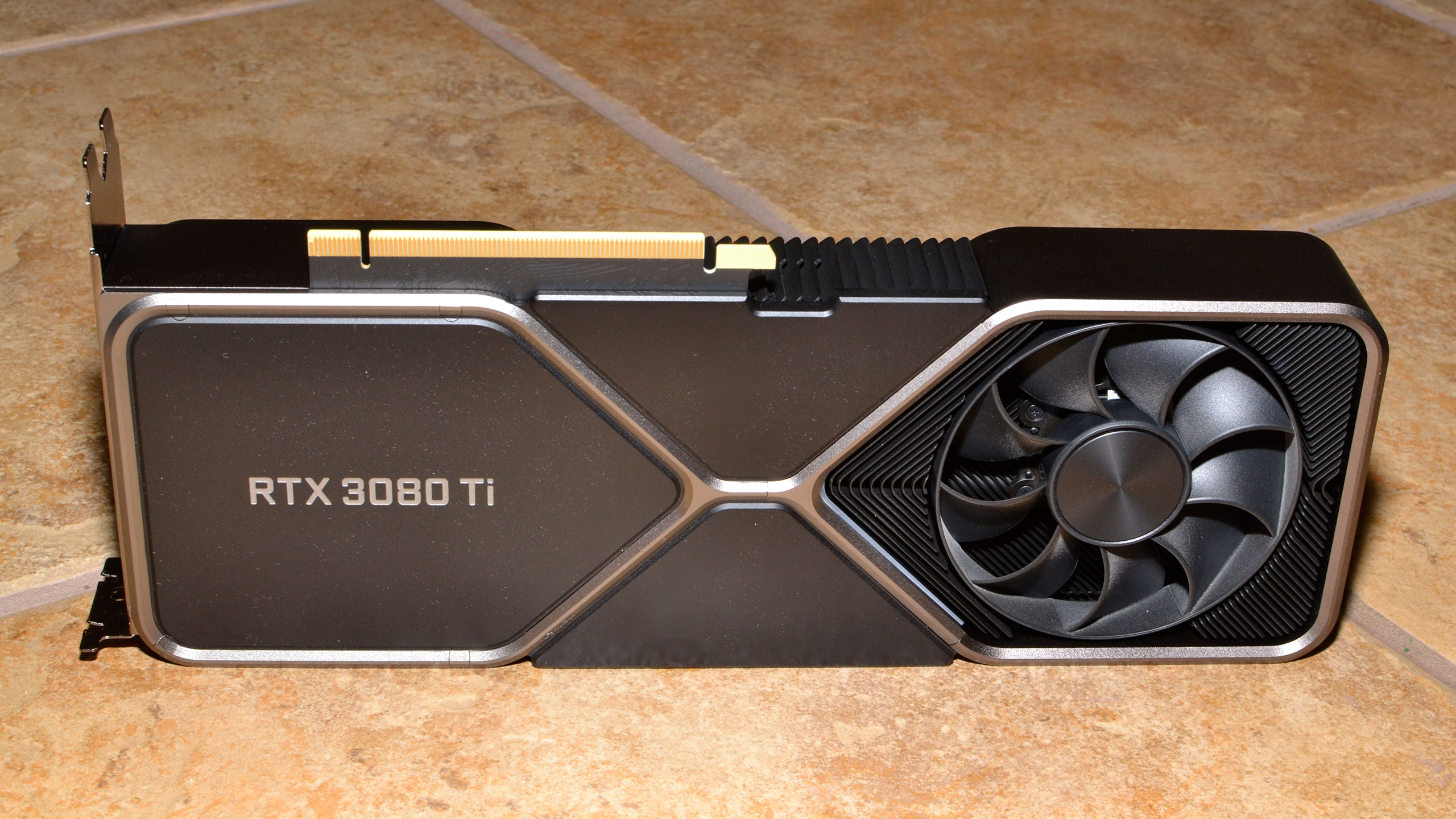



For better or worse, Nvidia hasn't altered the card design relative to the RTX 3080 Founders Edition. The cooler mostly worked well before and ran reasonably quiet… except when the GDDR6X memory got hot and the fans had to kick up to full speed. We hoped Nvidia would use better thermal pads for the GDDR6X memory this round, especially with the addition of two more GDDR6X chips, but that doesn't appear to have happened.
In testing, games generally didn't have major problems, with memory temperatures peaking at anywhere from 94C–104C. The higher end of that range is a concern, however, as we're dealing with a brand-new card. How will it perform after a year or two of use? We've been there, countless times, and the answer will inevitably be higher temperatures and fan speeds over time.
Testing mining algorithms was a different story, with multiple algorithms pushing the GDDR6X temps to 110C, max fan speeds, and throttling of GPU clocks to try to compensate. Some future game, or game that we haven't tested, might behave in a similar fashion, but we haven't encountered any specific games that match the intensity of mining. That's the good news. The bad news is that a $10 thermal pad upgrade for the Founders Edition is still a good idea, but it would void your warranty. Nvidia should have done the 'upgrade' itself and used higher-quality pads.
One thing that has changed since the launch of the RTX 30-series last year is support for the RGB lighting on the cards. We've verified that multiple RGB utilities, including Corsair's iCue, can now control the LEDs on the 3080 and 3090 Founders Edition cards, and that applies to the 3080 Ti Founders Edition as well. Do you want your Nvidia GPU to dress up in AMD red? Now it can! And there was much rejoicing.
We'll be looking at some third party cards in the coming days as well, and hopefully those will pay more attention to memory cooling. This has been a sore spot on RTX 3080 and 3090 cards since launch, with only about 25% of the cards we've looked at using better GDDR6X cooling methods. Considering the extreme nature of these parts, we expect manufacturers to pay more attention to this important aspect of cooling going forward.
GeForce RTX 3080 Ti: Gaming Performance
Our test setup remains unchanged from previous reviews, though we'll be doing additional testing with ray tracing and DLSS — using the same tests as our AMD vs. Nvidia: Ray Tracing Showdown. We're using the test equipment shown above, which consists of a Core i9-9900K, 32GB DDR4-3600 memory, 2TB M.2 SSD, and the various GPUs being tested — all of which are reference models here.
That gives us two sets of results. First is the traditional rendering performance, using thirteen games at 1080p, 1440p, and 4K with ultra/maximum quality settings. Then we have ten more games with RT (and sometimes DLSS, where applicable). We'll start with 4K since this is a top-tier GPU more likely to be used at that resolution, plus it's where the card does best relative to the other GPUs — CPU bottlenecks are almost completely eliminated at 4K but more prevalent at 1080p.
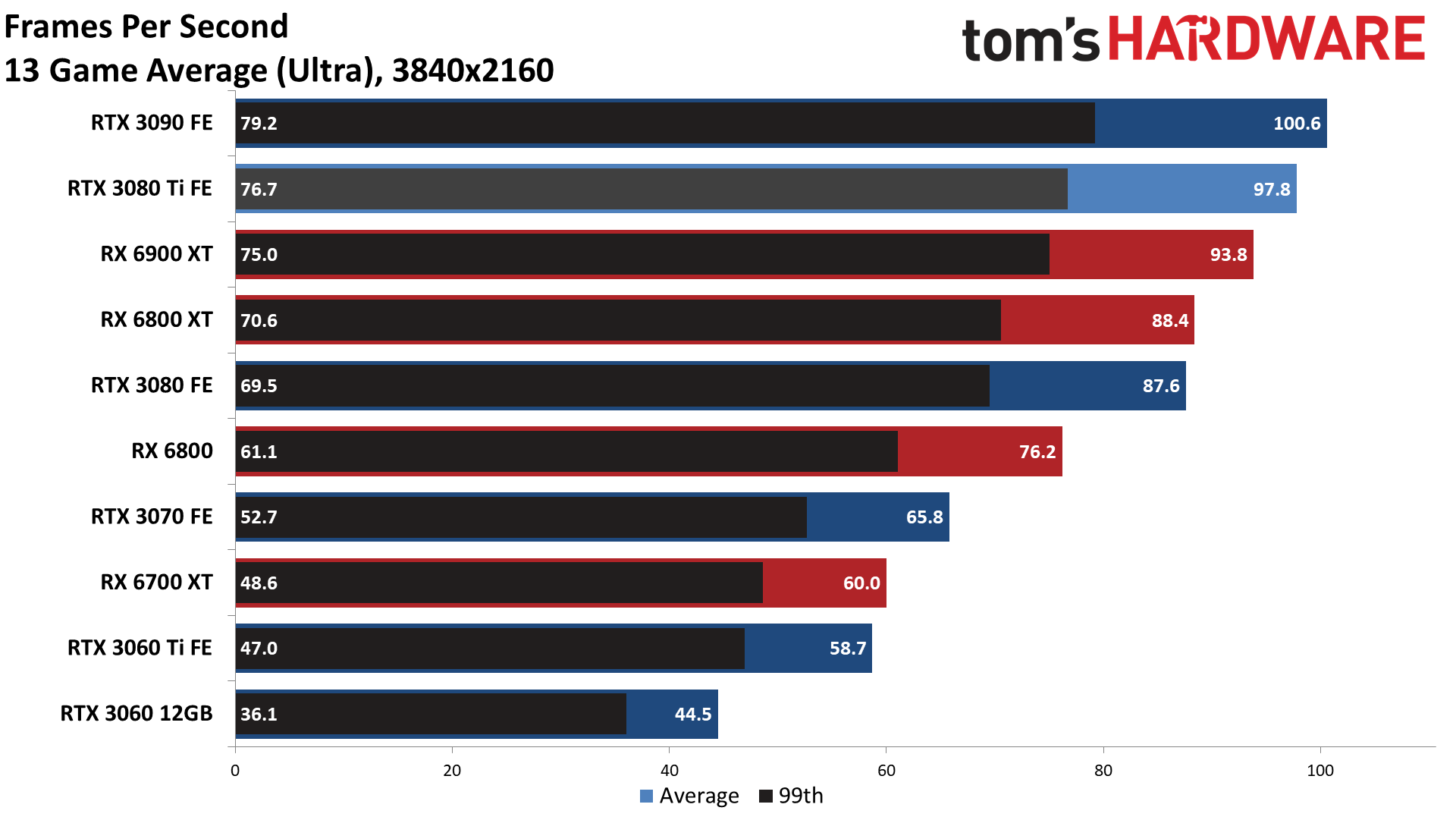




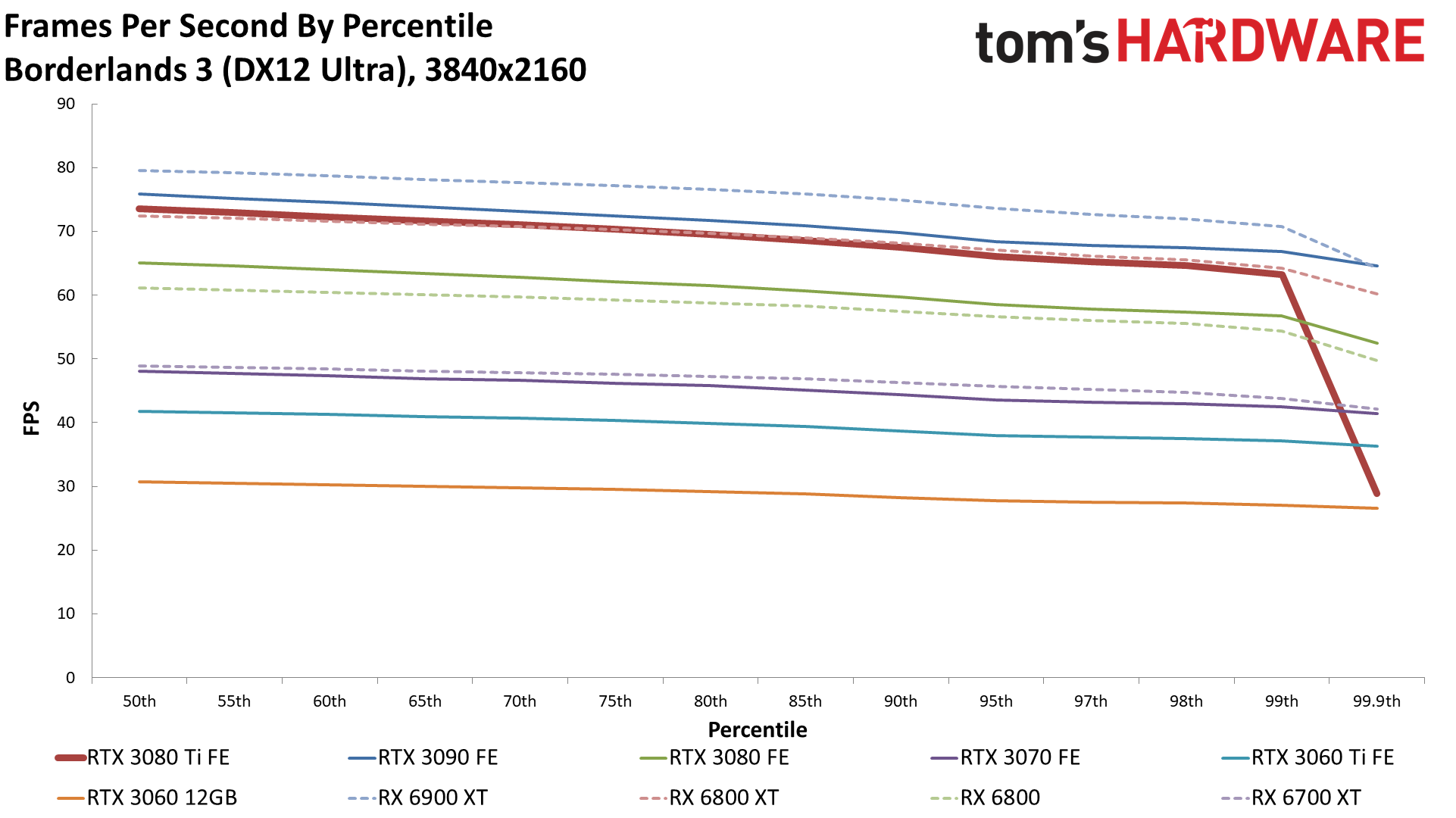
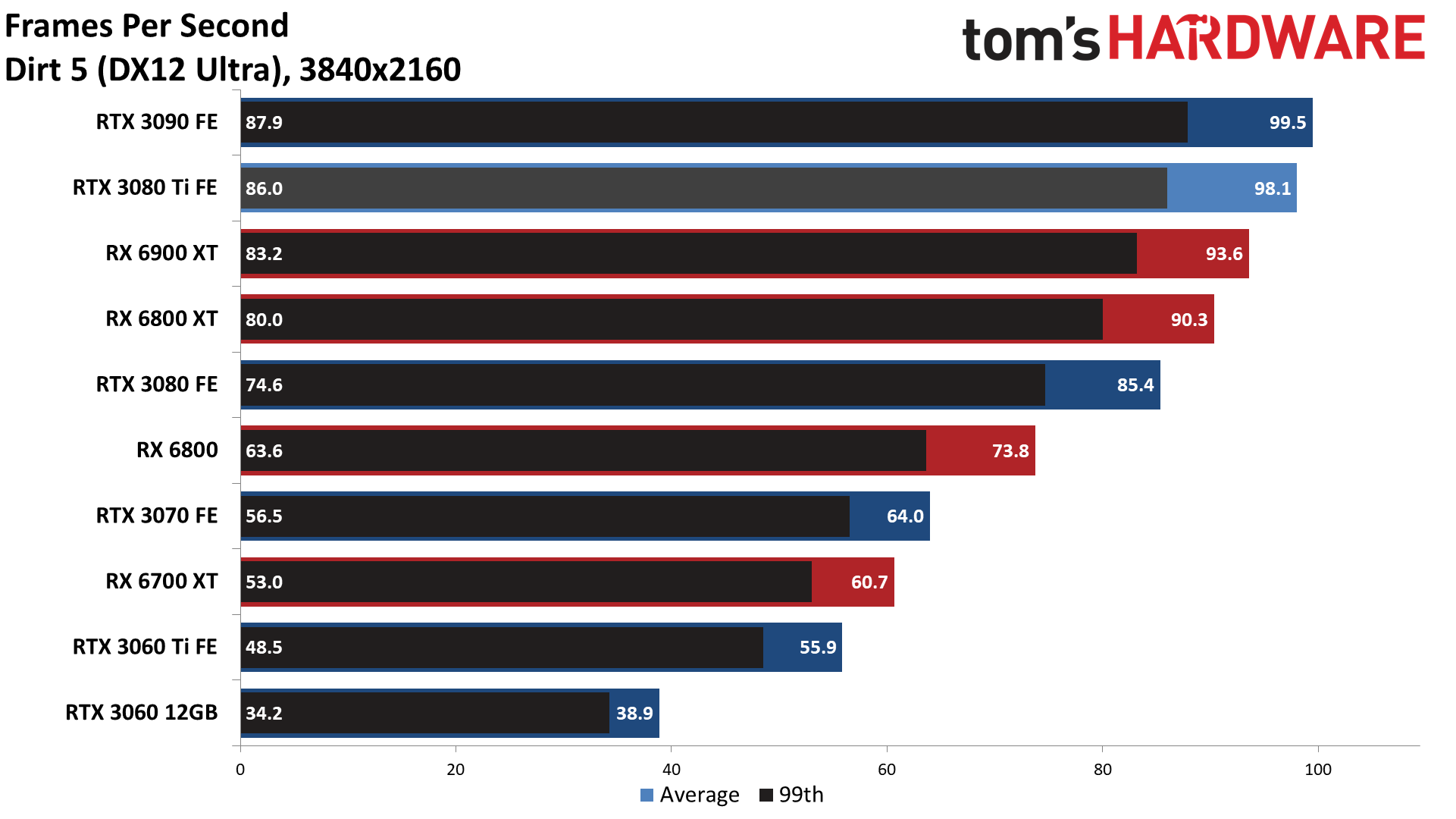
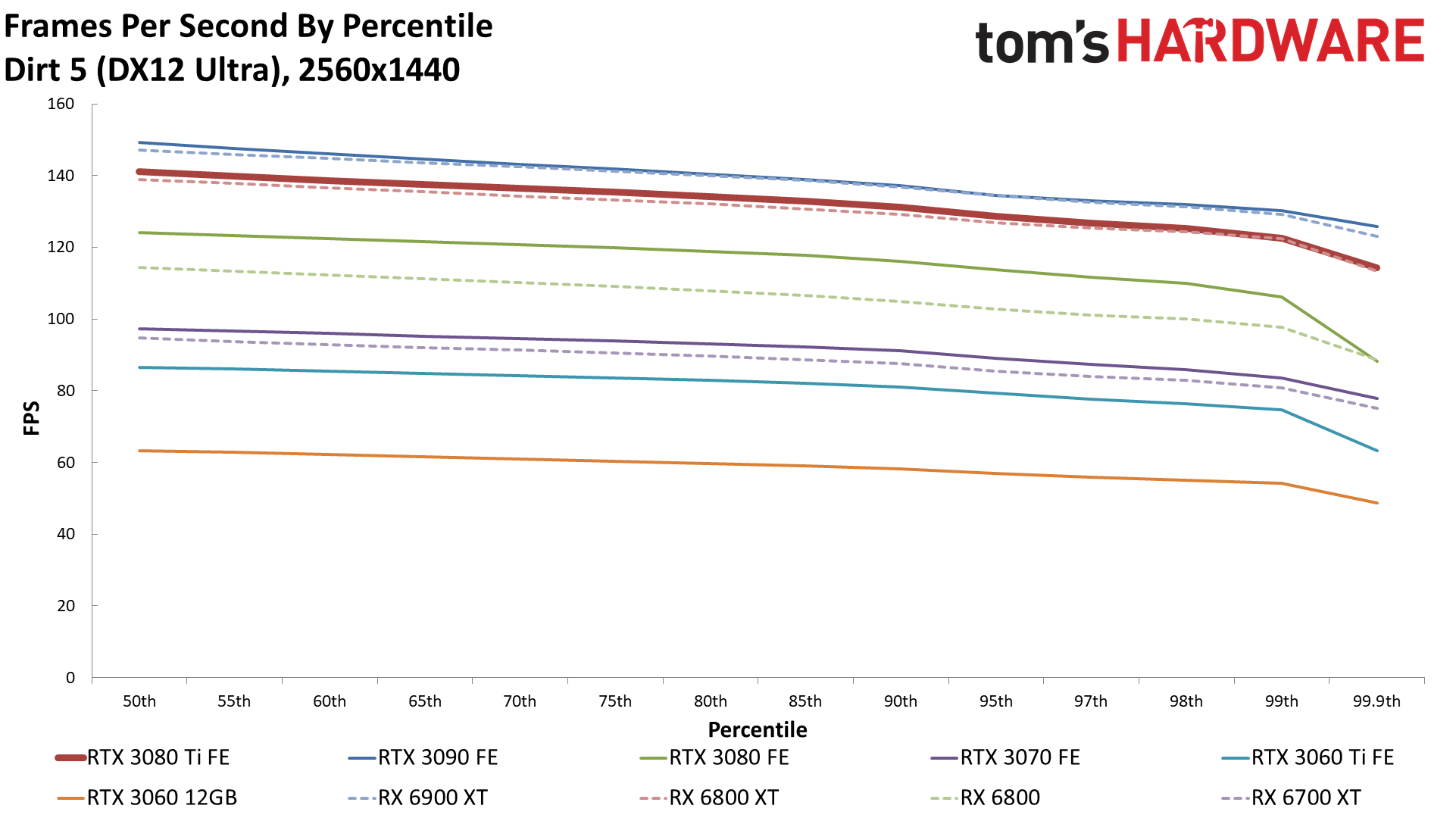




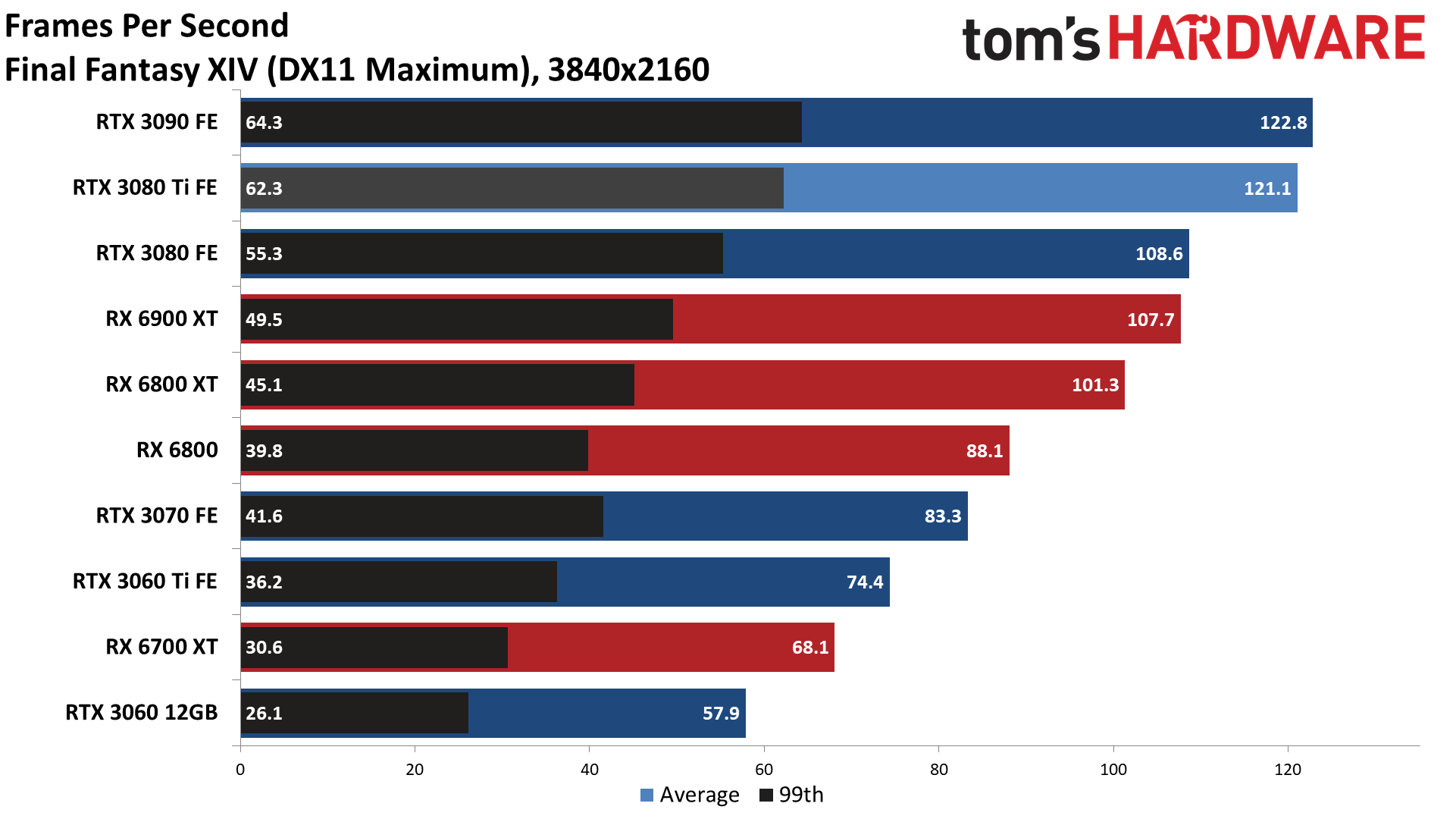
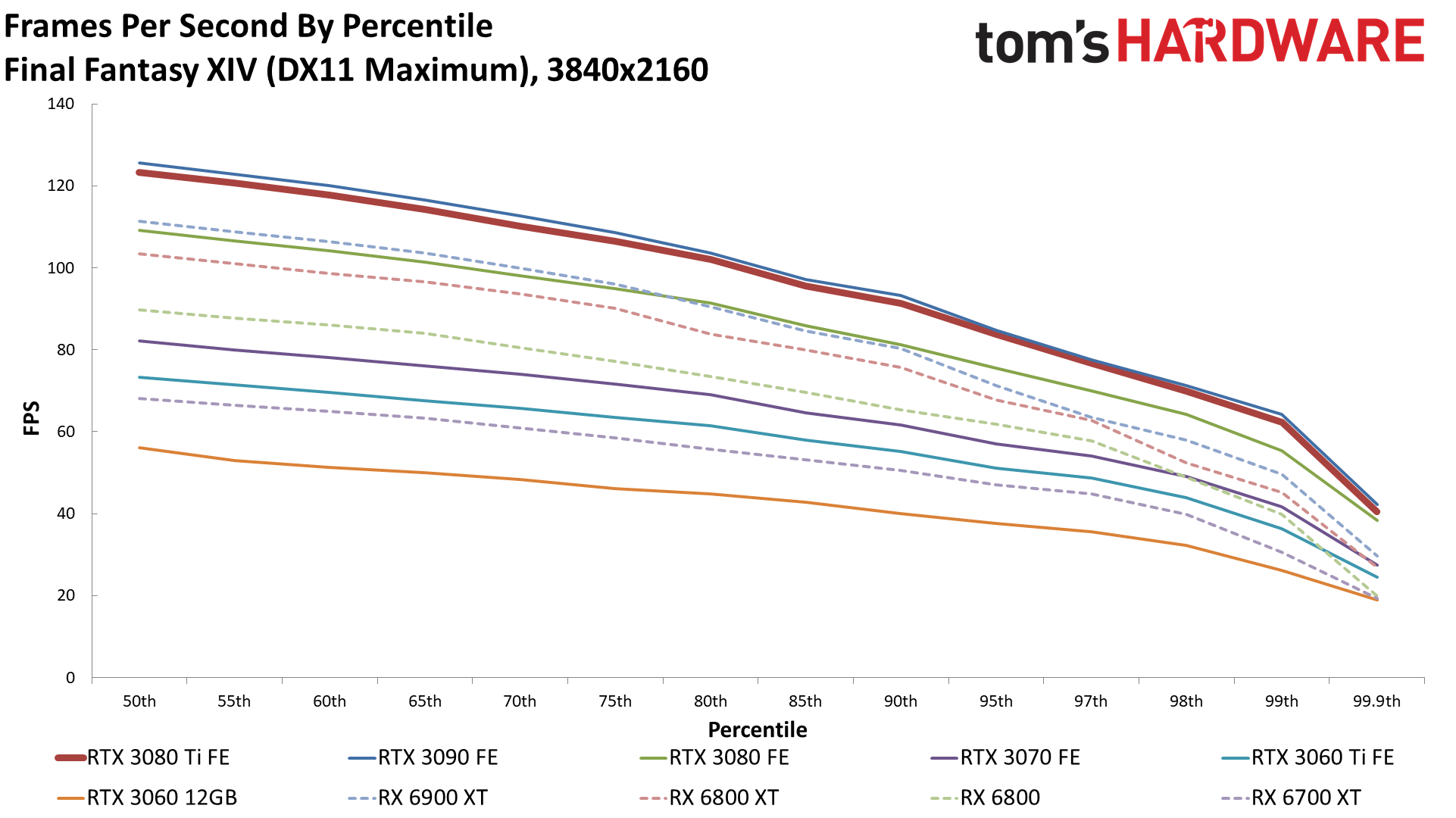
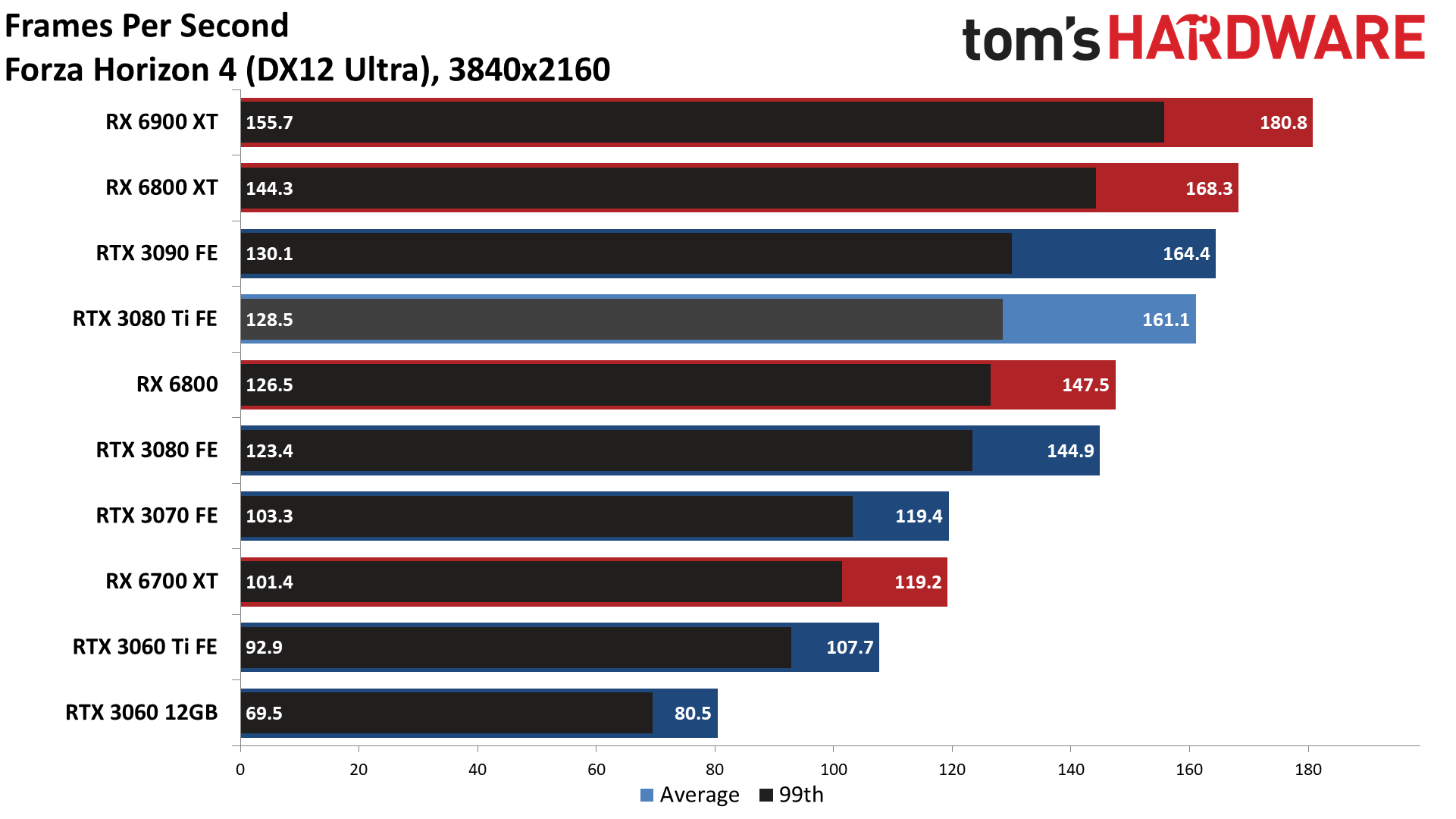
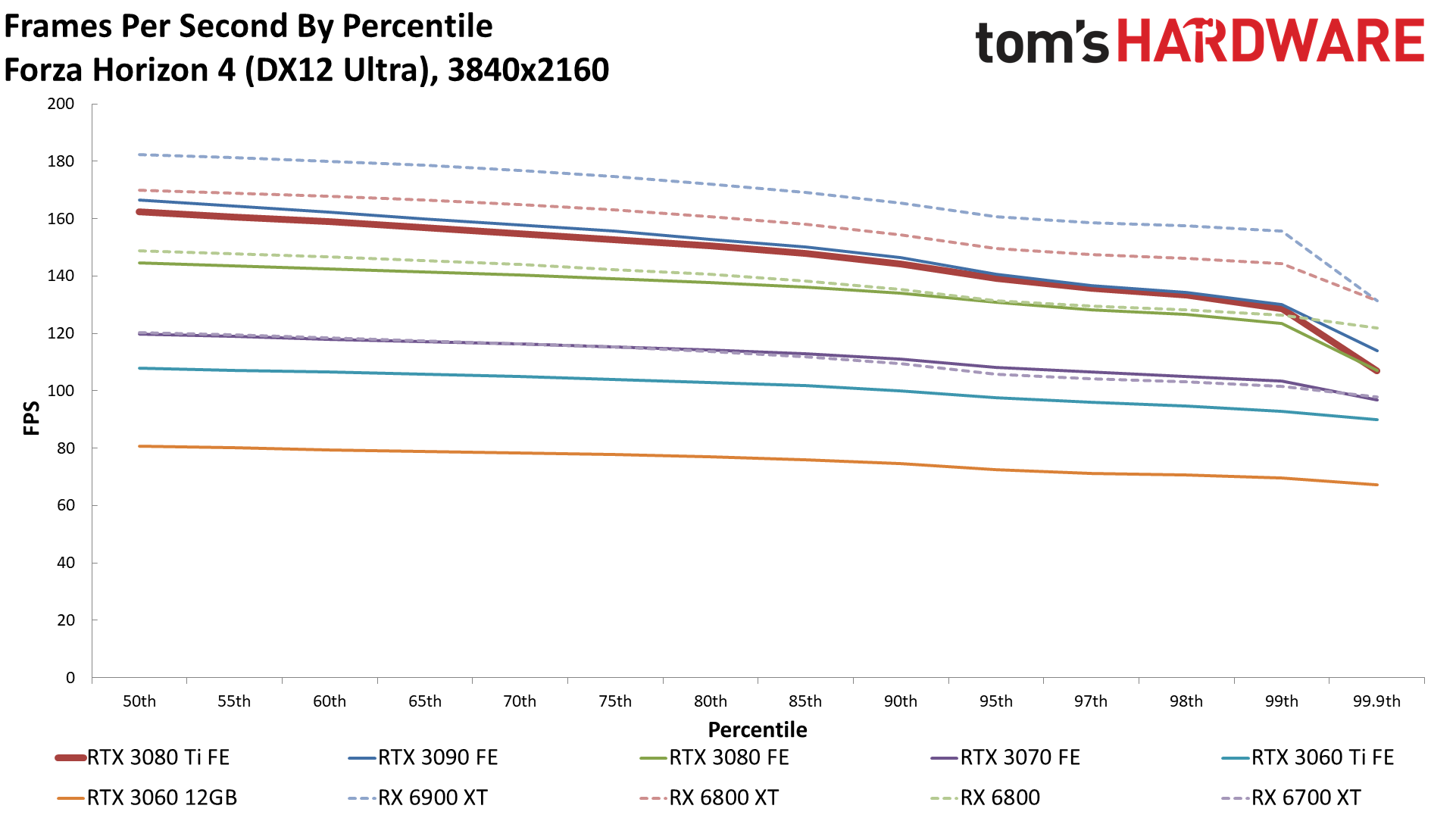
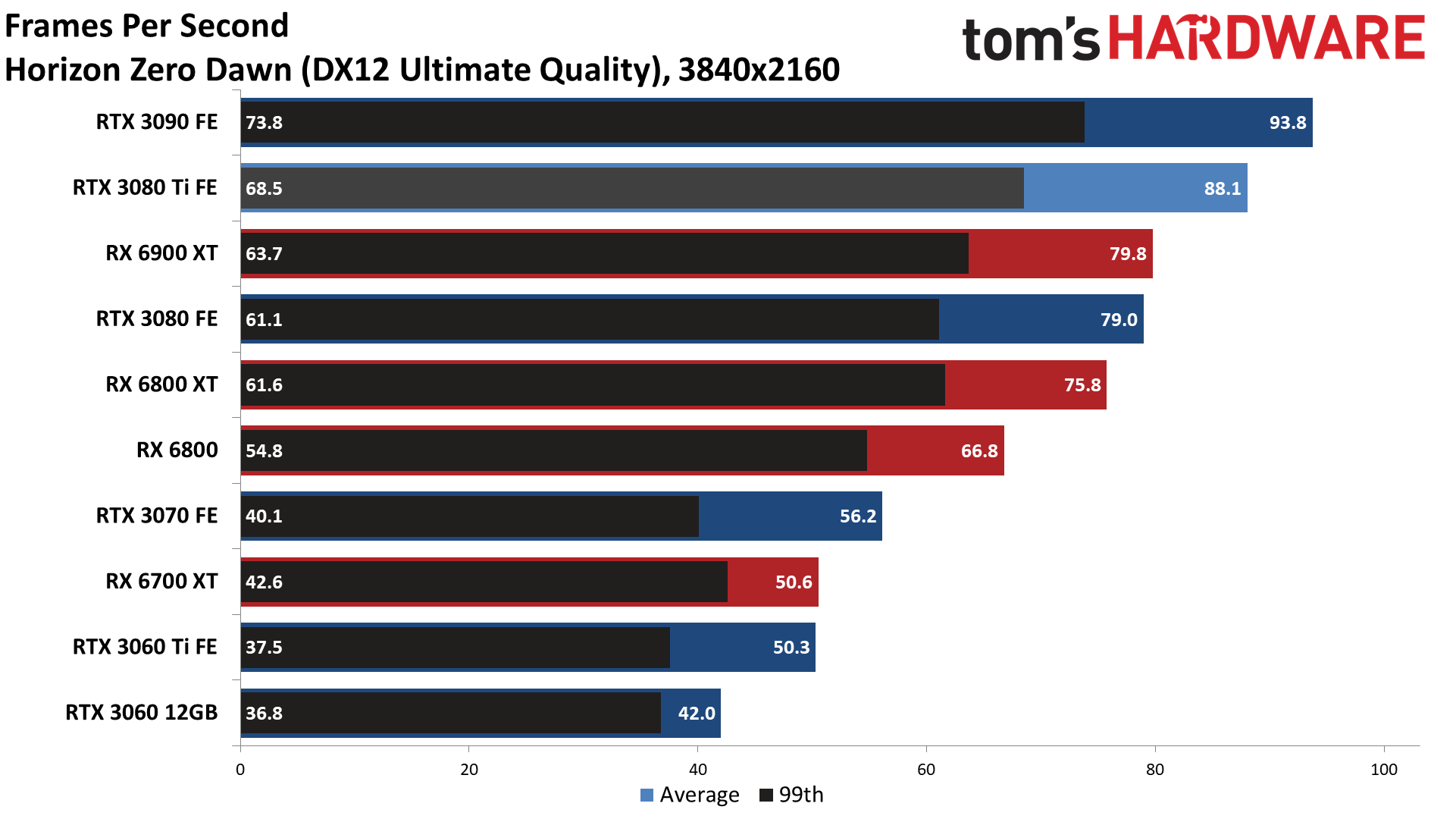
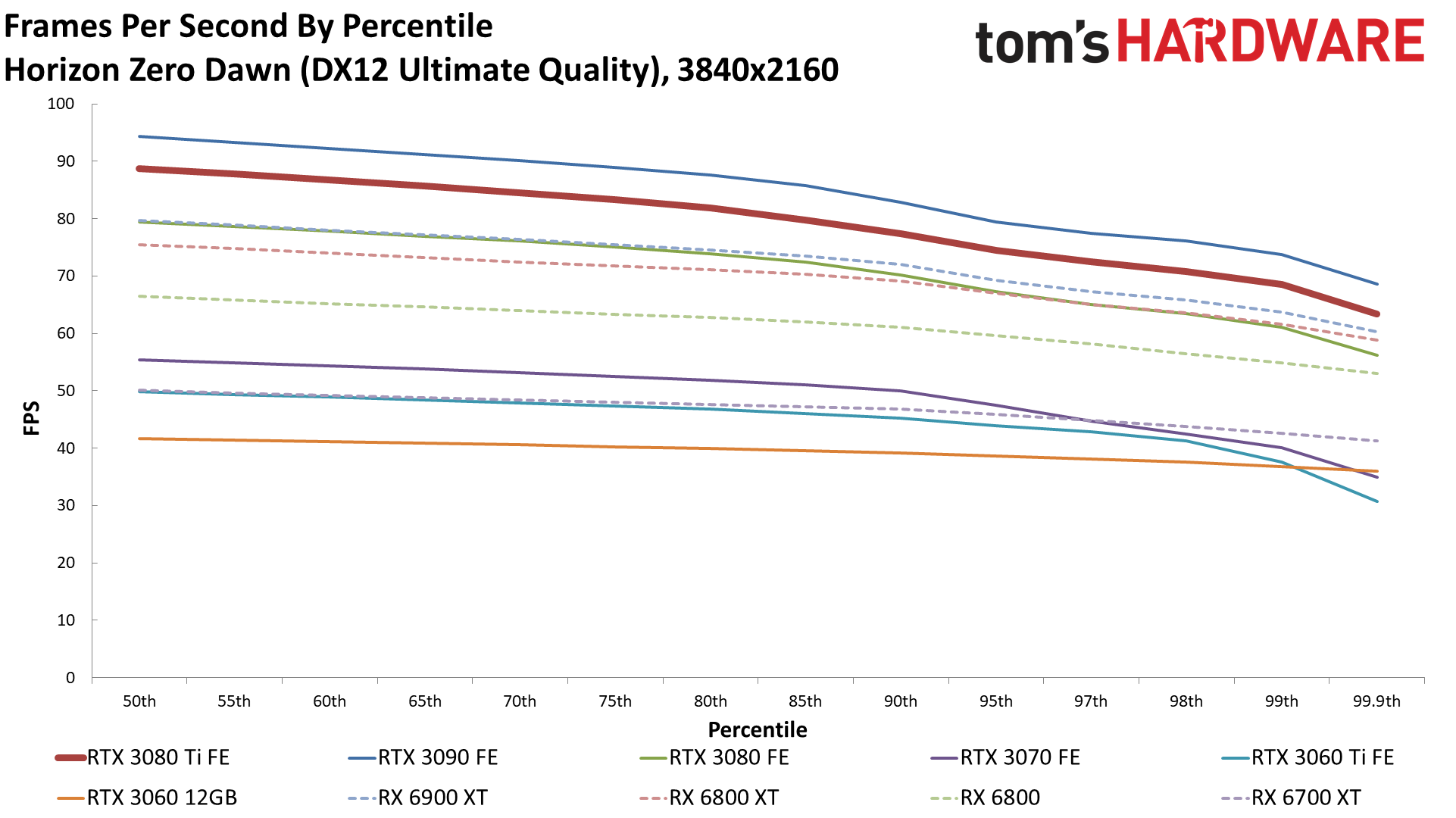
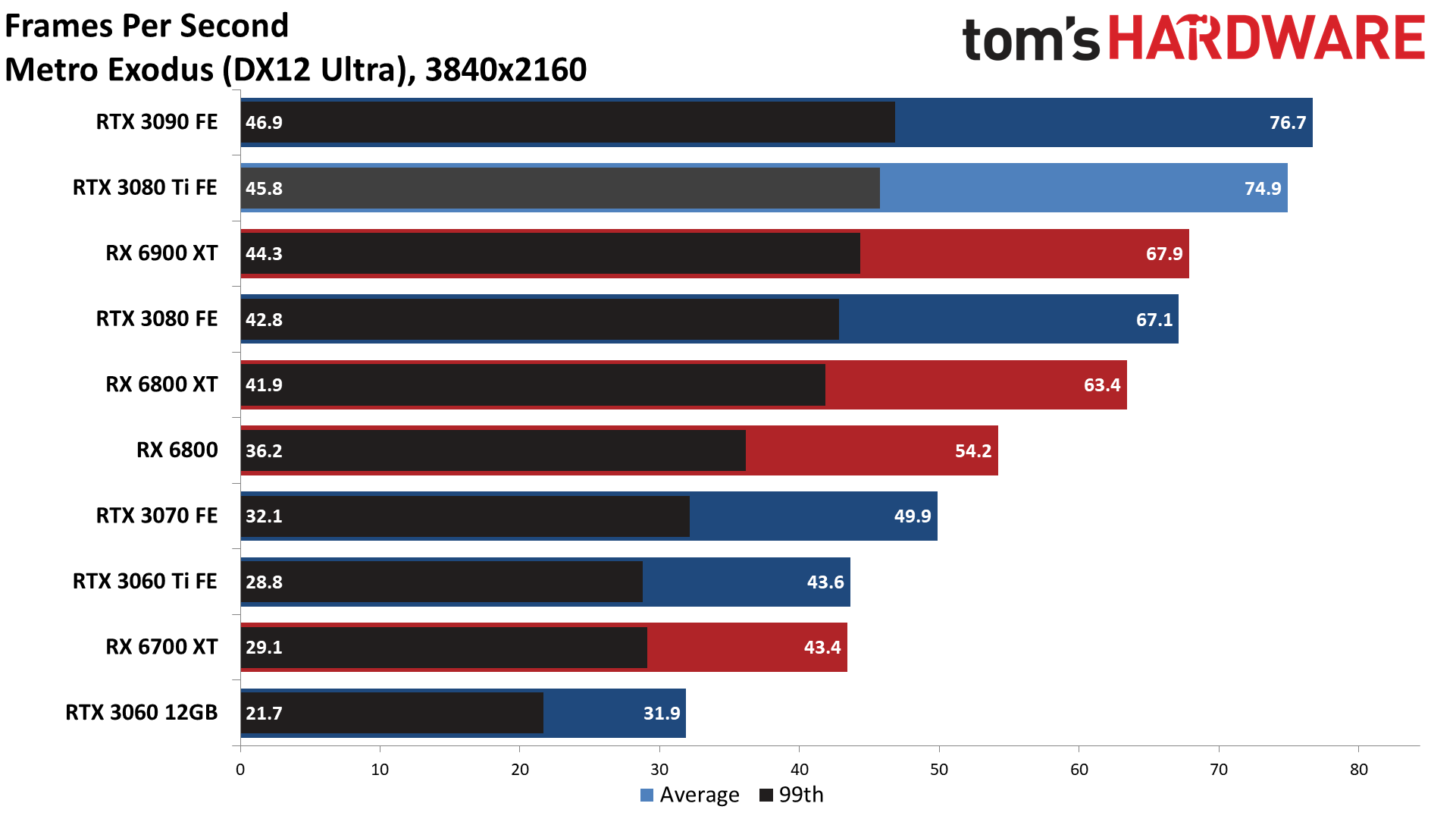
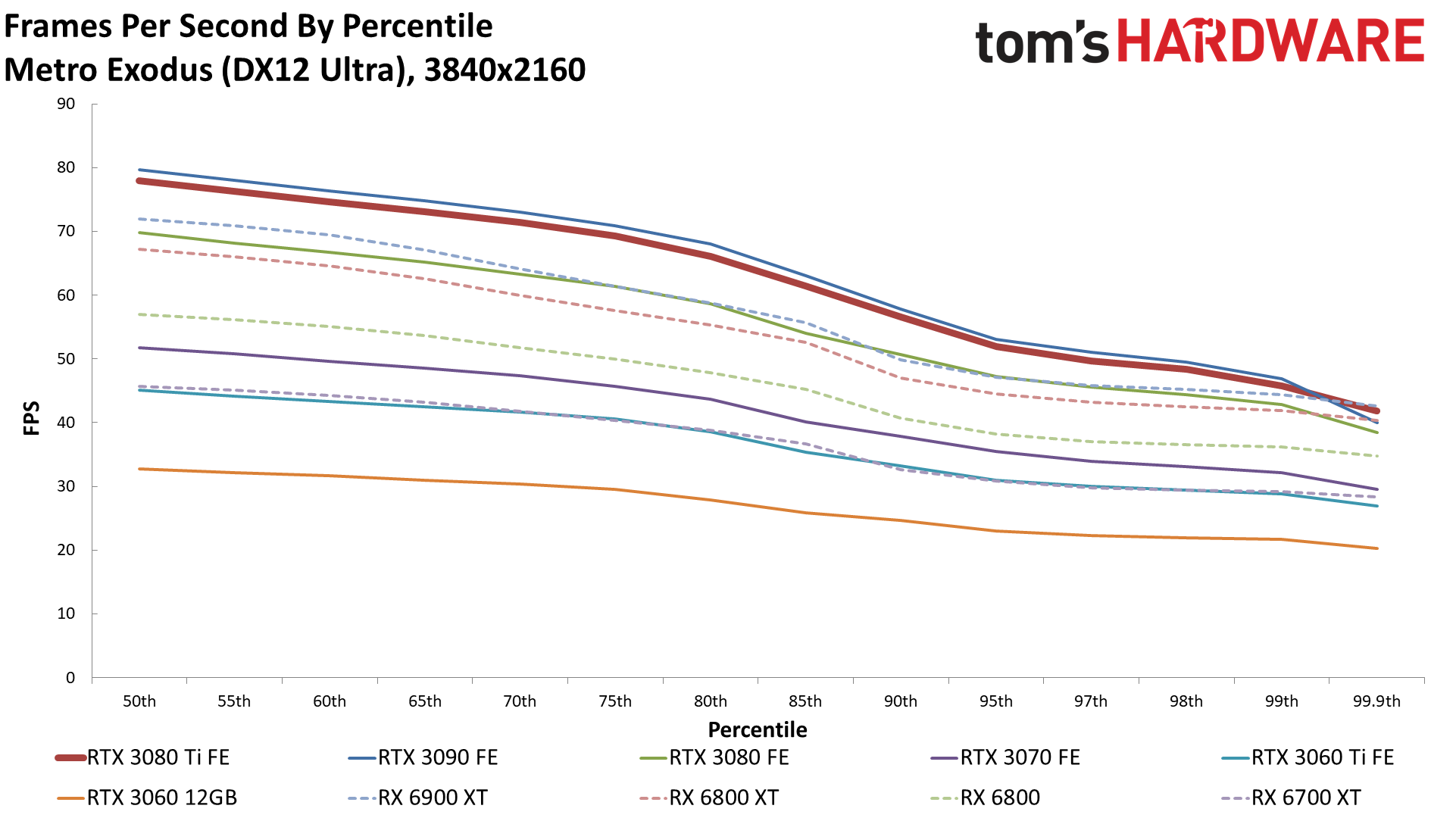
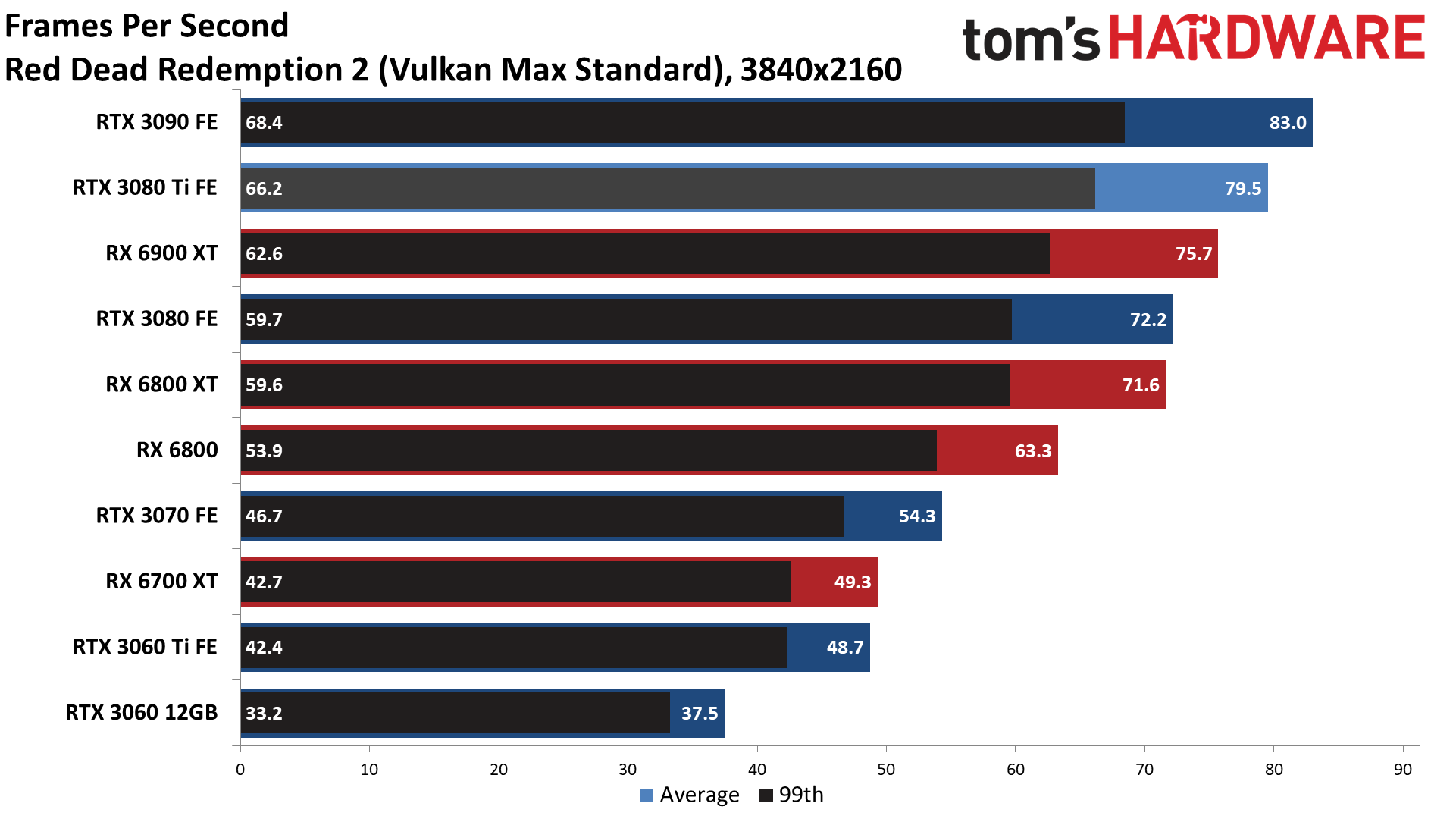
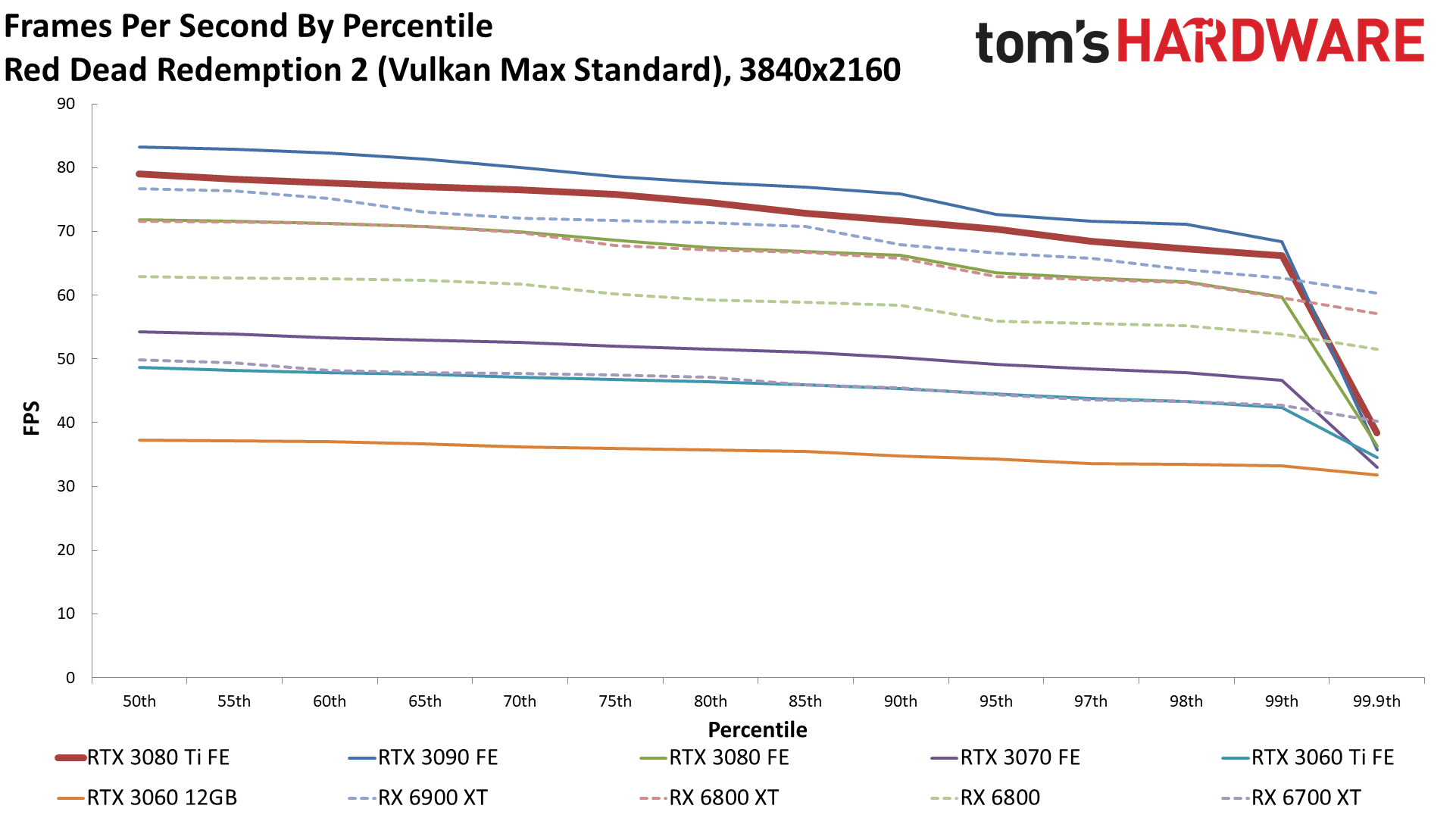
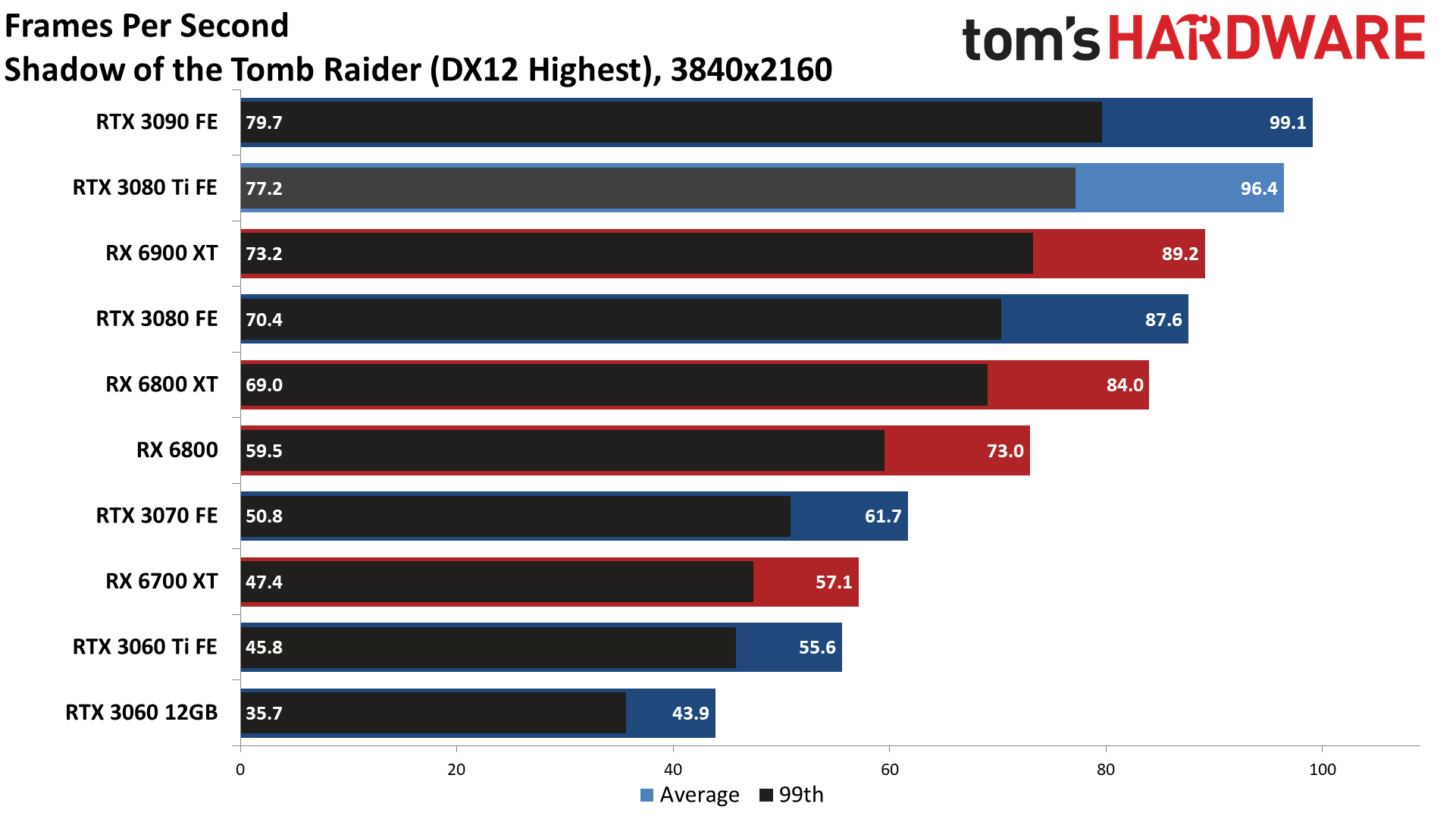
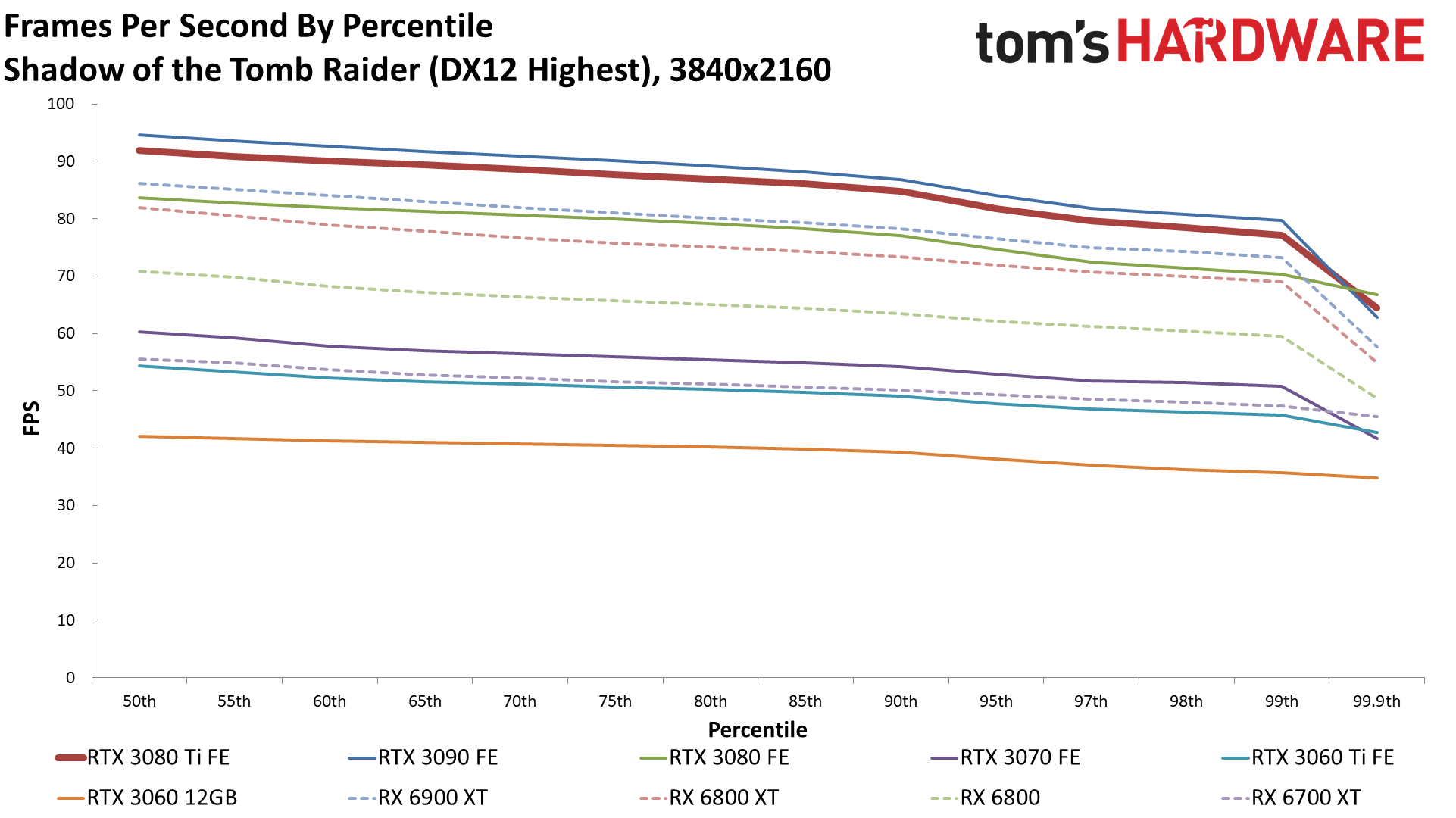
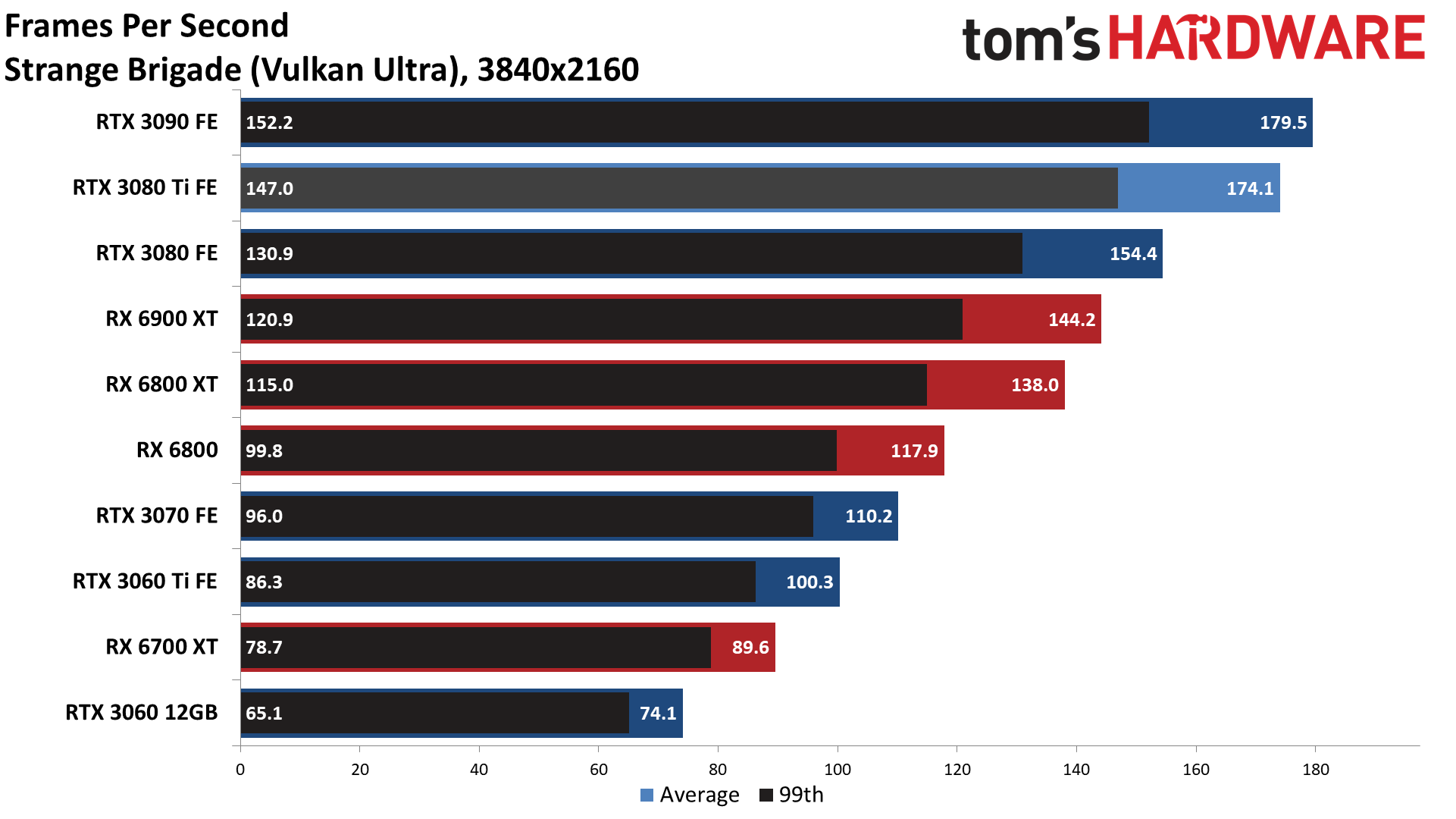


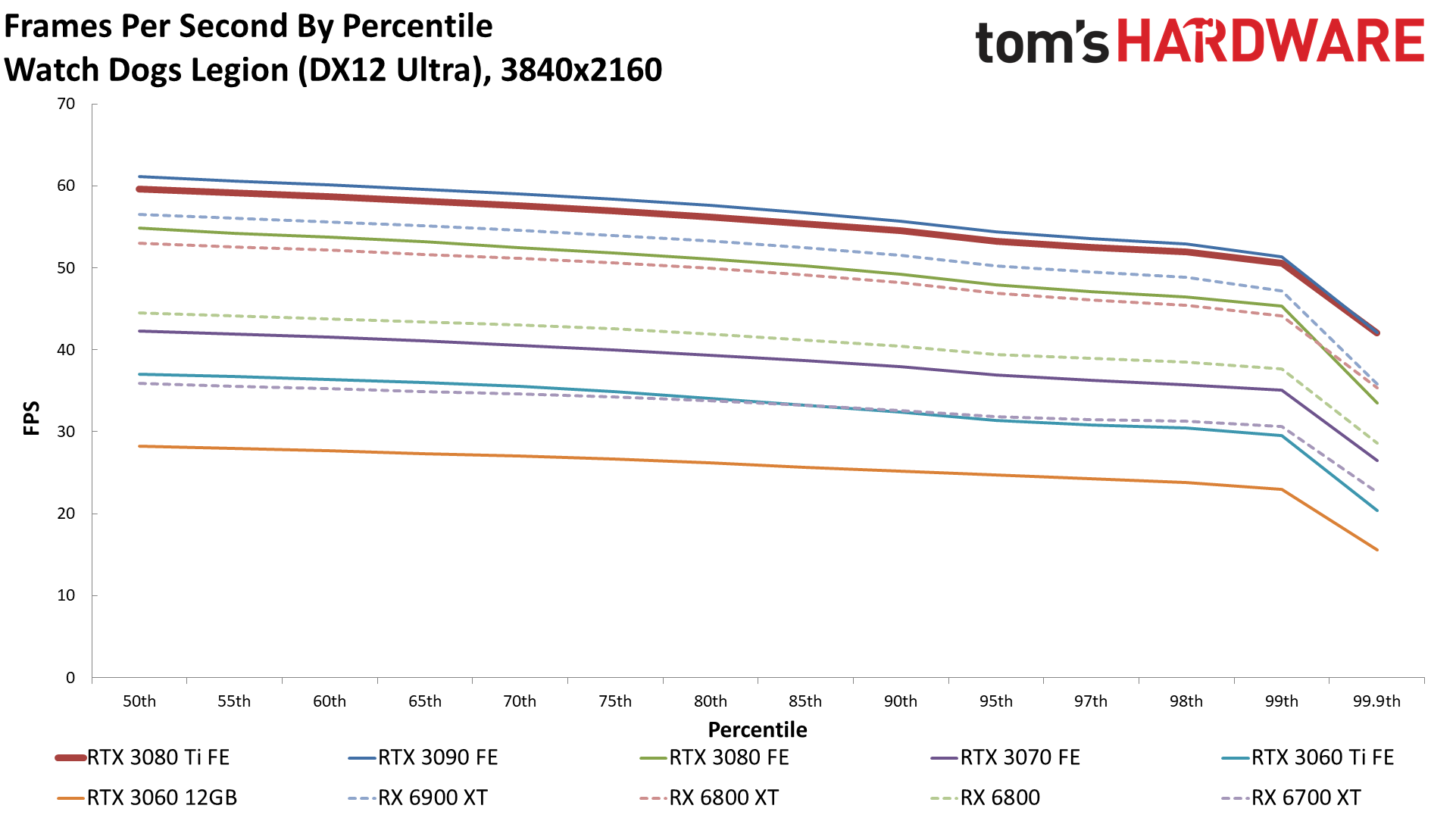
Overall, 4K ultra gaming puts the RTX 3080 Ti right behind the RTX 3090, just as expected. The difference between 24GB and 12GB VRAM generally doesn't show up in our standard test suite in any meaningful way, with the largest gains topping out at around 5%. Basically, it comes down to clock speeds and core counts.
One clear impetus for the RTX 3080 Ti can be seen in the standings. Previously, the RTX 3090 claimed the top spot, but the RTX 3080 traded blows with the RX 6800 XT and often fell behind the RX 6900 XT. The RTX 3080 Ti 'corrects' things and puts Nvidia back in first and second place. AMD still has its strong points, like Assassin's Creed Valhalla, Borderlands 3, and Forza Horizon 4, but at least the two most expensive (based on MSRP) GPUs take the top two spots at 4K ultra — and as we'll see later, ray tracing definitely favors Nvidia by a larger margin.
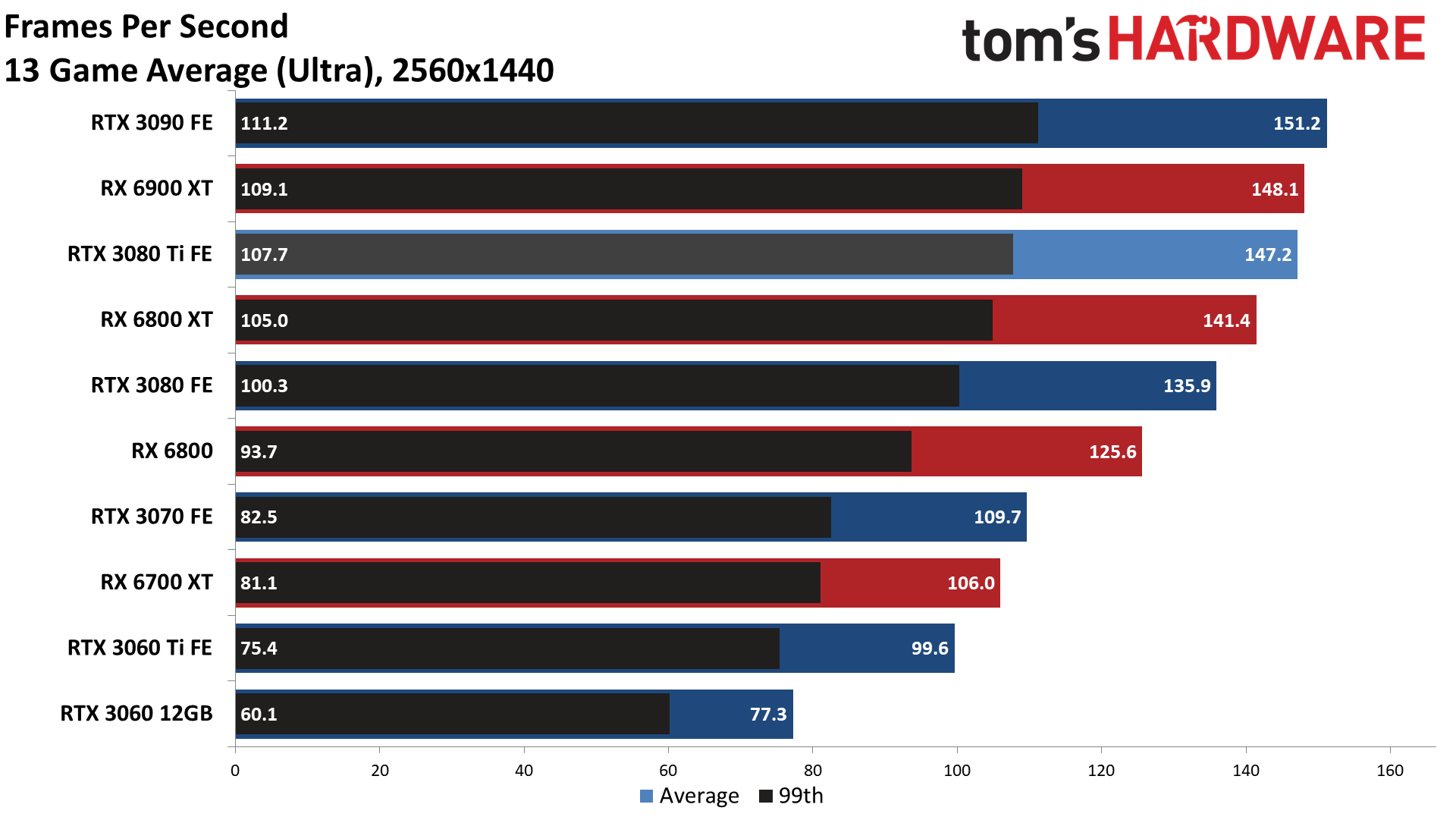
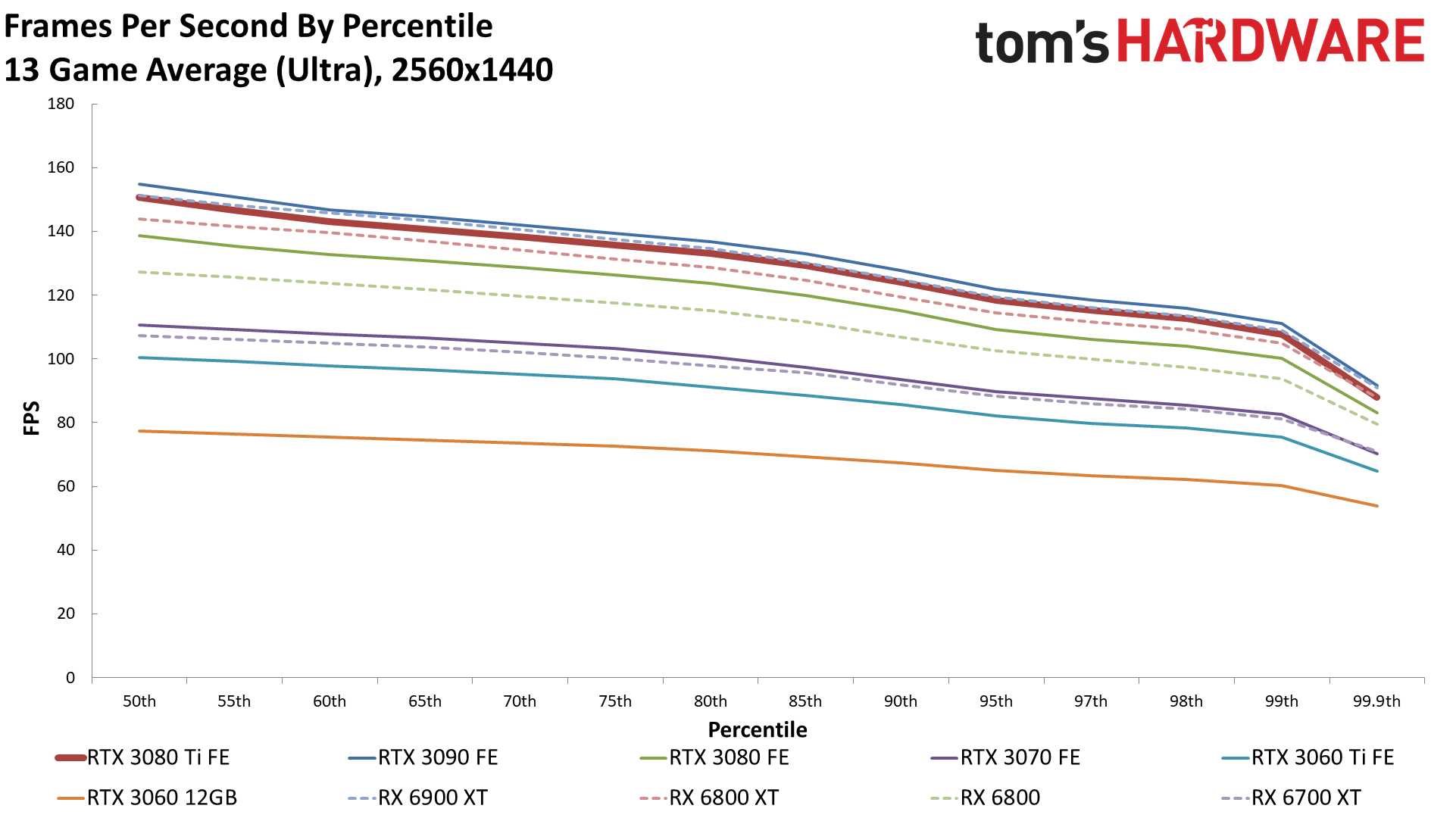
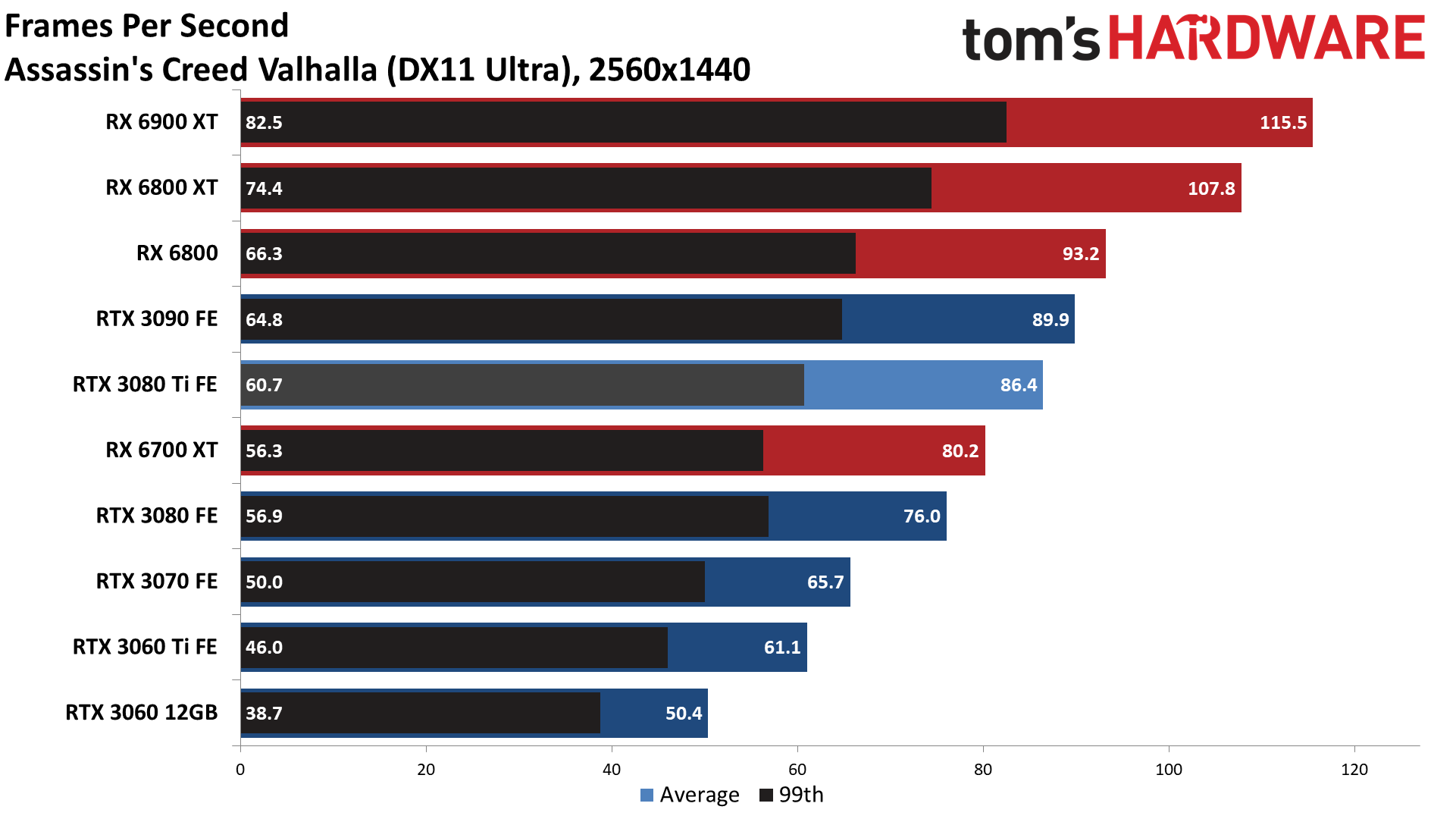



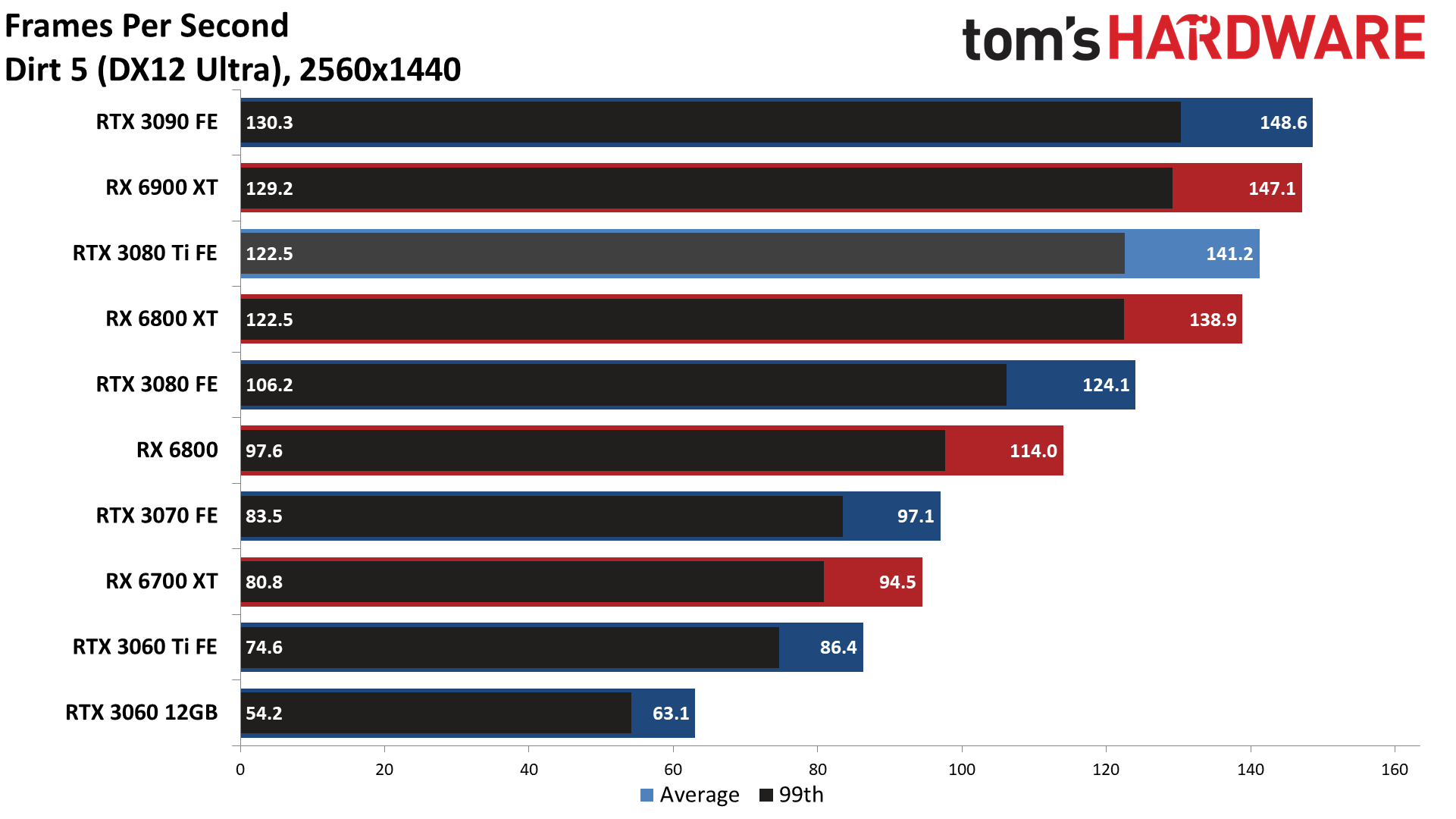

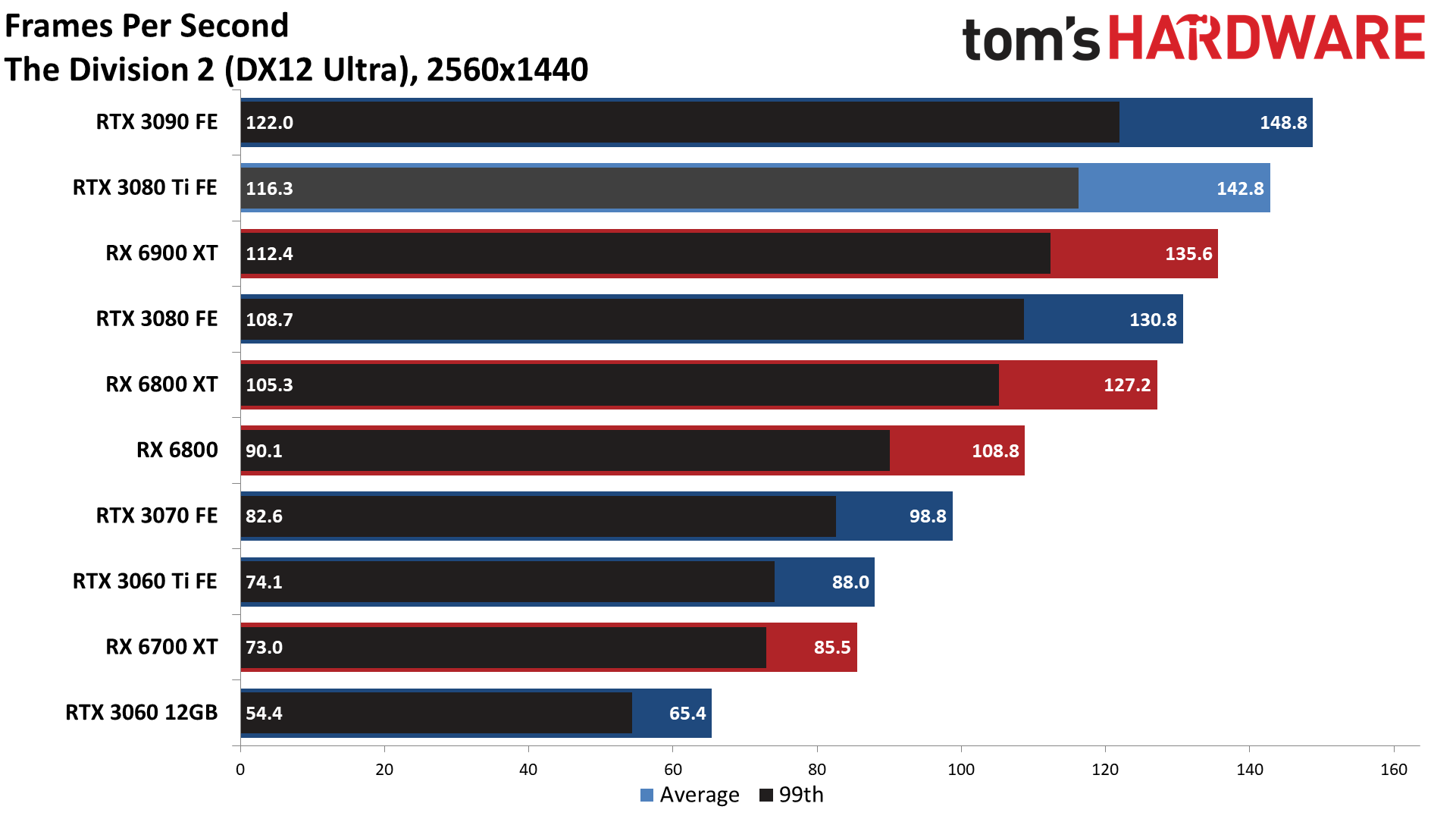
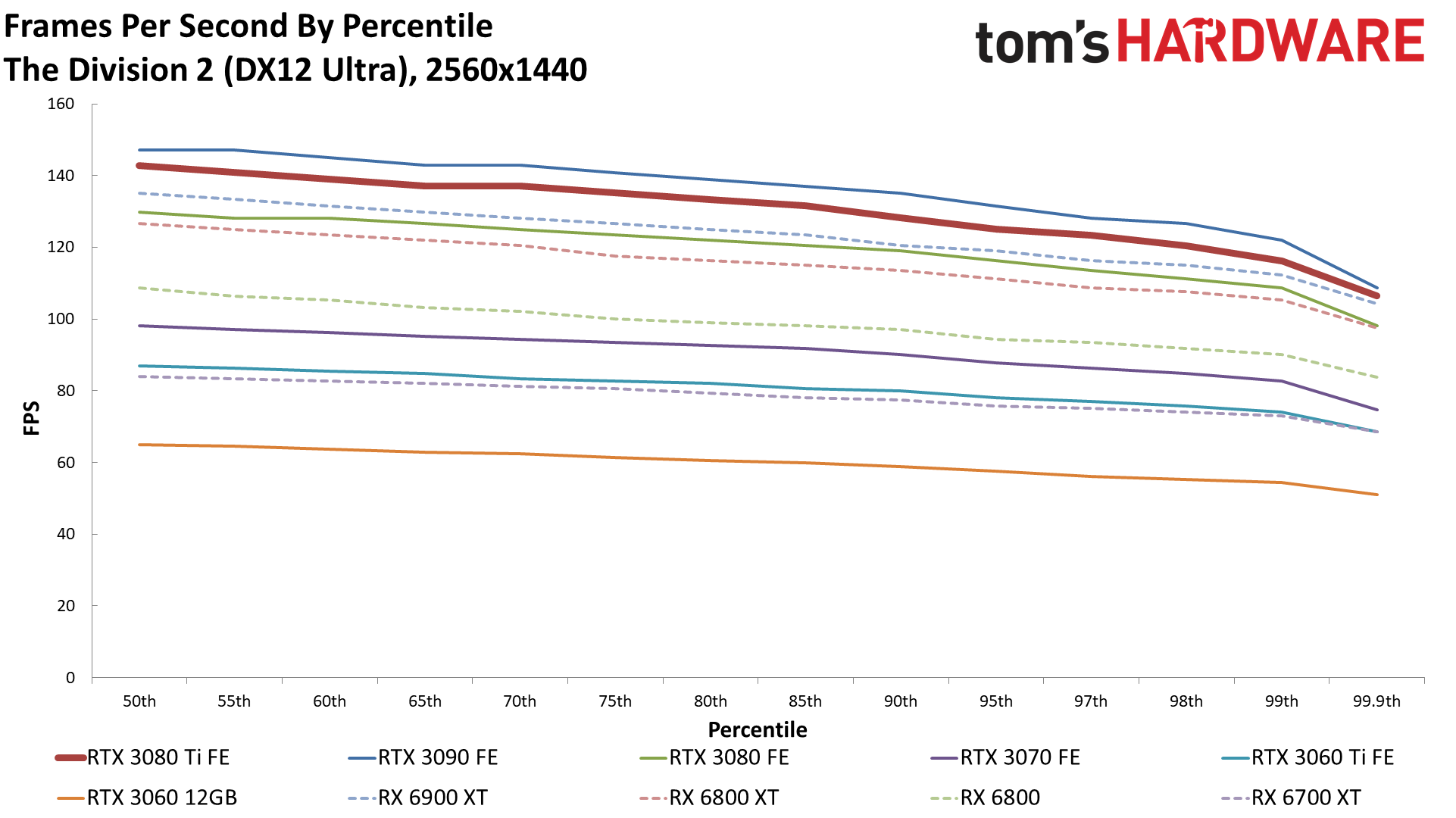
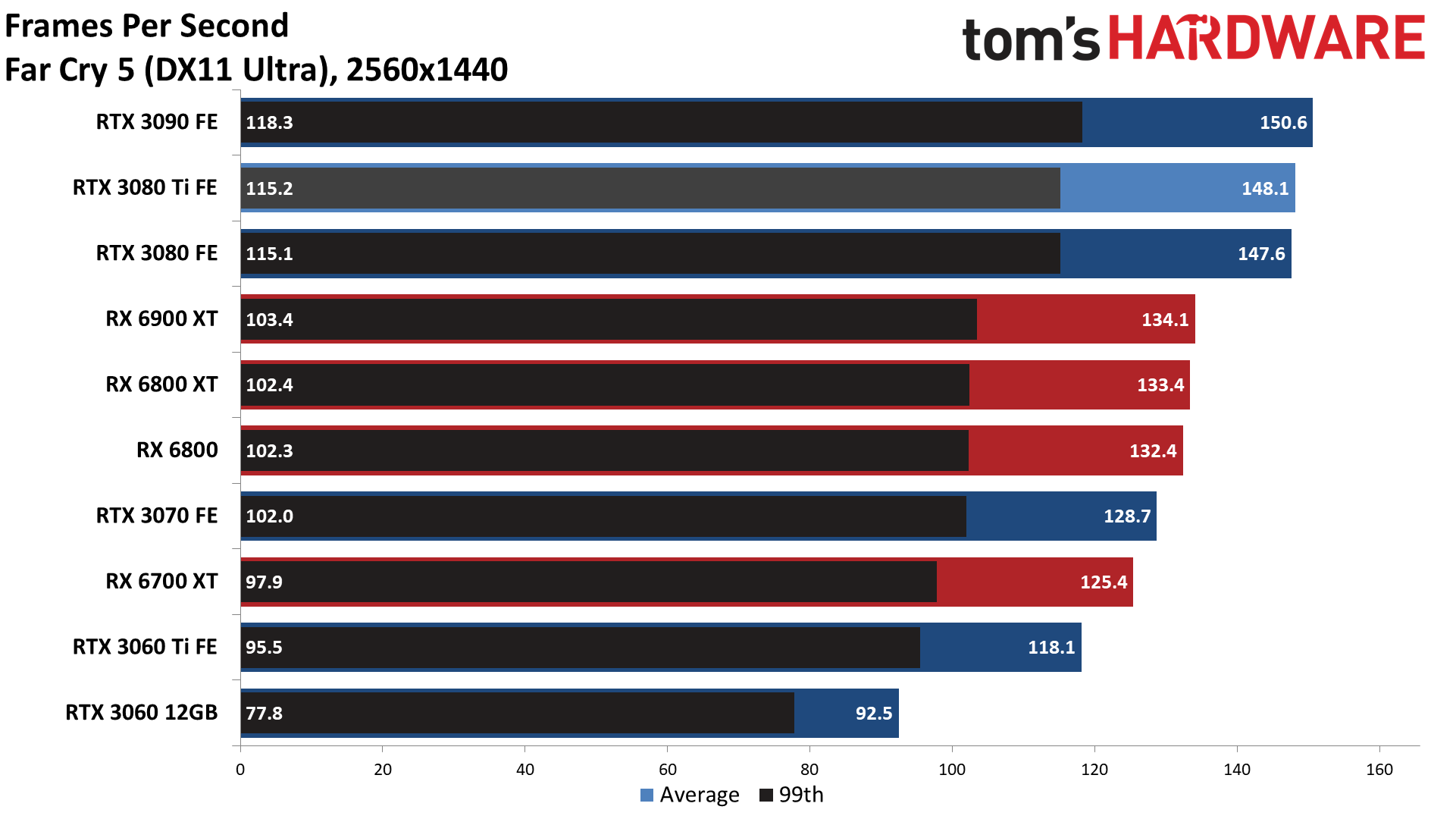
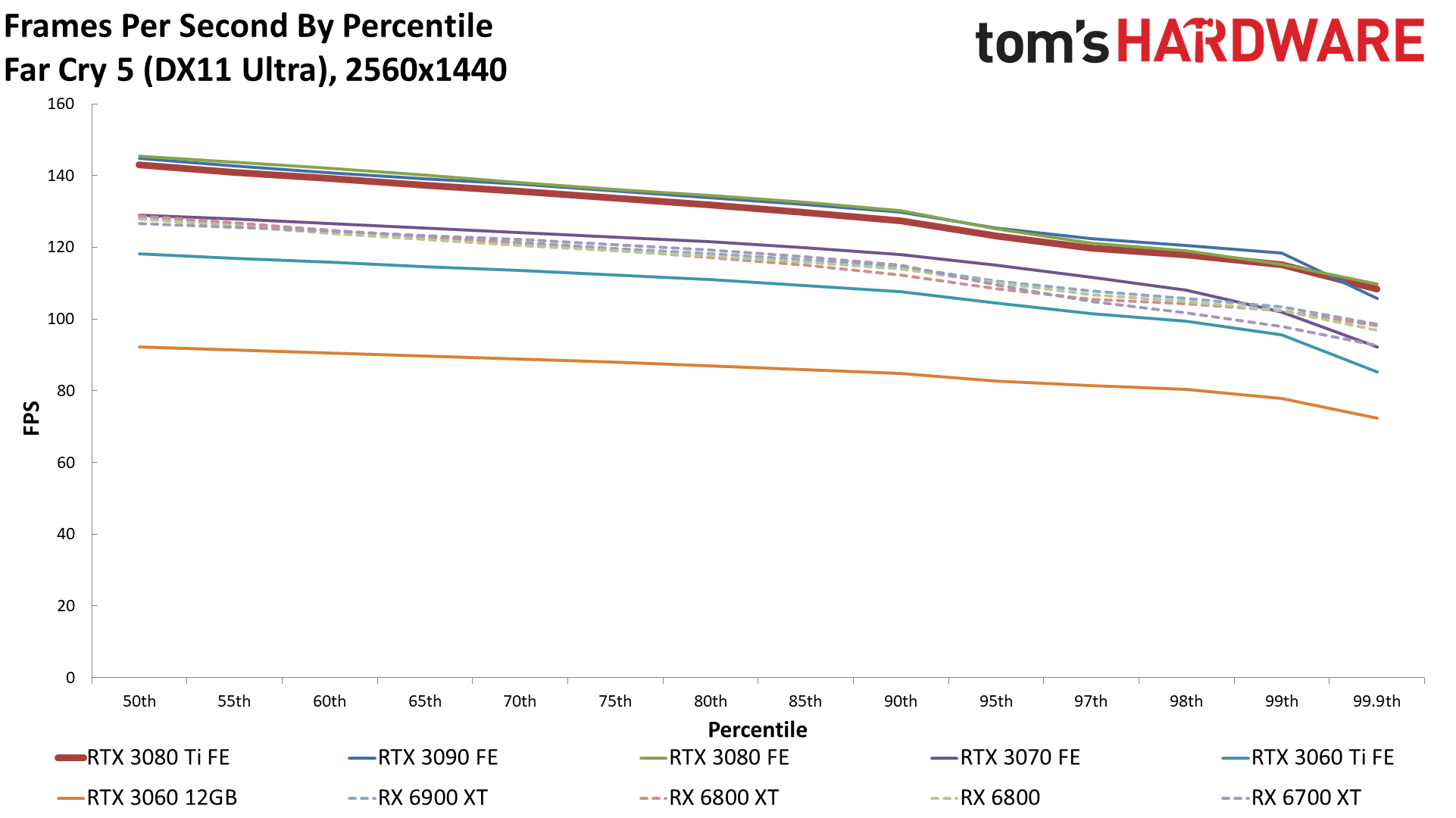
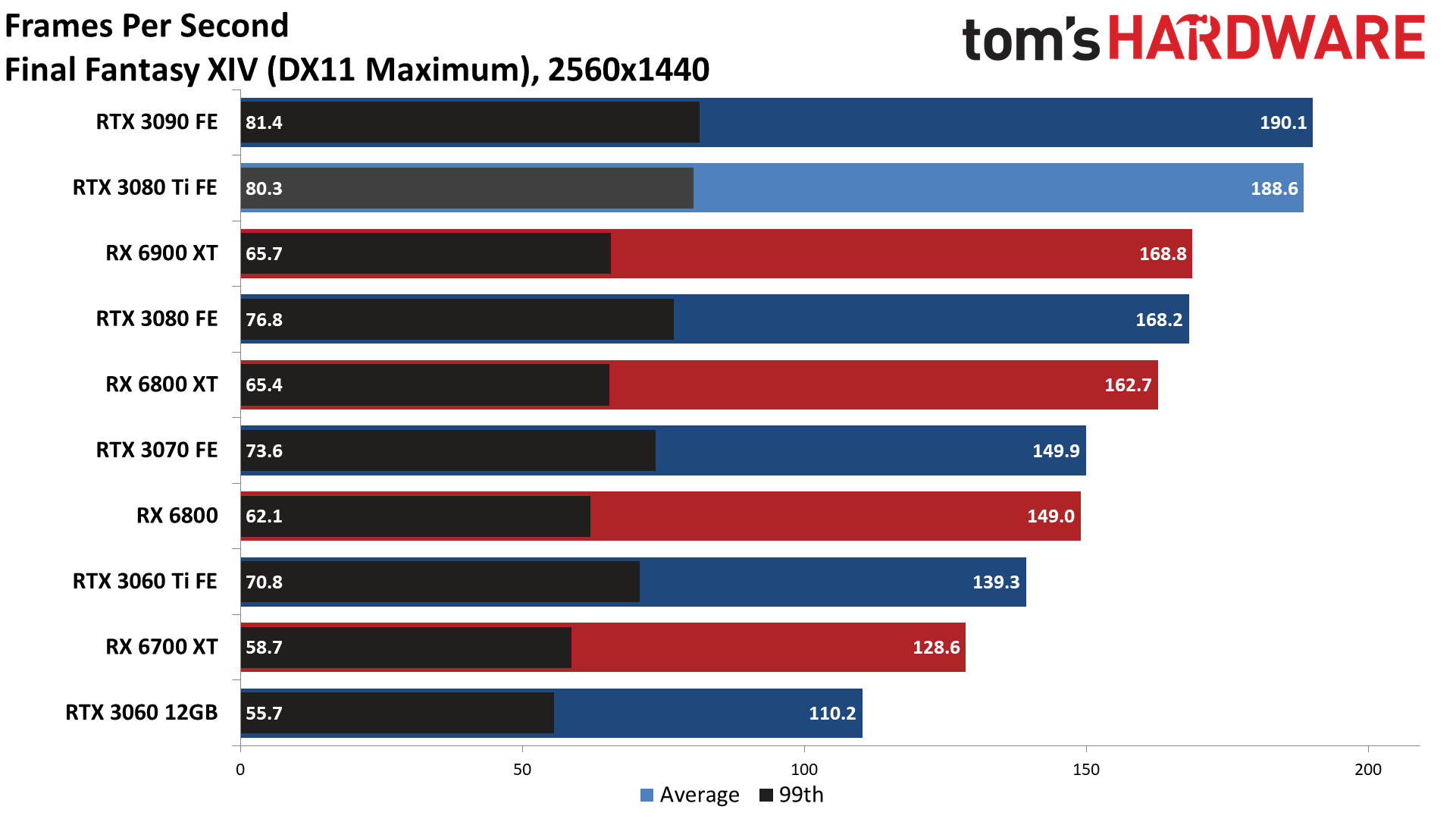
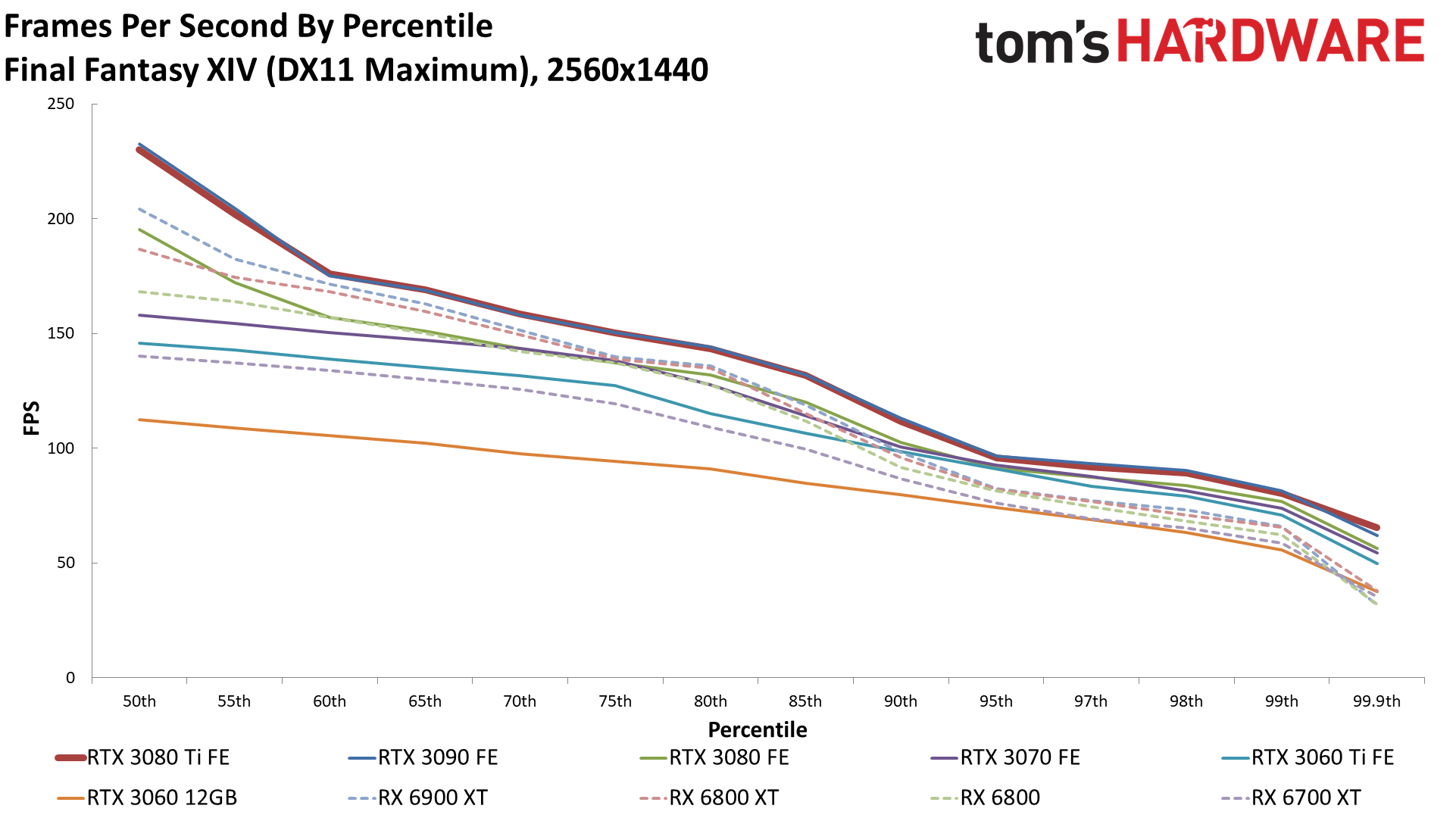
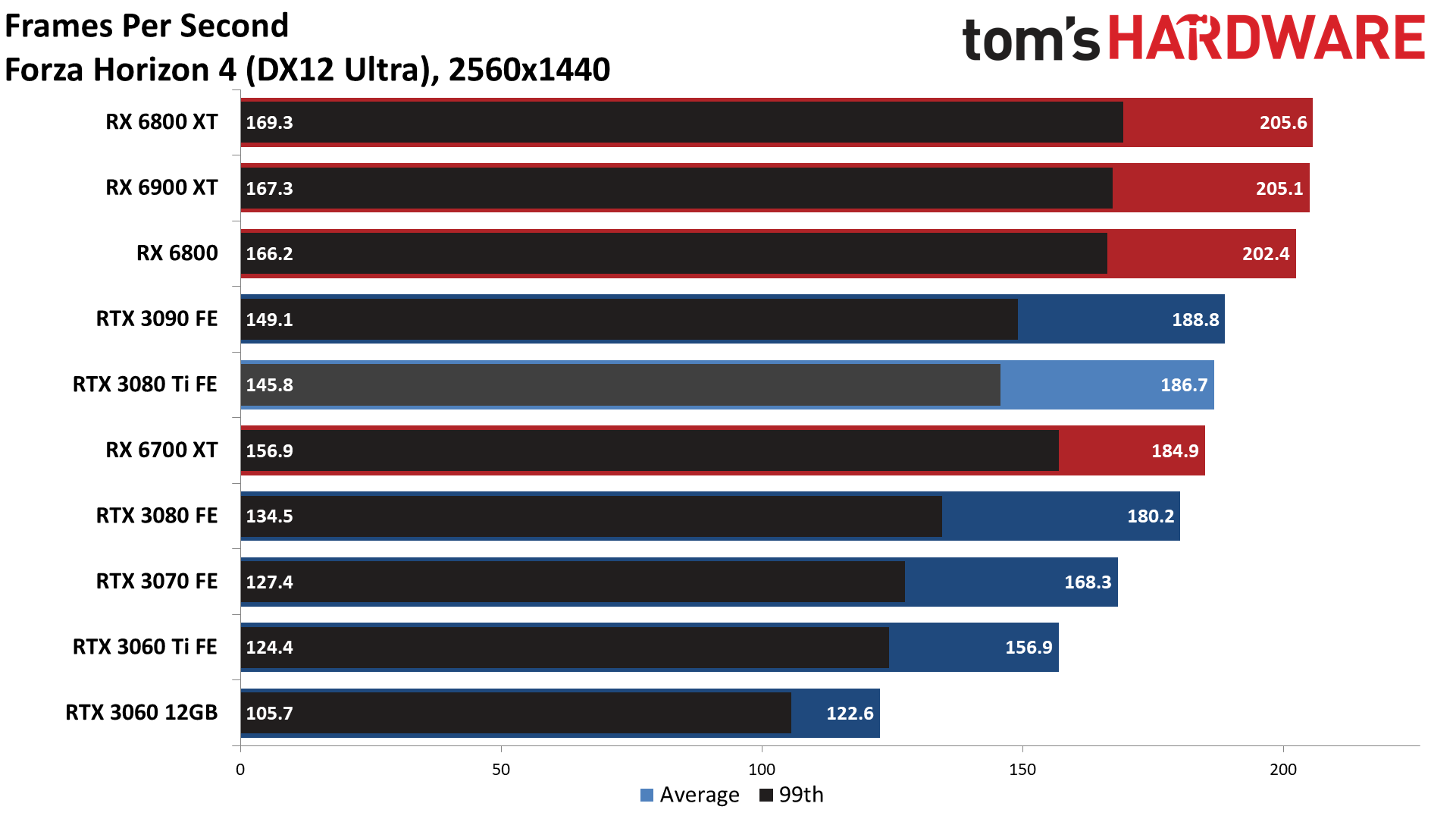
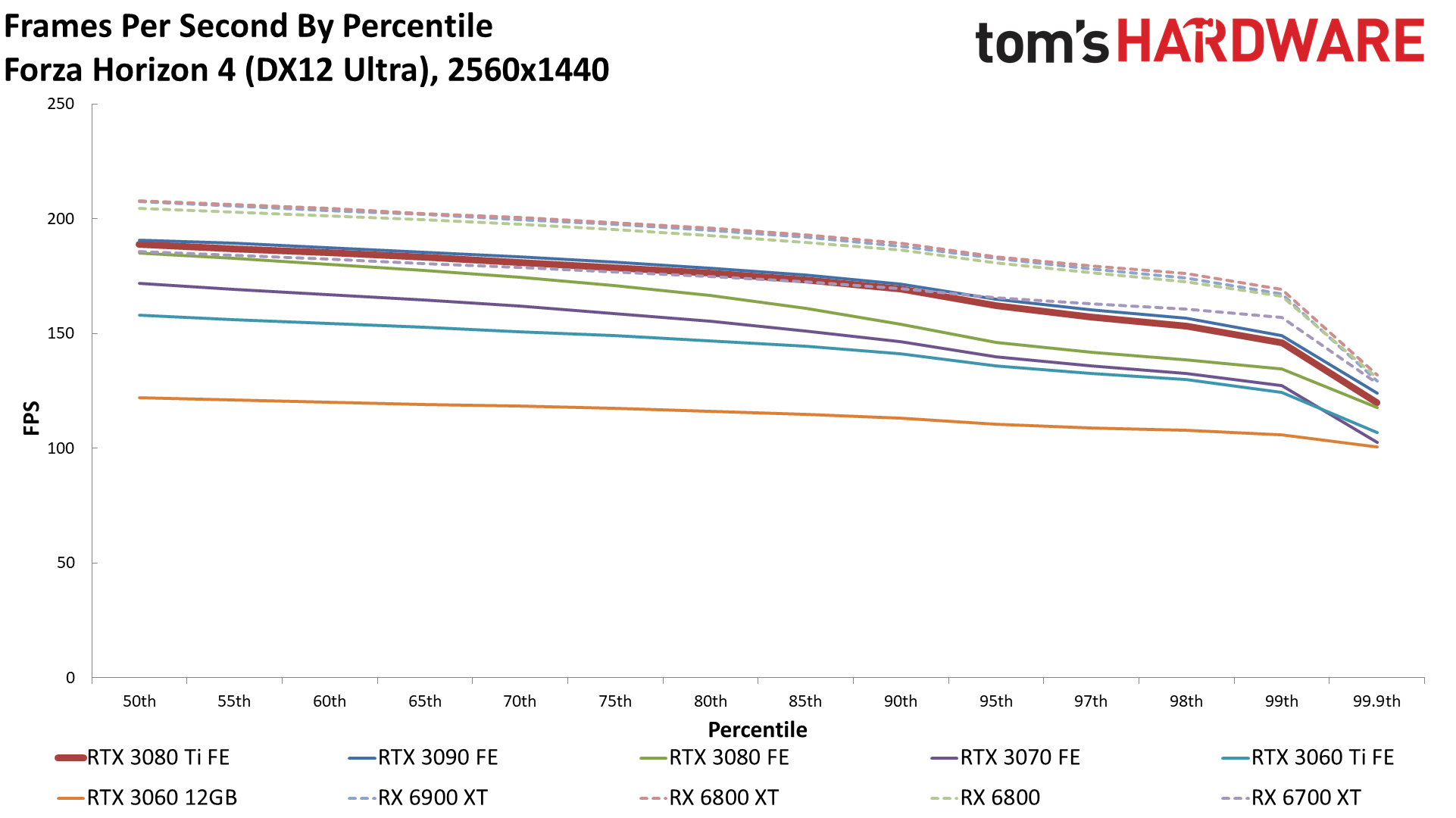


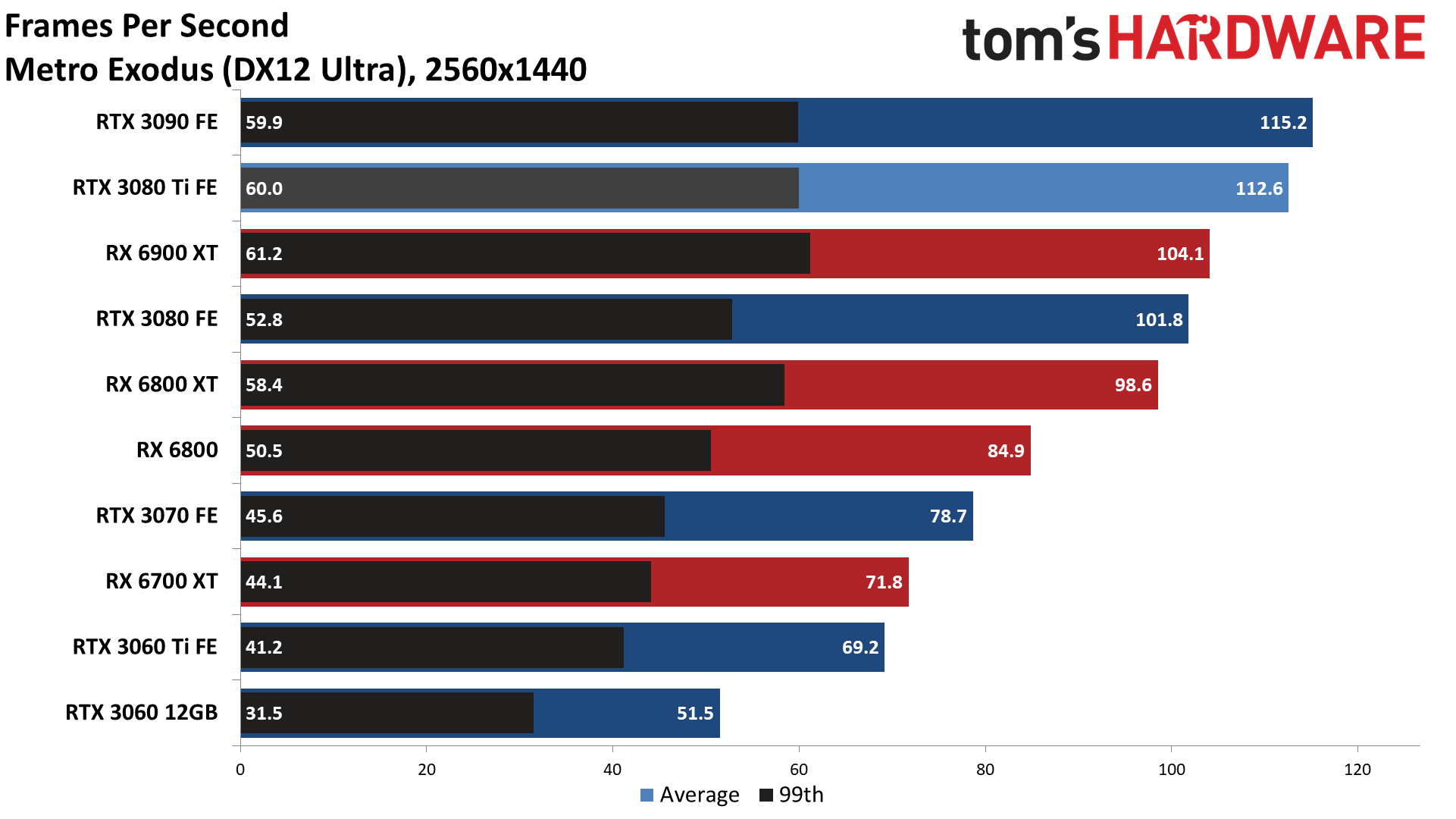

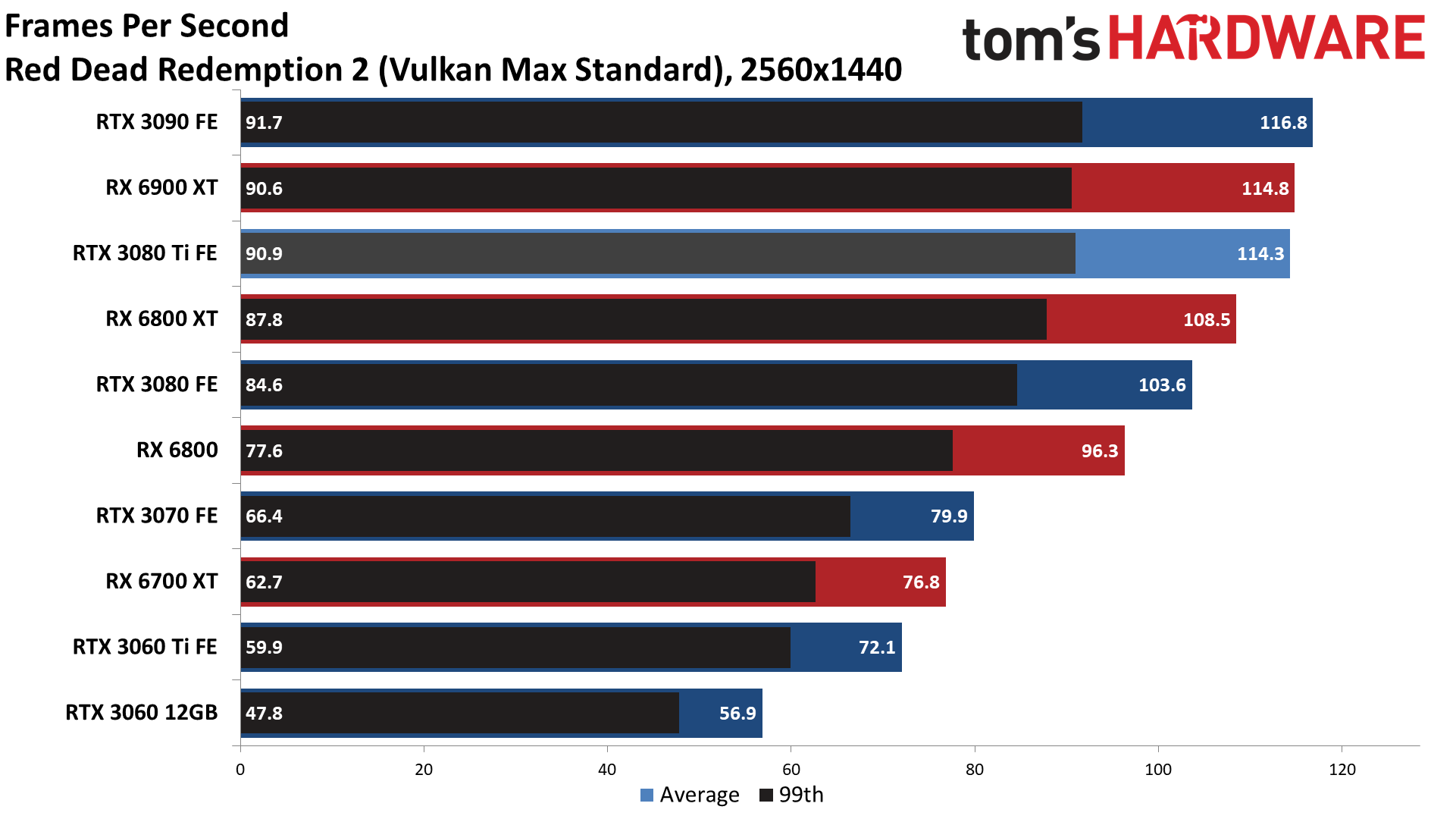
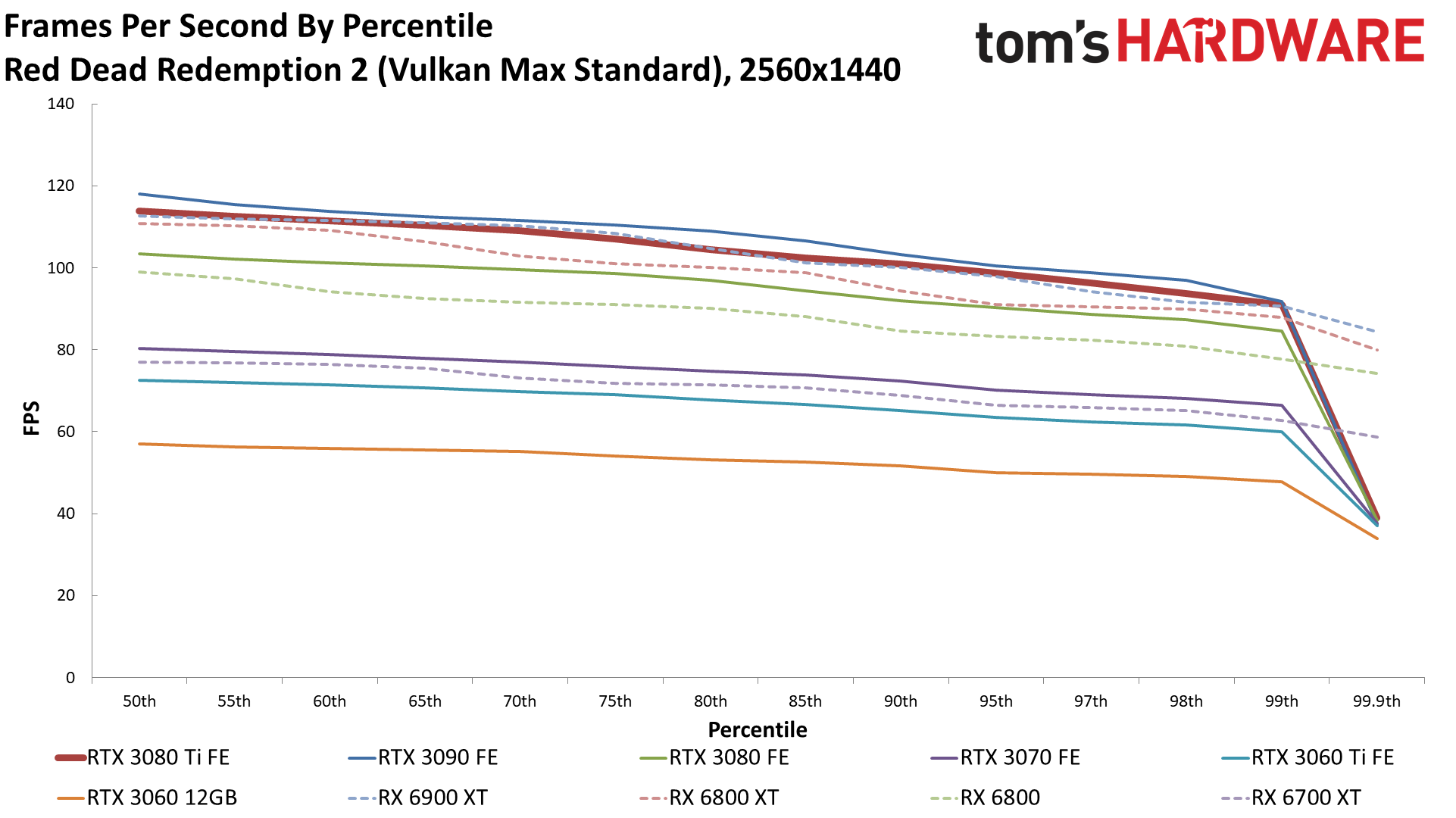


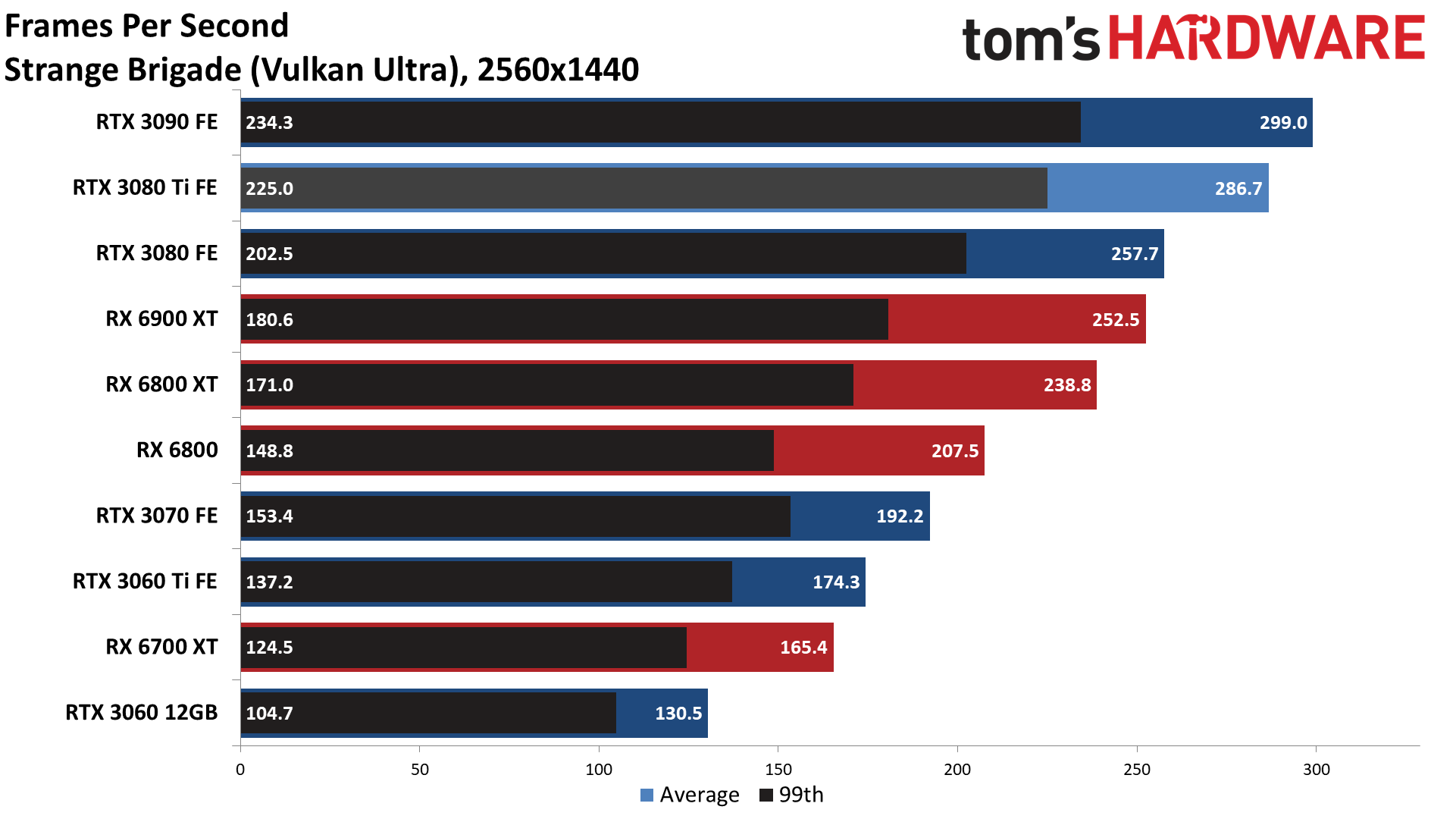
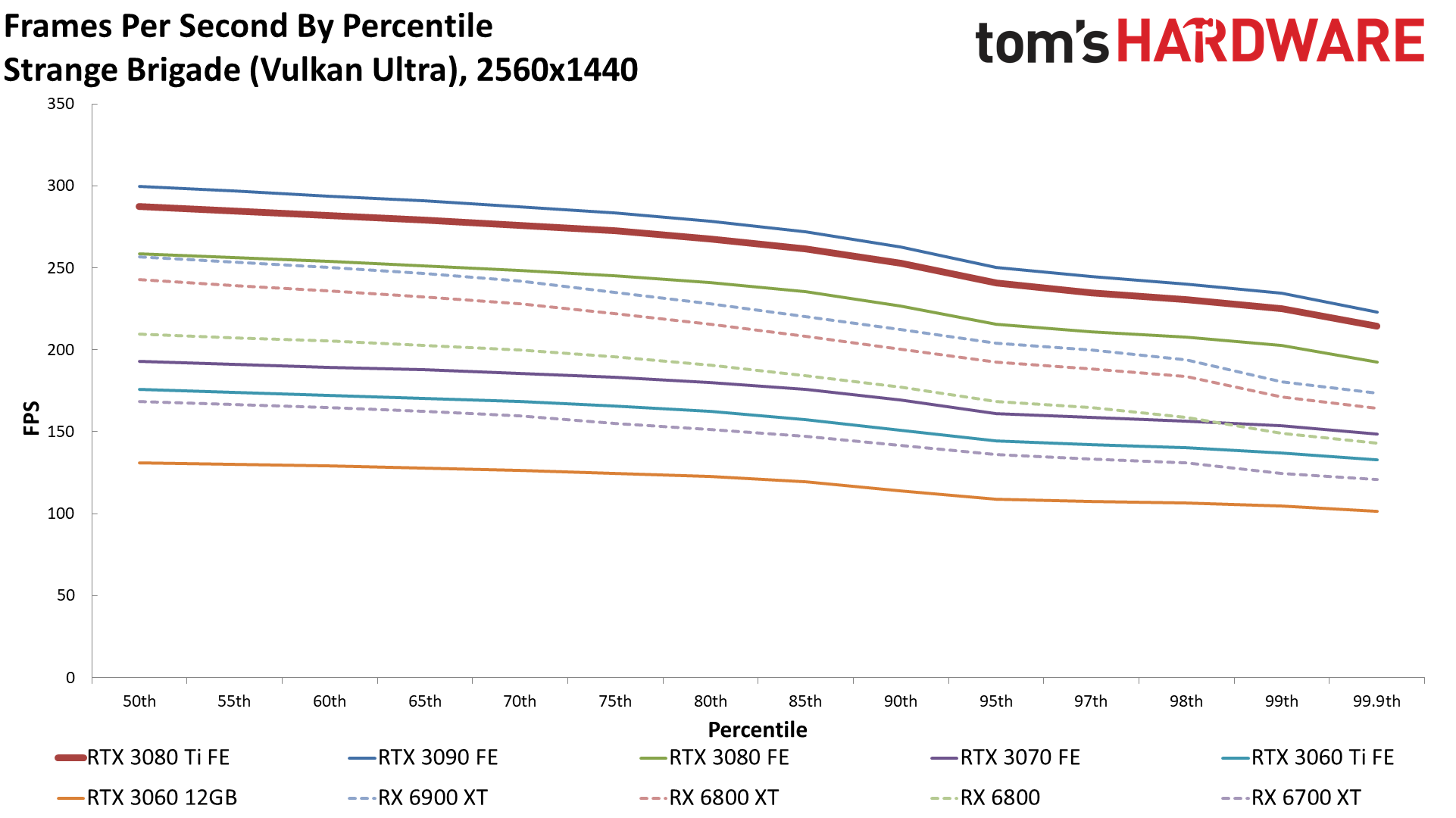
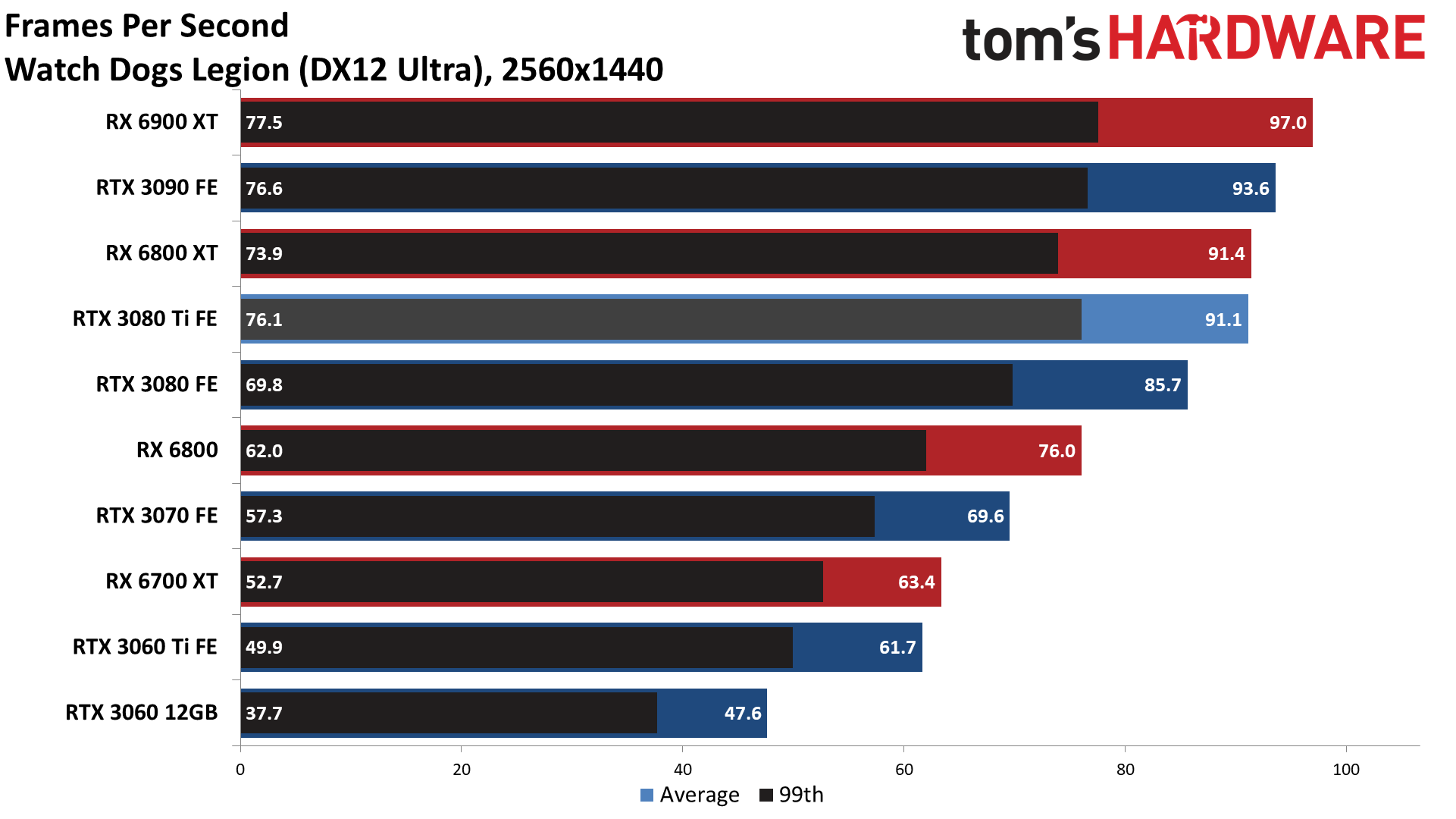
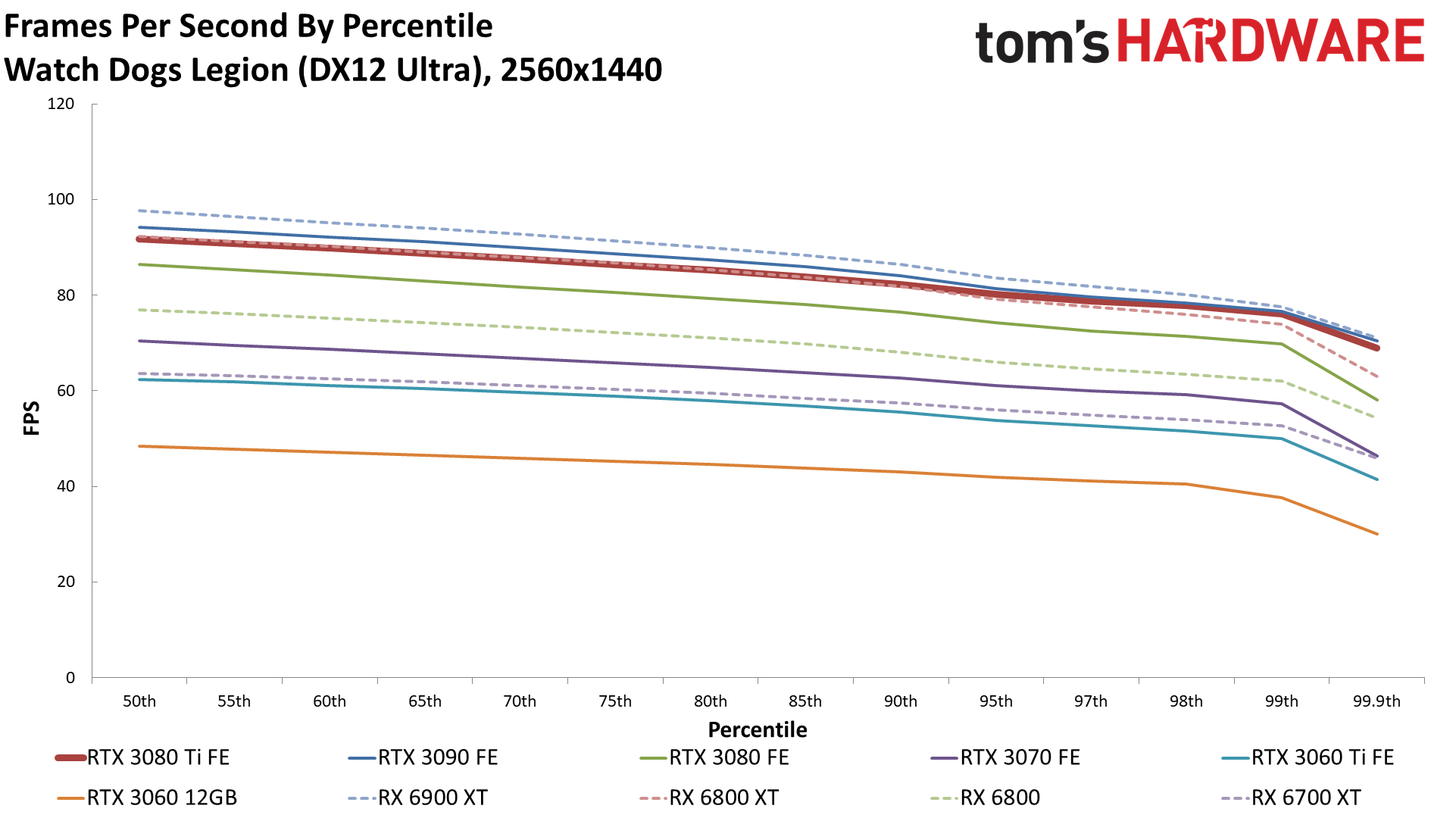
Dropping down to 1440p, the gaps between the fastest cards narrow slightly, and AMD's Infinity Cache starts to play a bigger role. Where the RTX 3080 Ti placed second overall at 4K, just behind the 3090, it now drops behind the RX 6900 XT and lands in third place, with the RX 6800 XT nipping at its heels.
Assuming any of these GPUs were even available at MSRP, AMD makes a very strong case for its RDNA2 cards. Considering the 3080 already costs more (on eBay) than the 6900 XT, the 3080 Ti will likely be even worse — though the limited Ethereum mining performance might affect eBay prices.
The individual games tell a similar story as above, but AMD has even more wins relative to Nvidia. Valhalla remains the major outlier, with its optimized-for-AMD performance, but Borderlands 3, Forza Horizon 4, and Horizon Zero Dawn all put the RX 6800 XT ahead of the 3080 Ti. Nvidia counters with significant wins in The Division 2, Final Fantasy XIV, Metro Exodus, Red Dead Redemption 2, and Strange Brigade — with the remaining games being basically tied.
Get Tom's Hardware's best news and in-depth reviews, straight to your inbox.

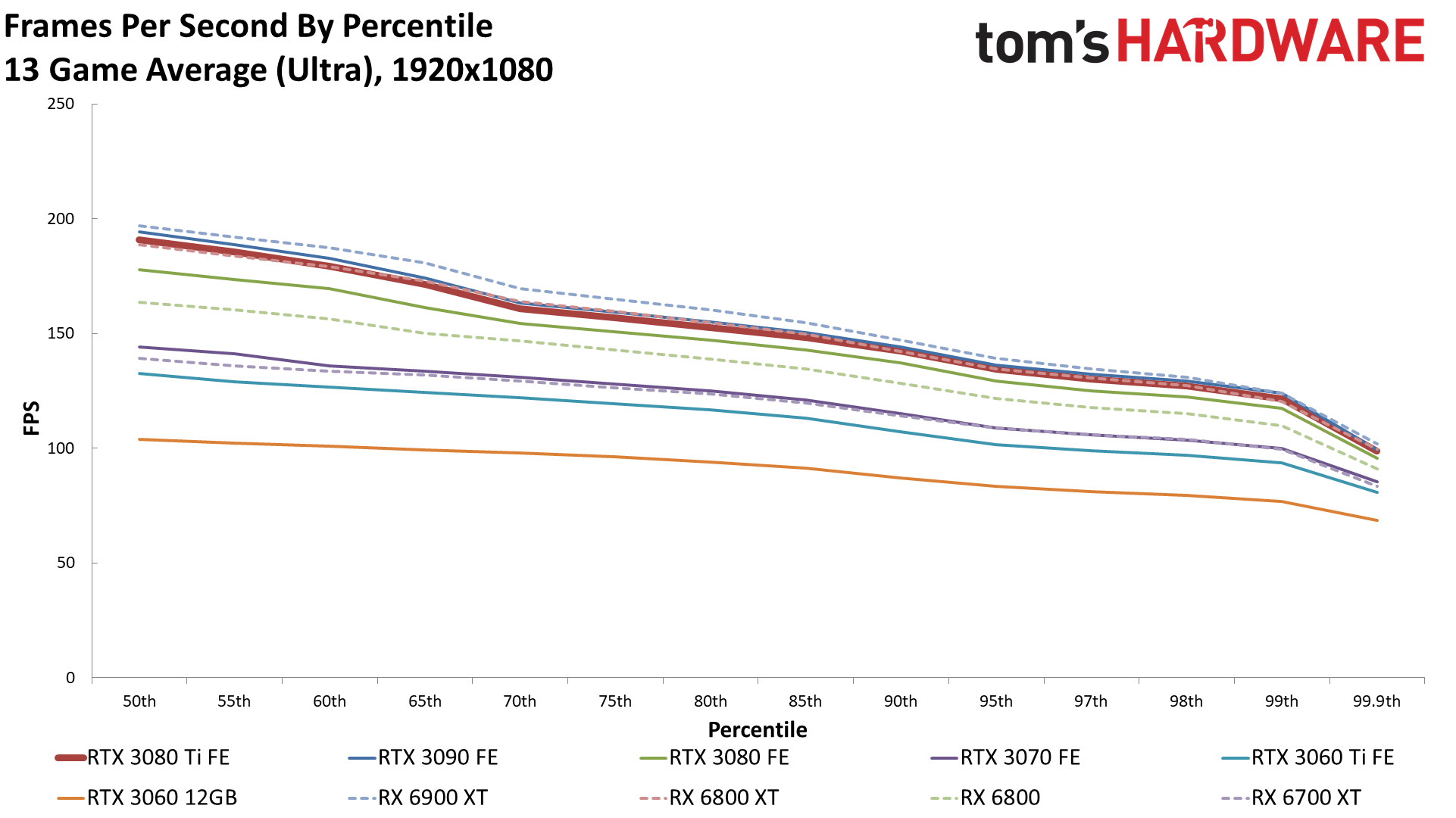
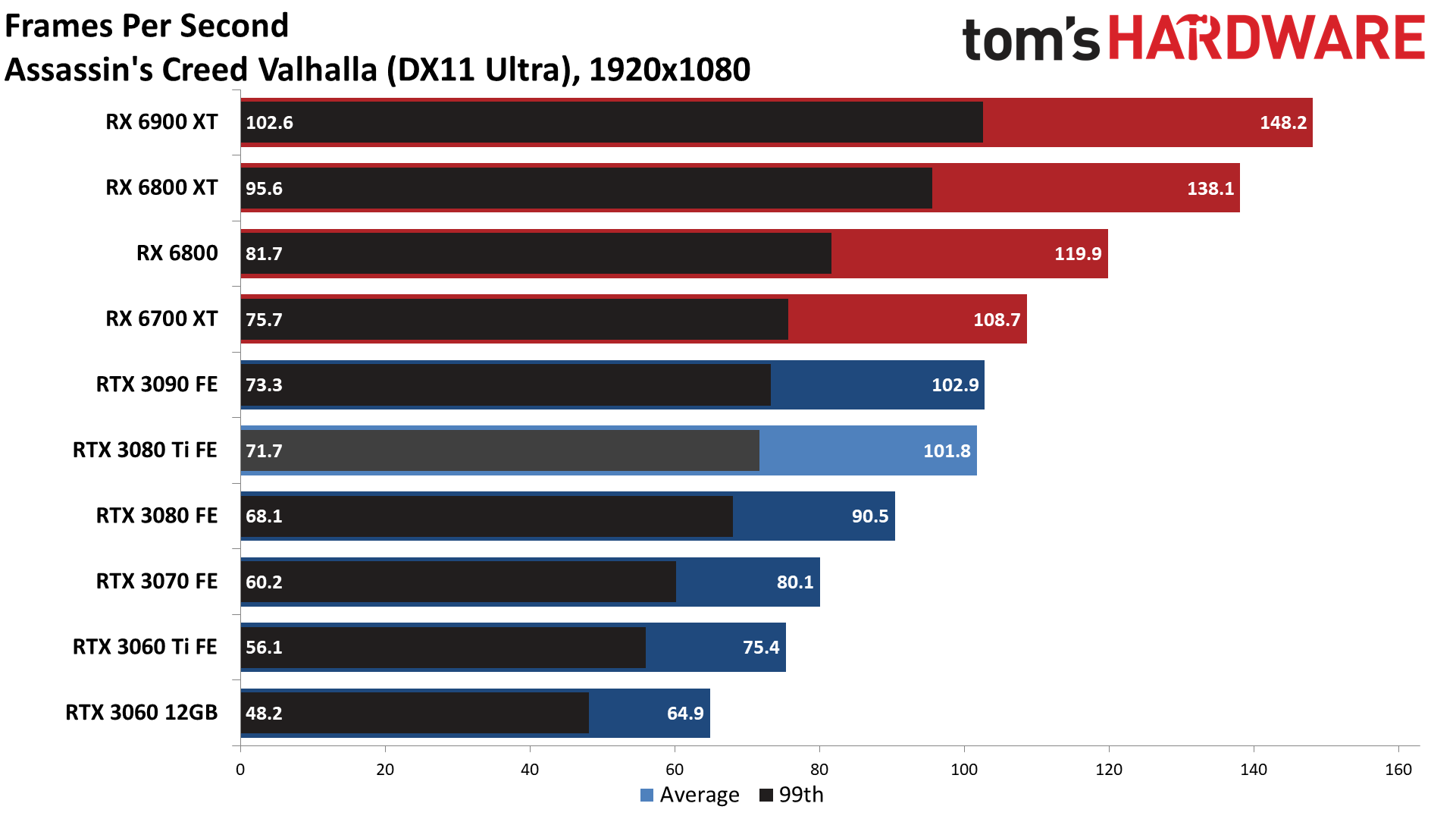
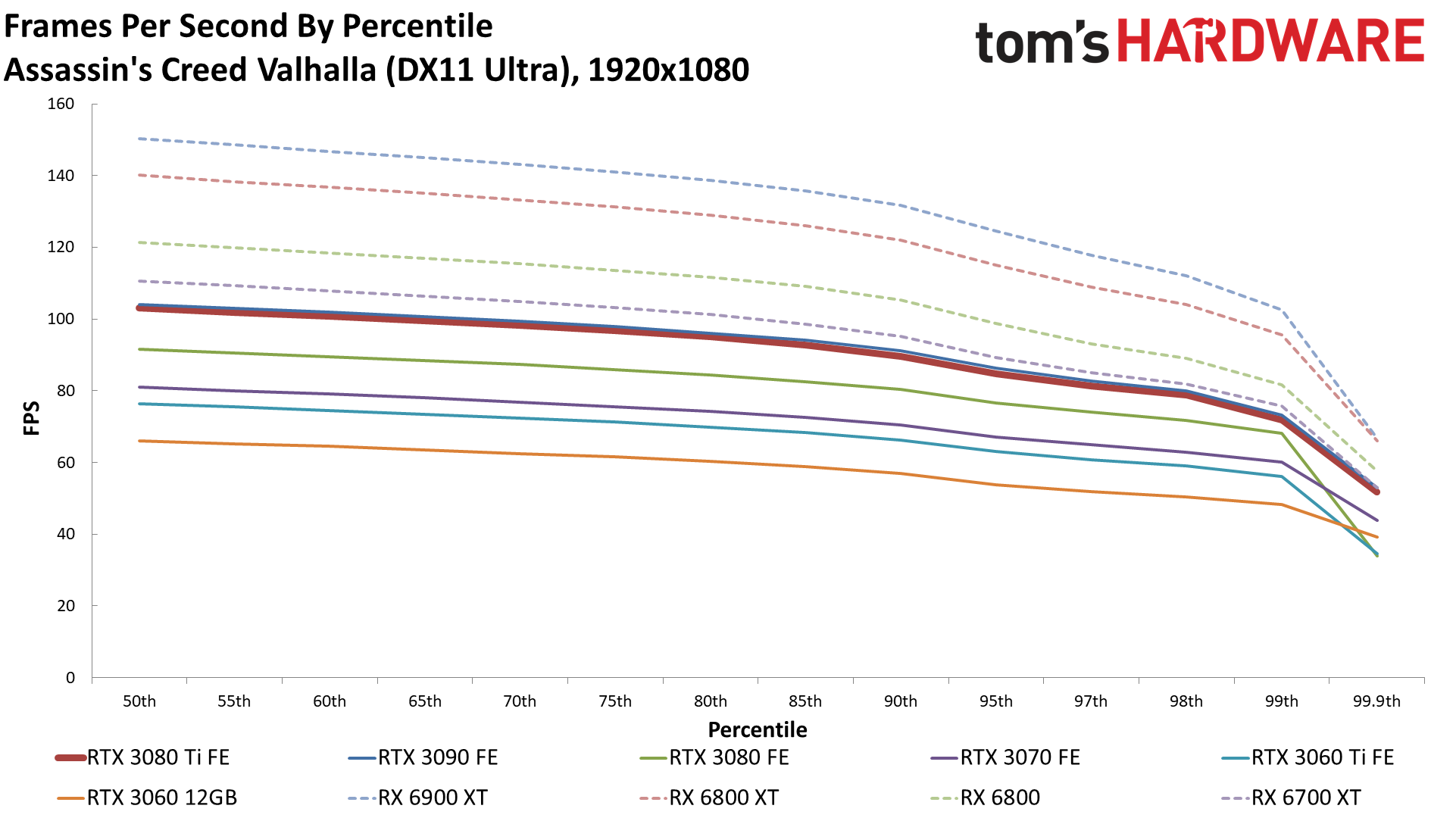




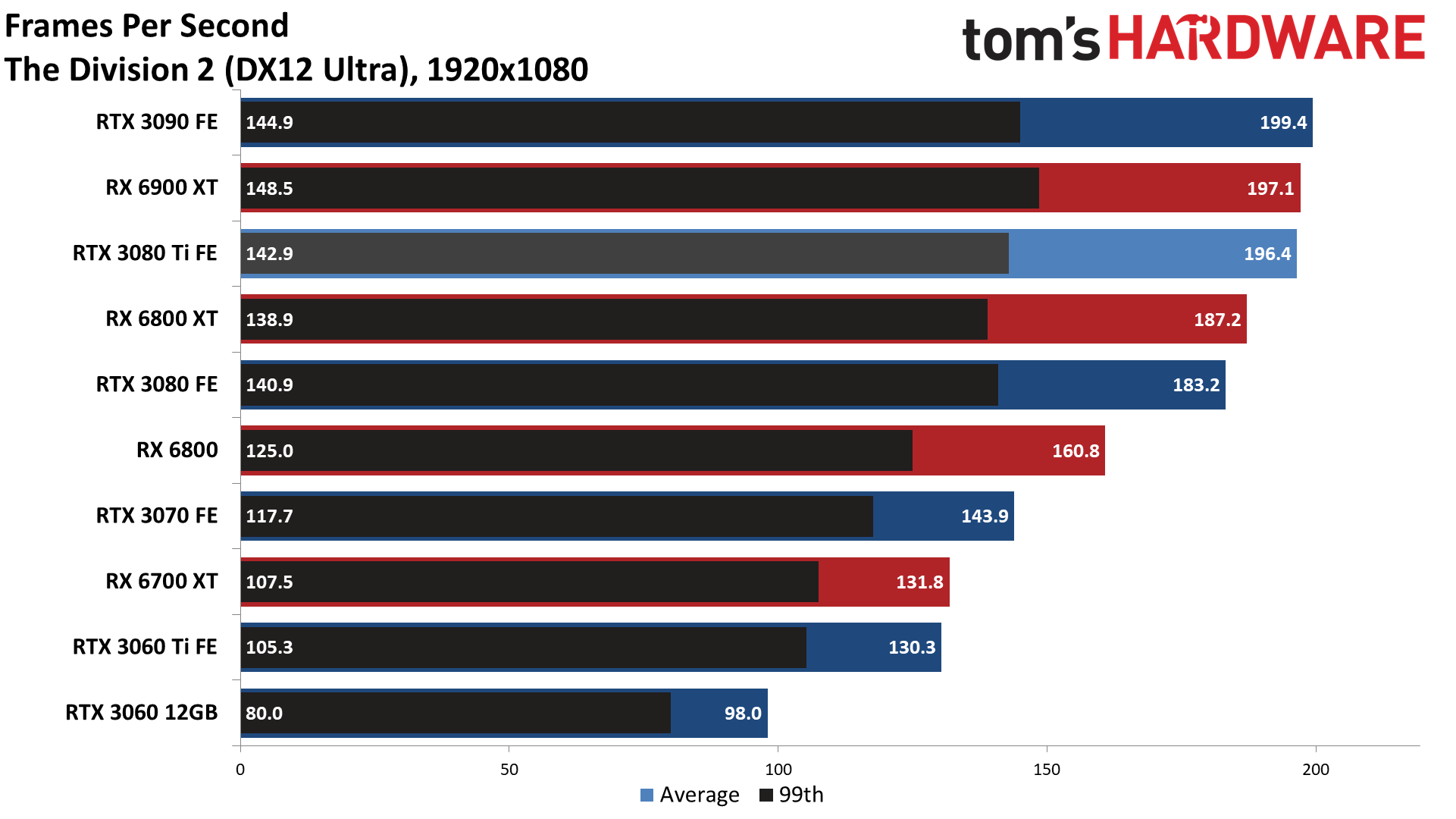
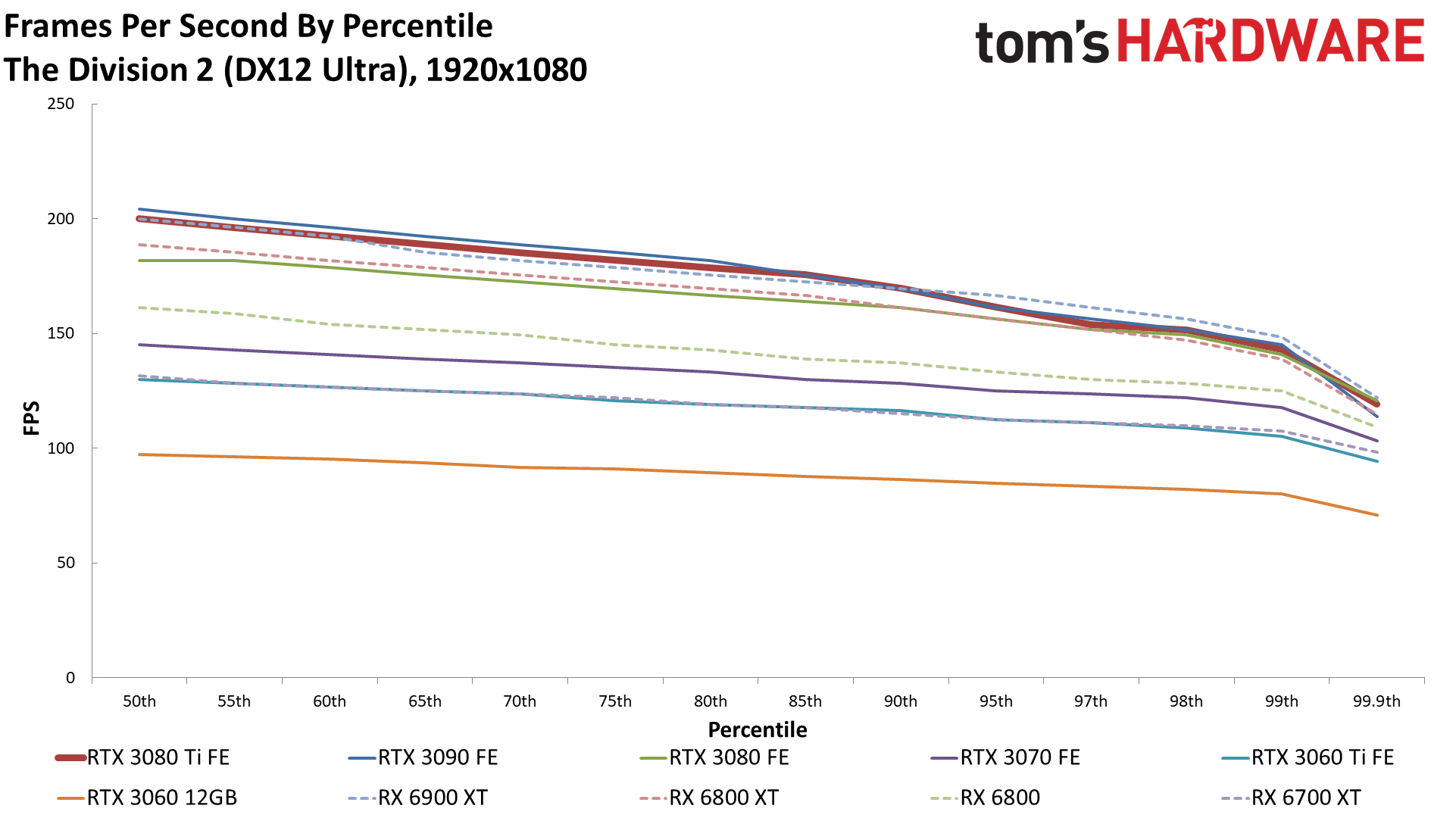


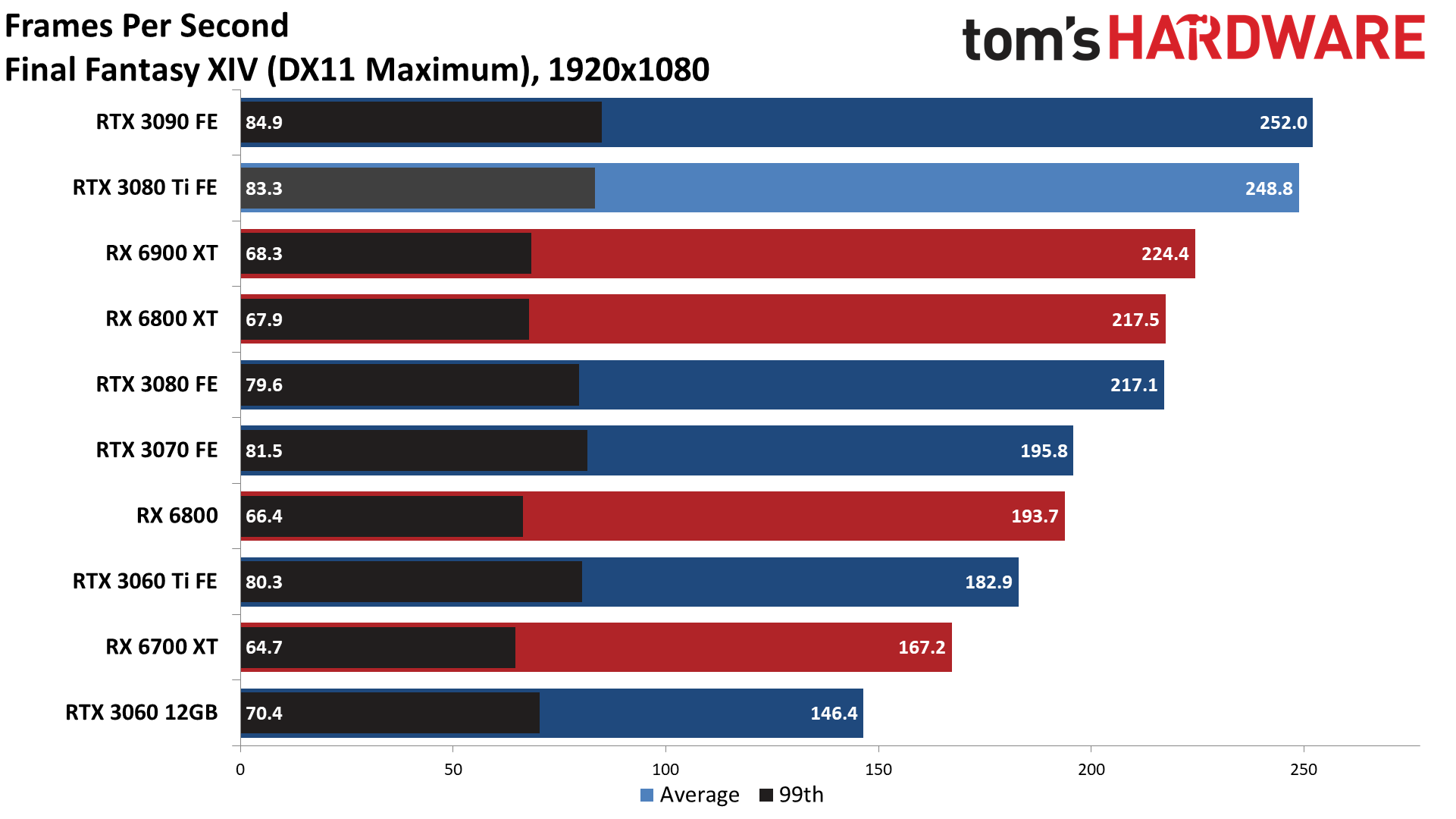
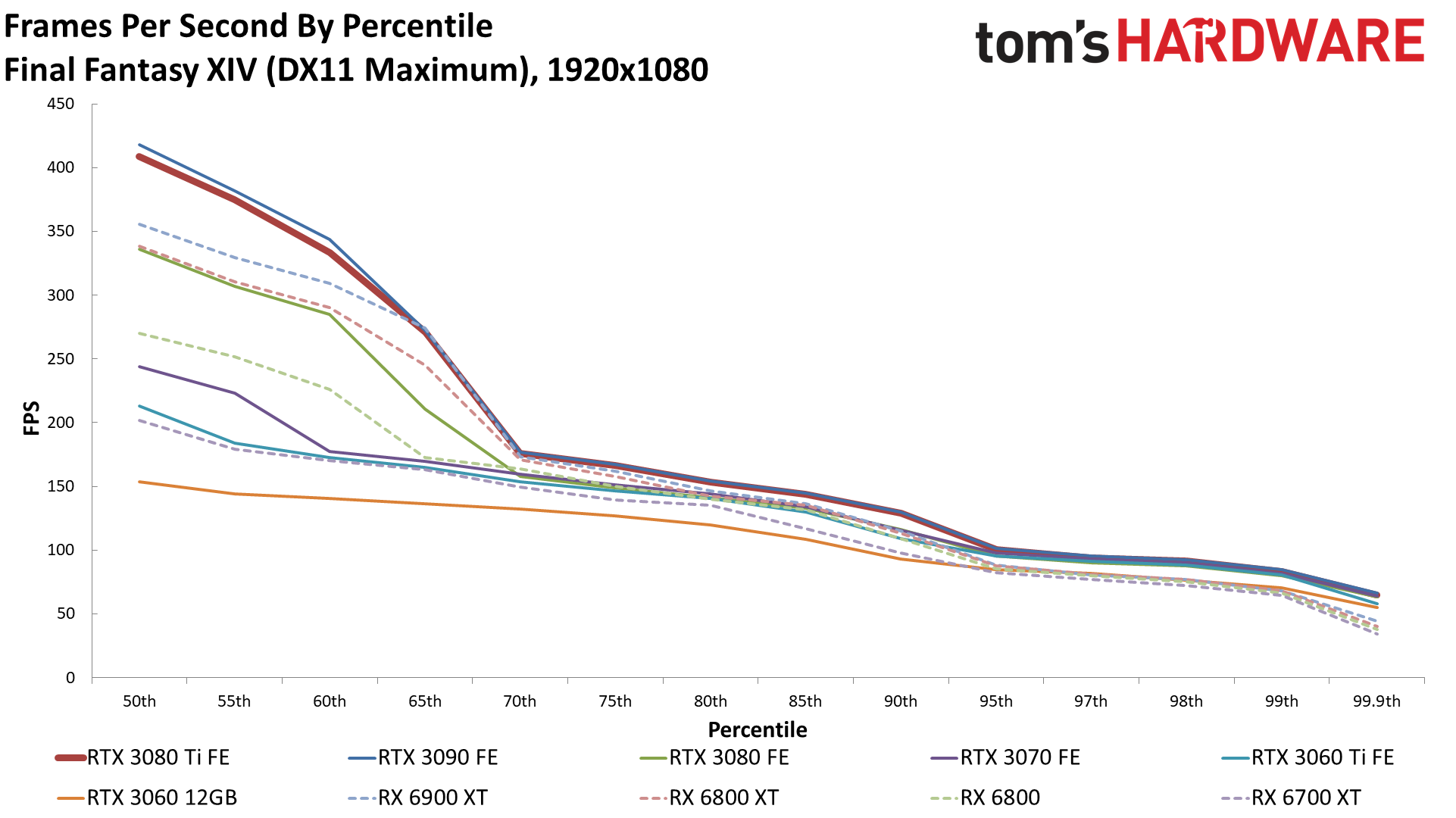




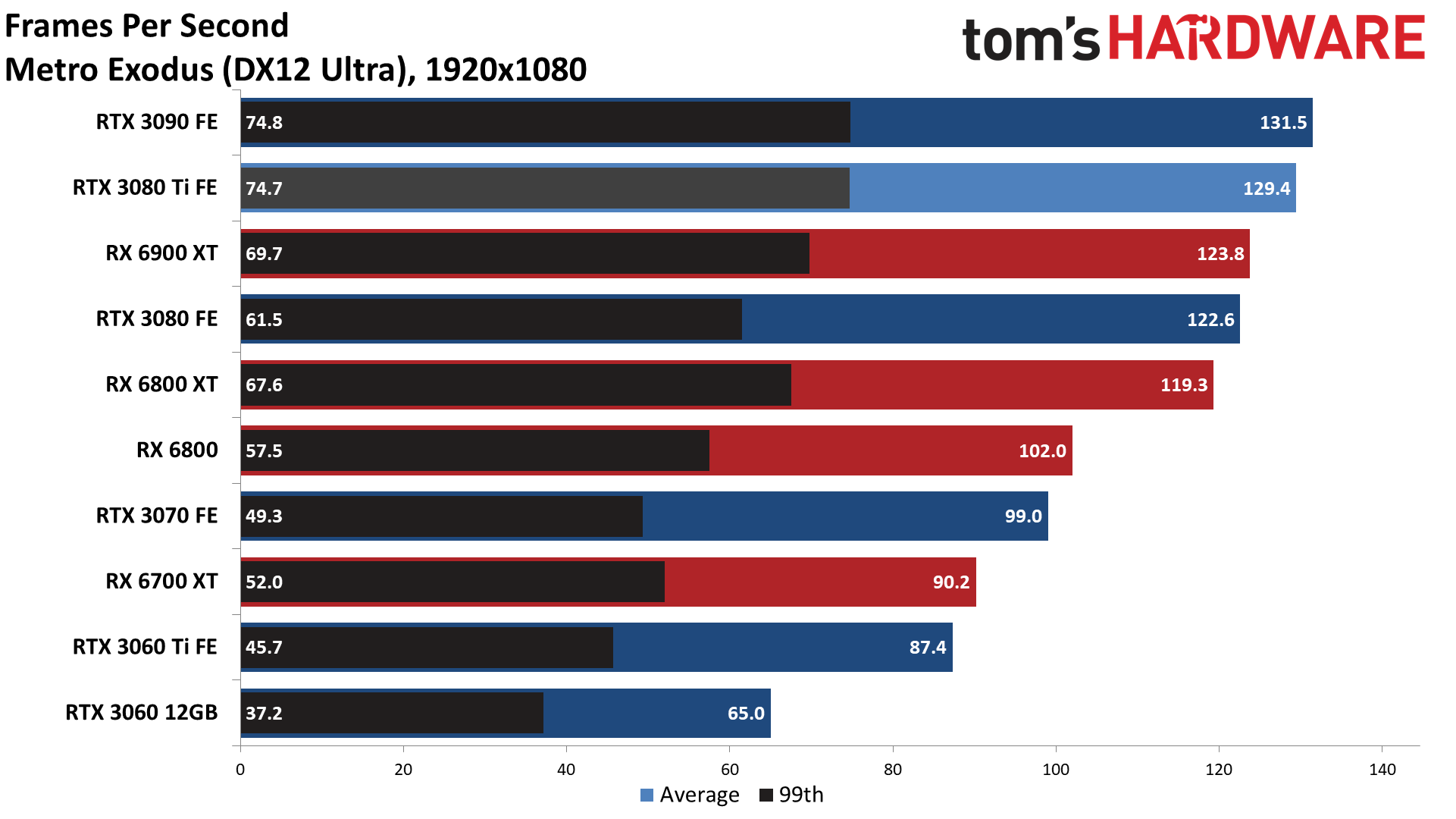
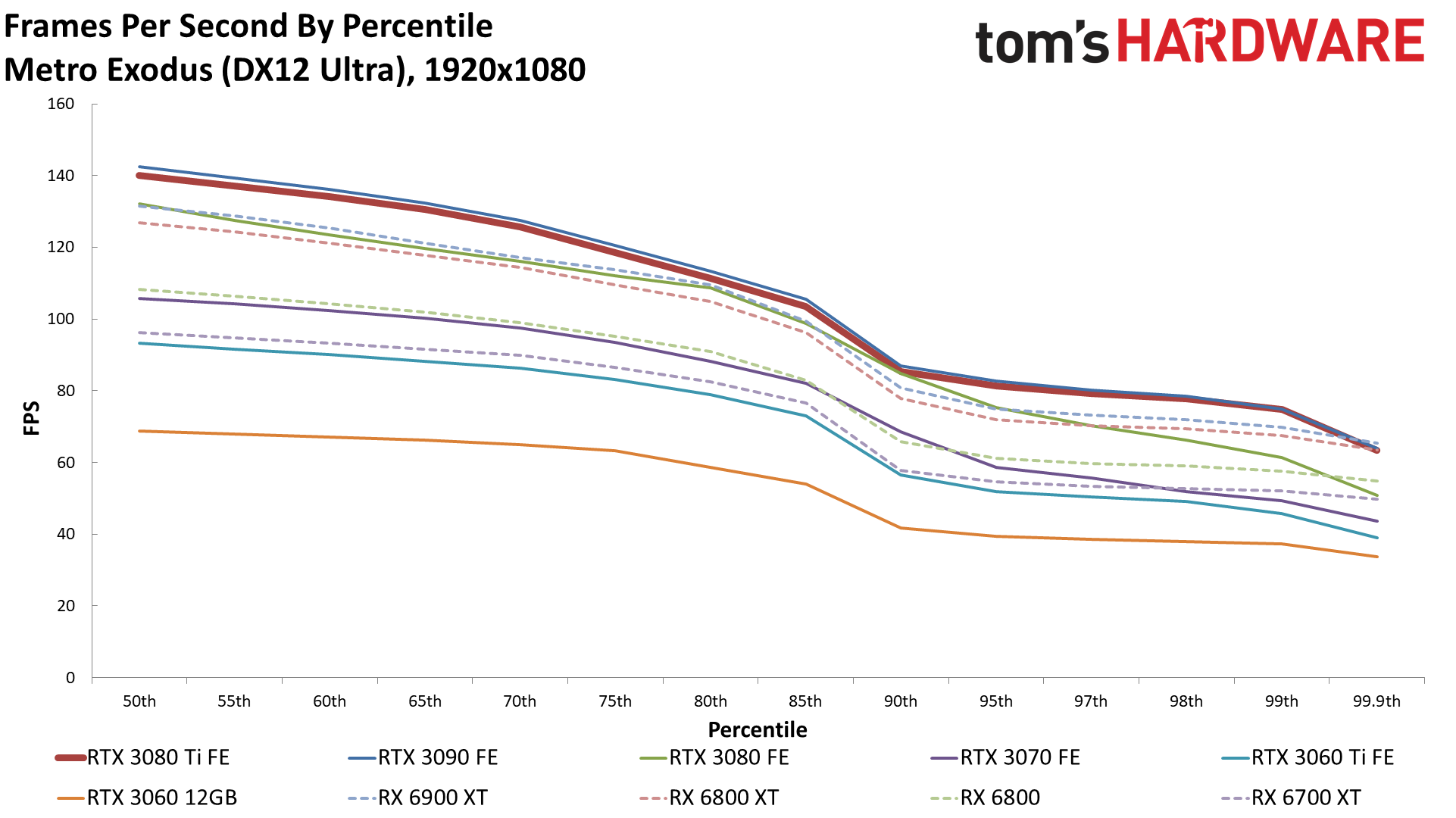

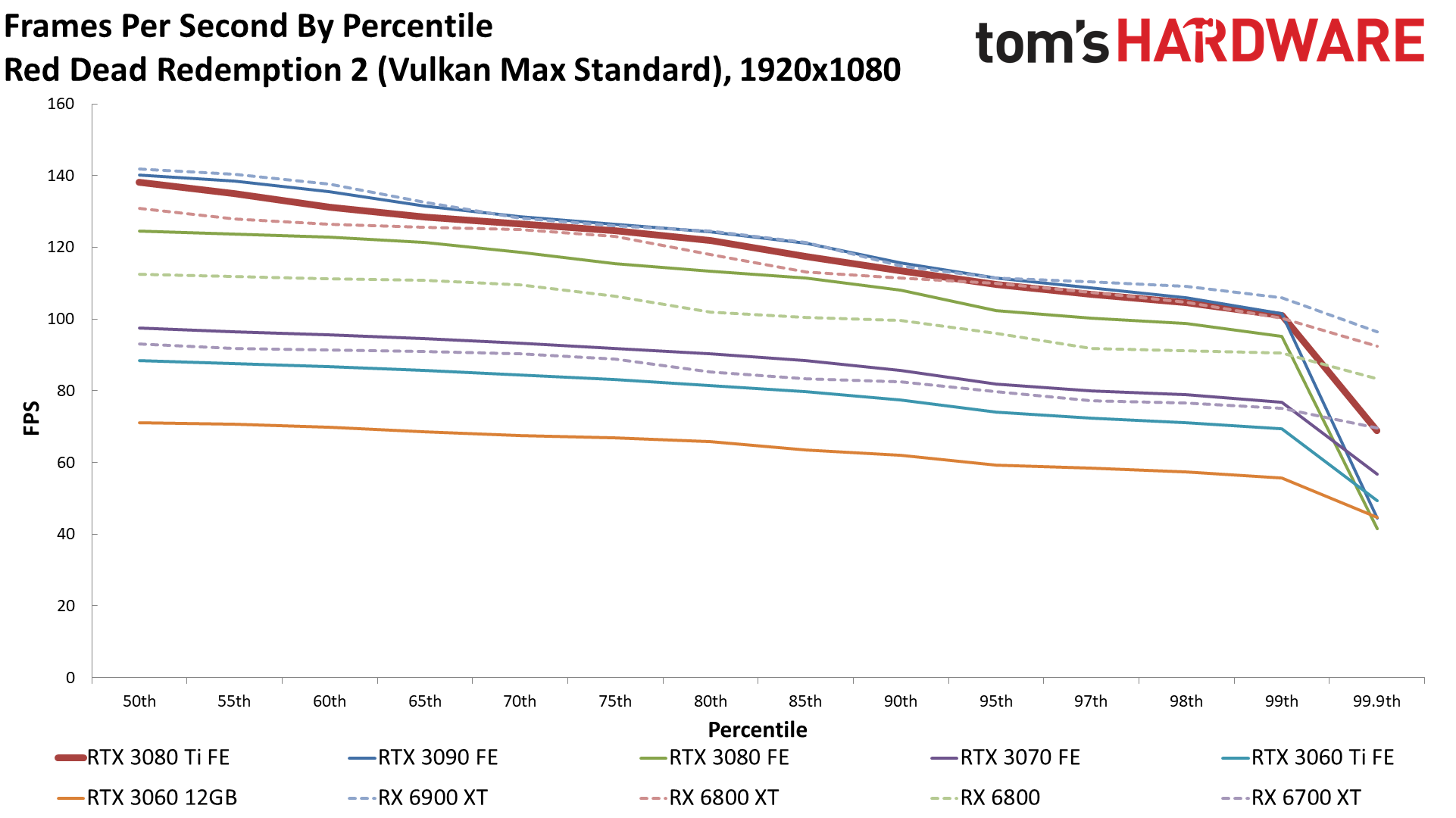
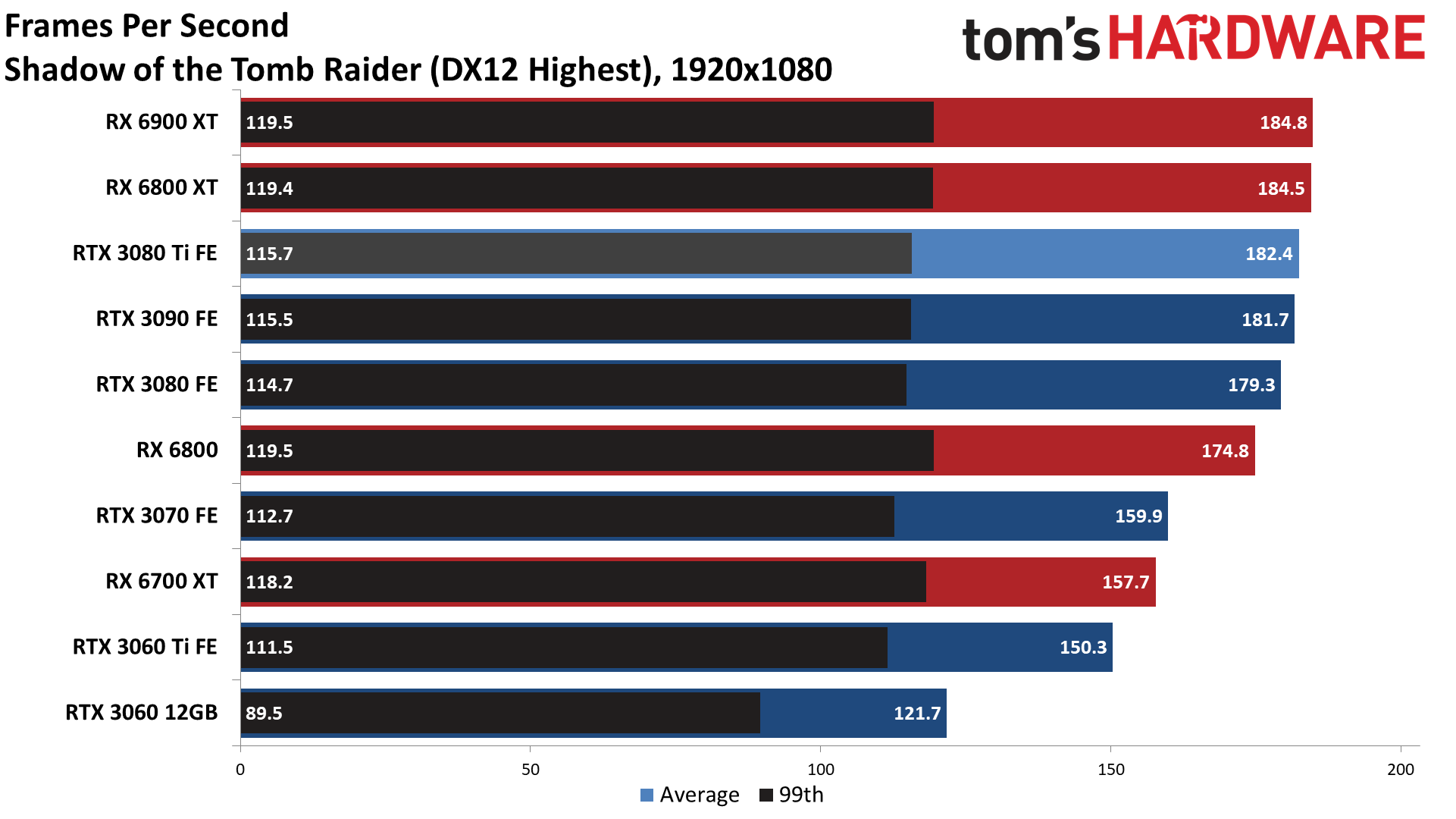




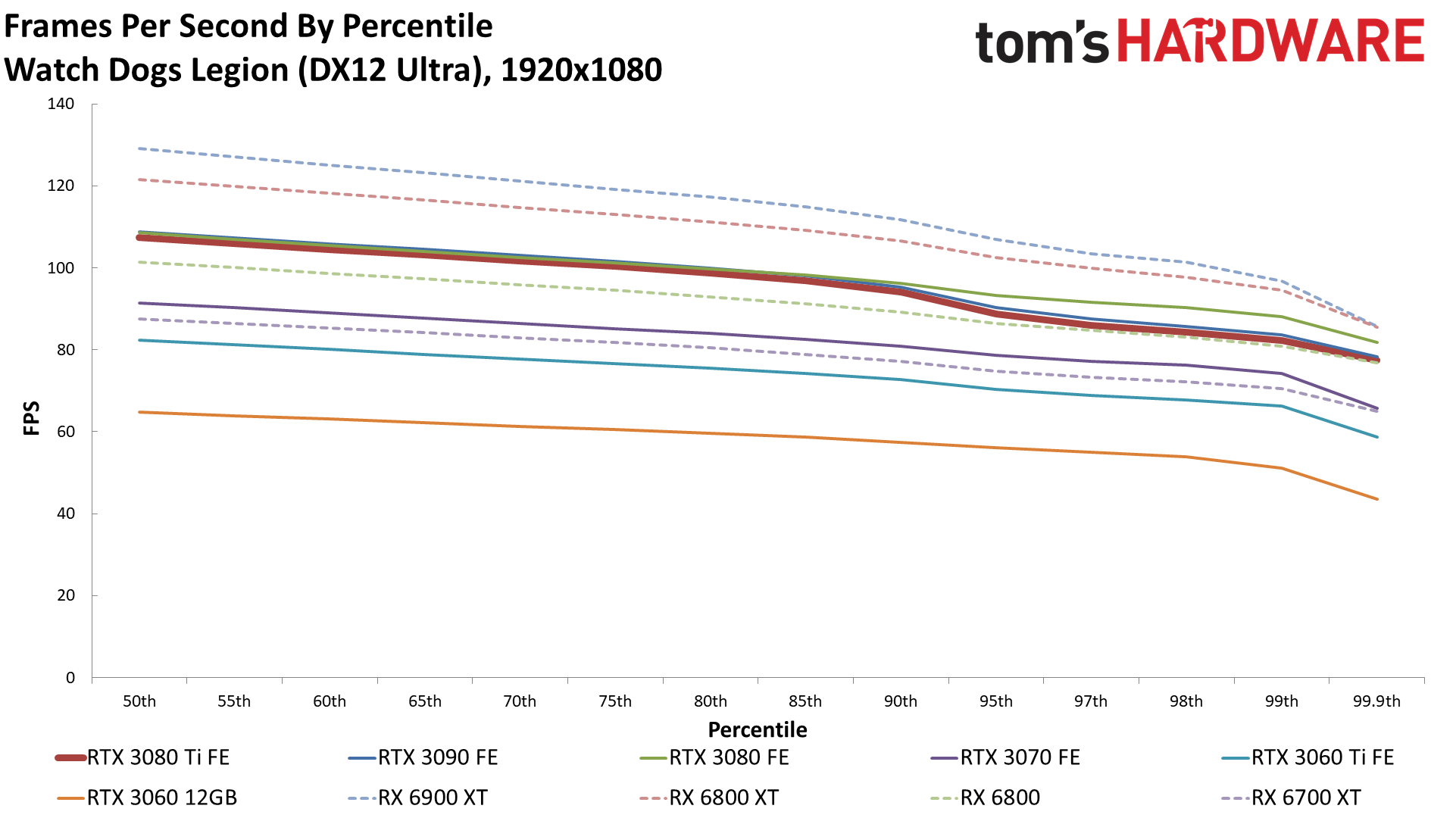
Remember when we said that buying a card like this for 1080p gaming was overkill? This is what we were talking about. The top five cards are relatively tightly packed, partly due to CPU bottlenecks, with AMD's RX 6900 XT now sitting in the pole position, followed by the RTX 3090, RX 6800 XT, and RTX 3080 Ti, and RTX 3080. If you're after ultra-high framerates (e.g., on a 1080p 360Hz monitor), you'll definitely want to get the fastest CPU for gaming possible — possibly the Core i9-11900K if you can handle the power and cooling, though the Ryzen 9 5900X is arguably the better pick overall.
The rather questionable results in certain AMD promoted games — particularly Assassin's Creed Valhalla — become even more apparent. That game either really loves AMD's Infinity Cache, or contains heavy AMD optimizations, or both, as its 45% lead for the 6900 XT over the 3080 Ti is an extreme outlier. The Infinity Cache definitely helps at 1080p more than higher resolutions, however, and AMD's cards have a strong showing in general. Of course, everything from the RX 6800 and up averages more than 144 fps in our test suite at 1080p, which frankly should satisfy all but the most demanding esports competitors.
GeForce RTX 3080 Ti: Ray Tracing and DLSS Gaming Performance
So far, we've focused on gaming performance using traditional rasterization graphics. We've also excluded using Nvidia's DLSS technology in order to provide an apples-to-apples comparison. Let's change things up for a moment and look at ray tracing performance, with and without DLSS 2.0, where applicable. We're only showing DLSS results on the 3080 Ti, and we used the Quality mode (2x upscaling) in the six games where it was supported. AMD's FSR will provide an alternative to DLSS in the coming months, though we don't yet have hands-on experience with it, so we can't comment on the image quality. We'll also confine testing to 1440p and 1080p here since native 4K with ray tracing tends to push even the fastest GPUs beyond their reasonable limits. This is the same testing we used in our recent AMD vs. Nvidia Ray Tracing Battle.
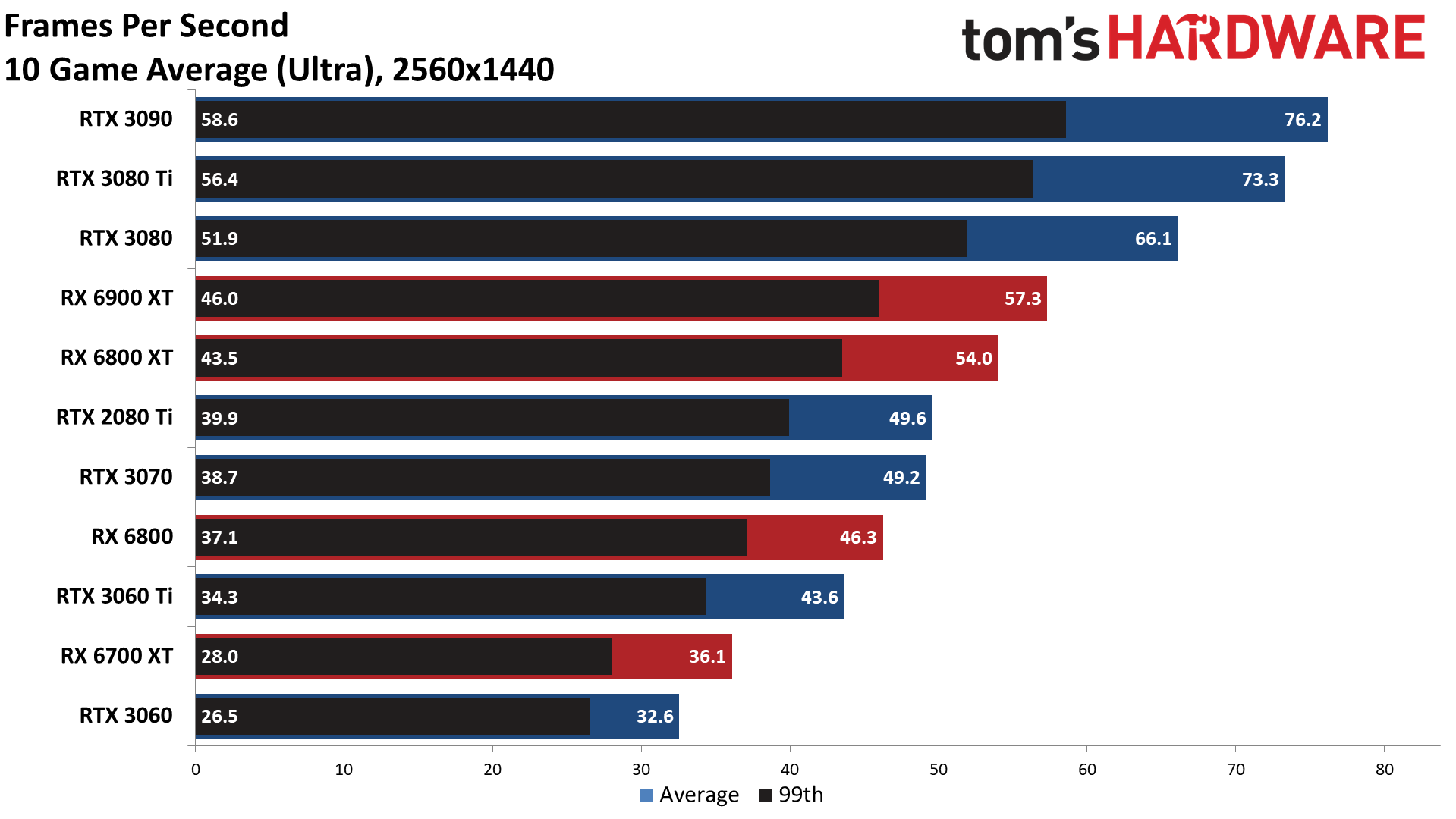
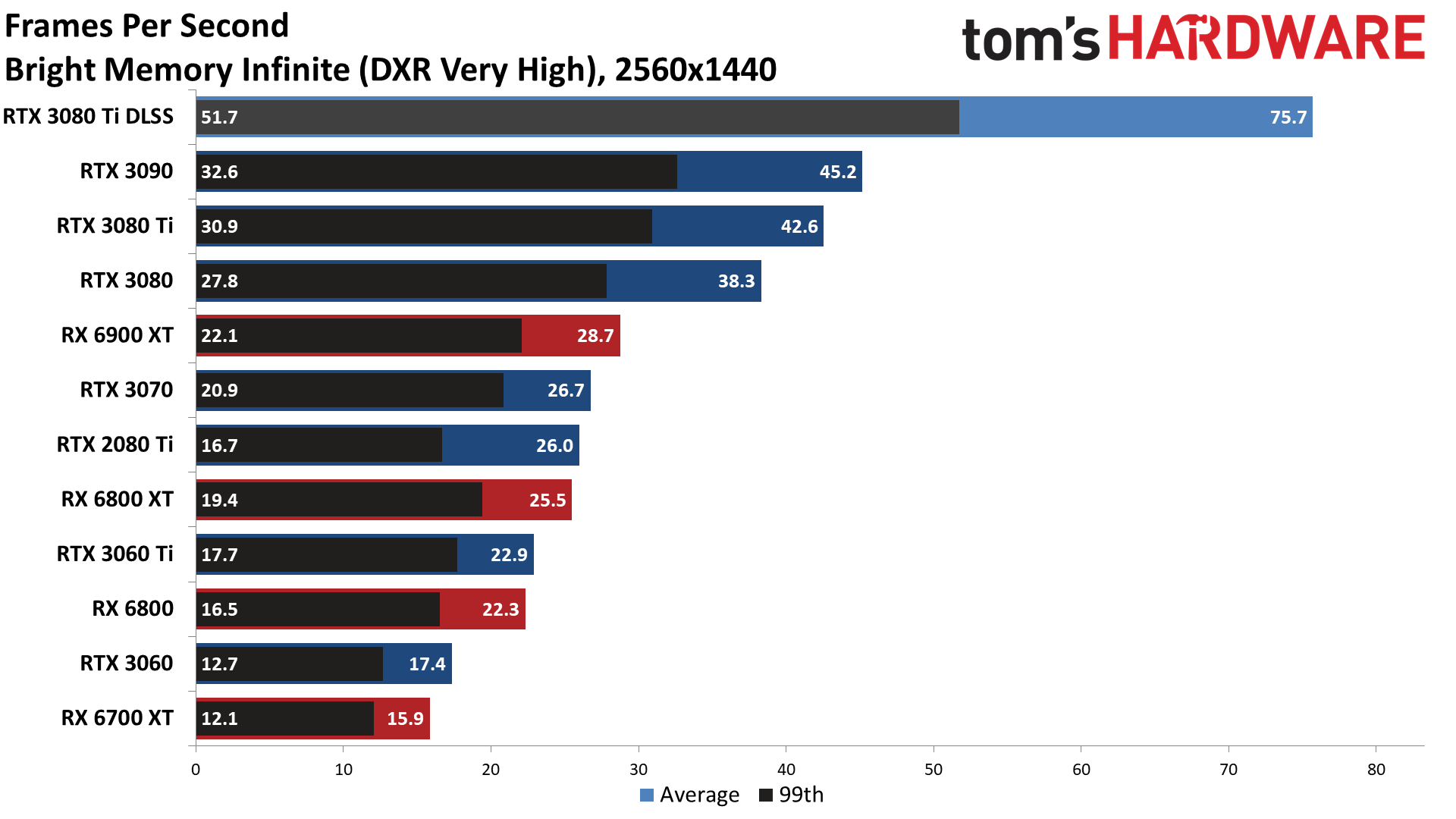
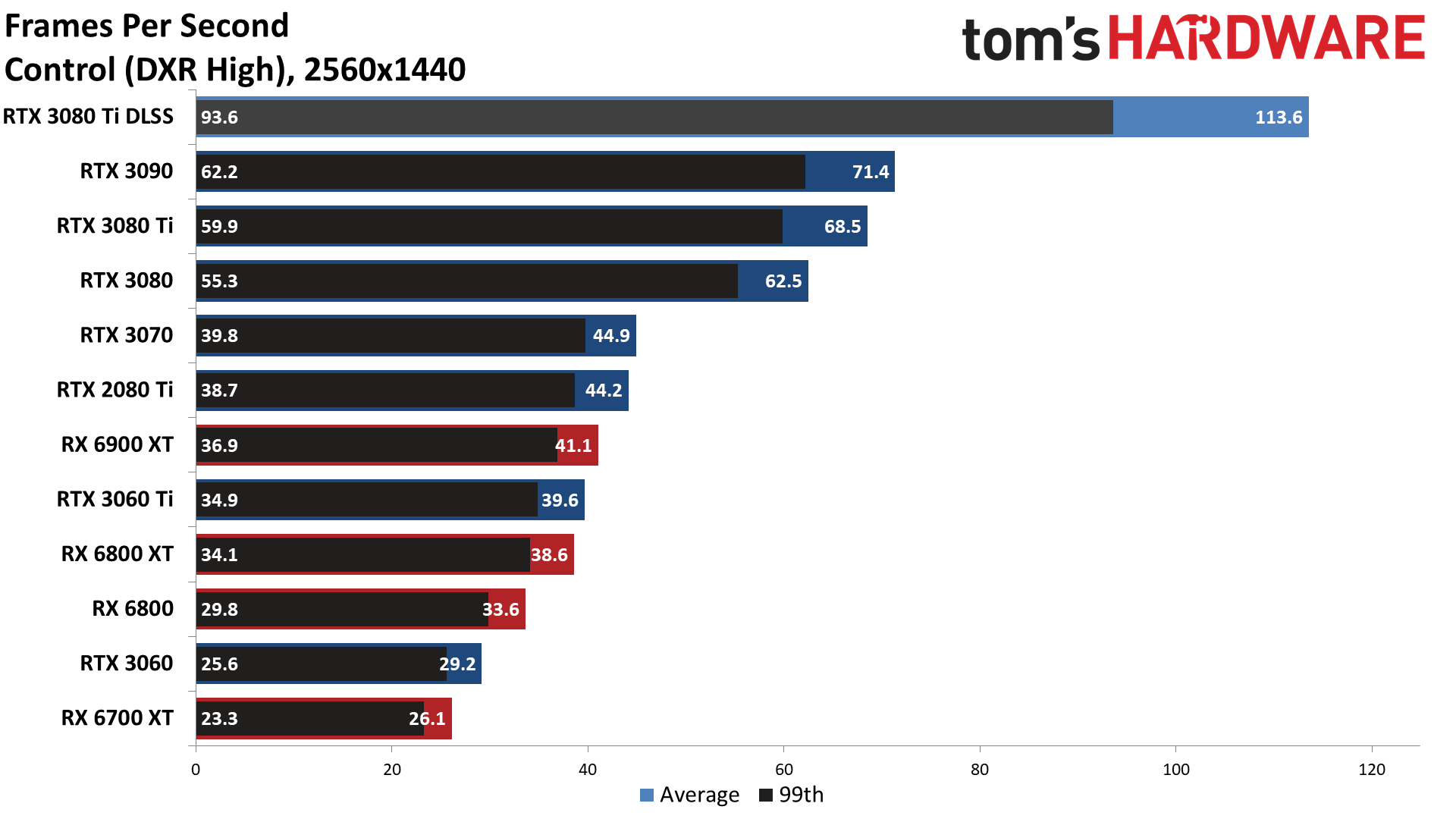

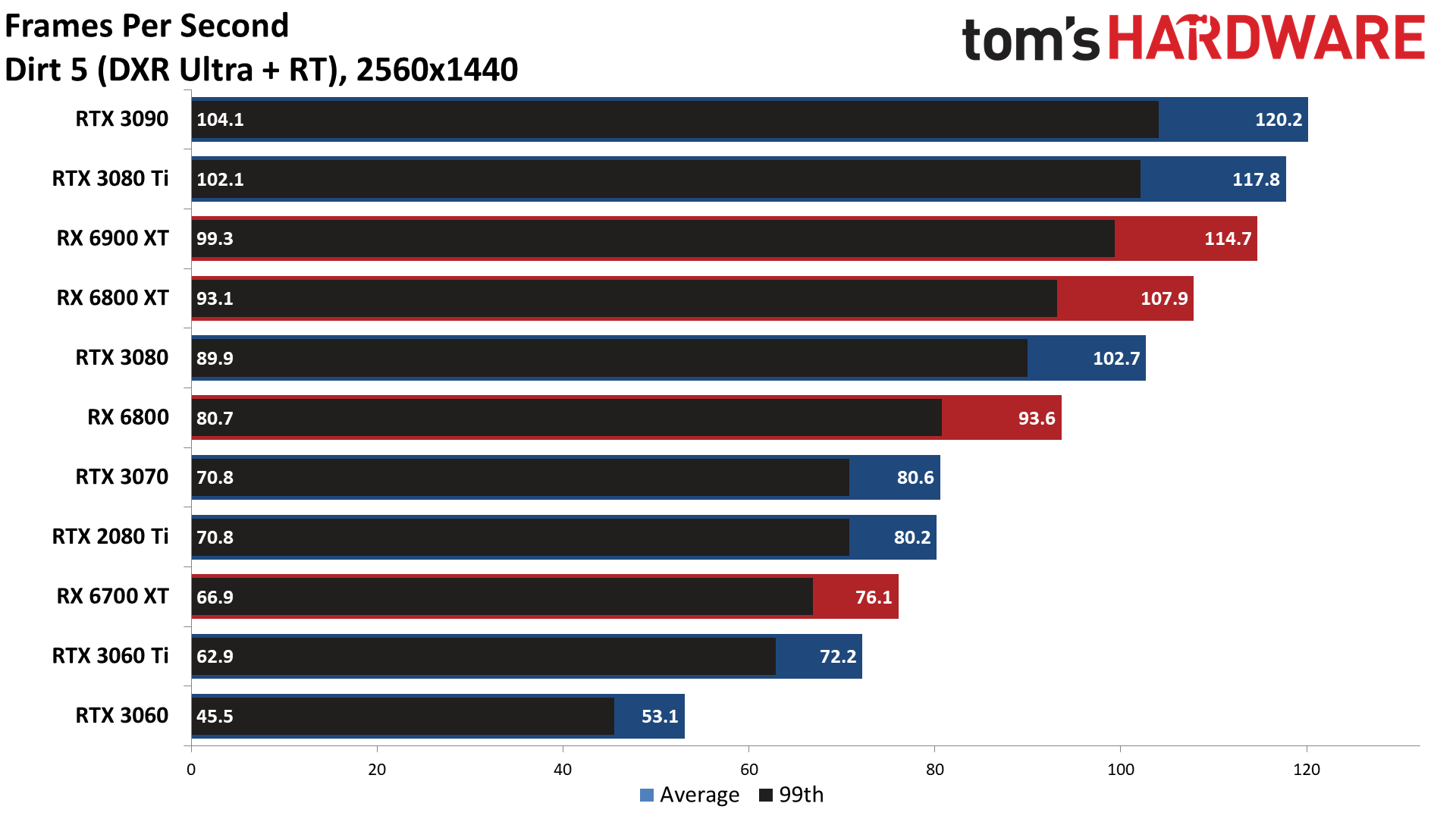


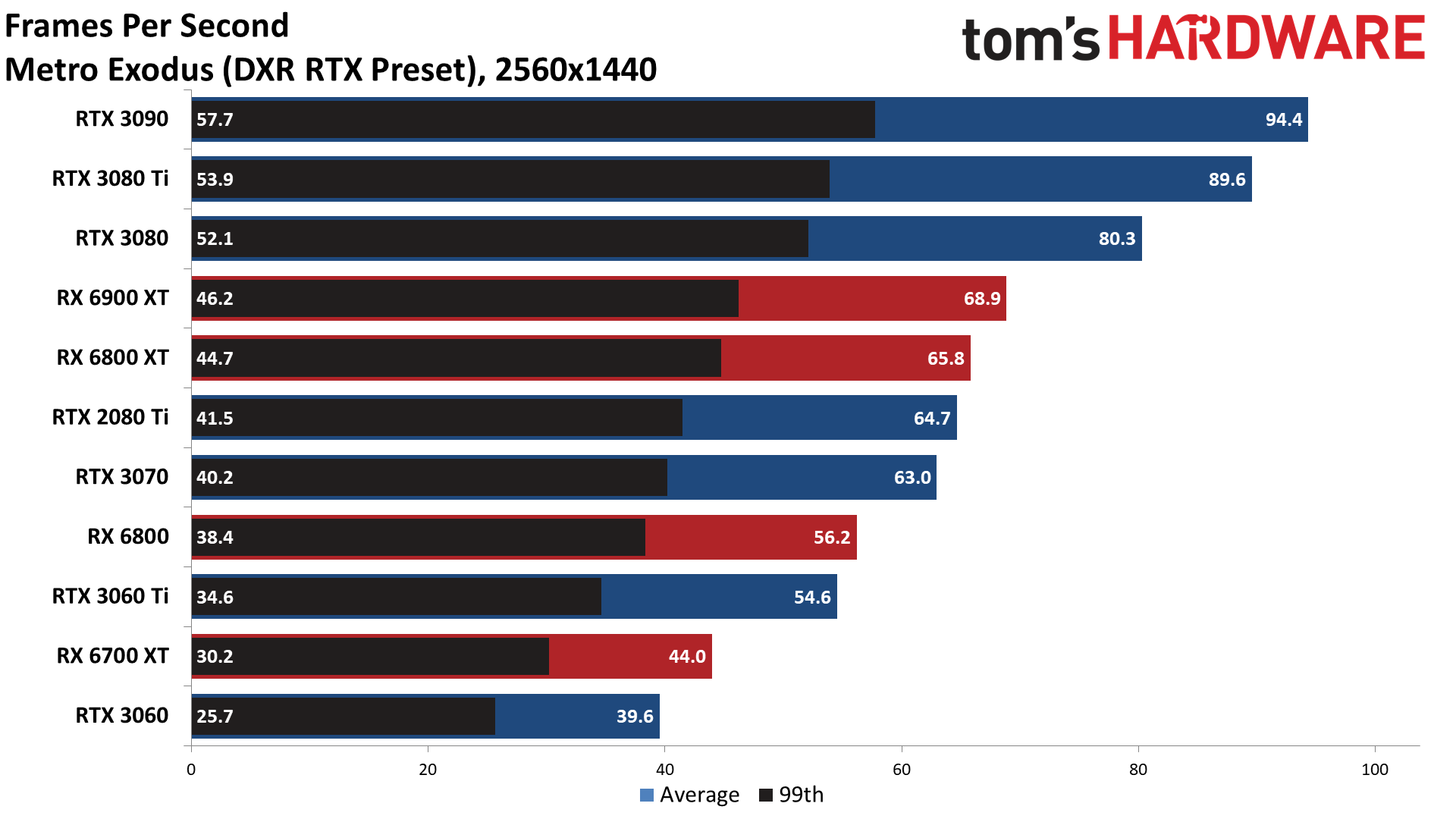

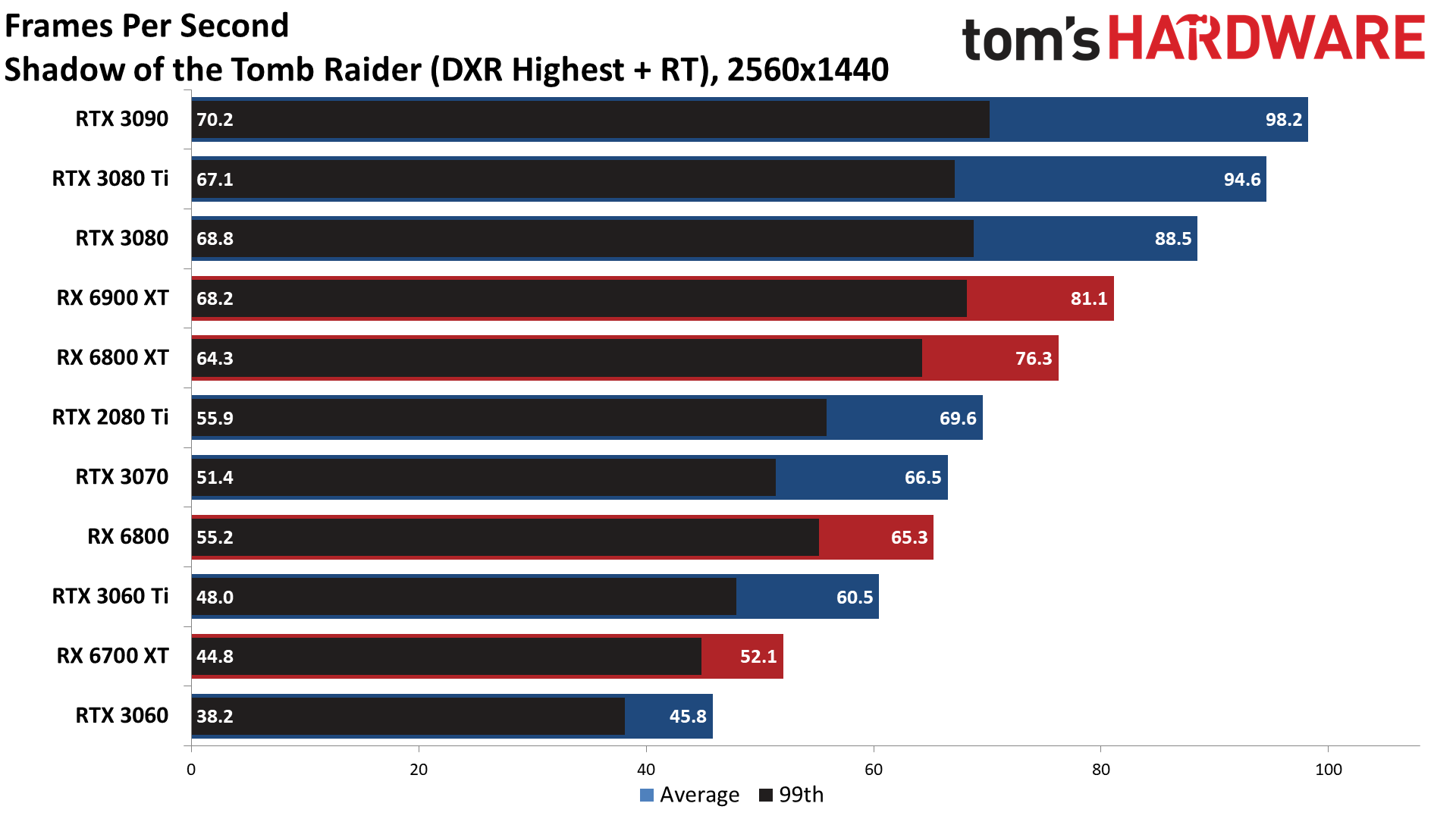

While AMD was competitive in games that use traditional rendering techniques, ray tracing continues to strongly favor Nvidia. We even included two AMD games (Dirt 5 and Godfall) that don't actually benefit all that much from ray tracing. Games that use more effects, like Bright Memory Infinite, Control, Cyberpunk 2077, Fortnite, and Minecraft really benefit from Nvidia's second-generation RT cores, not to mention DLSS 2.0. (Note that we're still using the original Metro Exodus and not the Enhanced version, which also adds more RT effects and DLSS 2.0.)
We're not going to say ray tracing is required to enjoy most games, but it can make a difference. Given a few more years of work and hardware improvements, we'll hopefully see games that push visuals to new levels of fidelity. We're just not there yet.

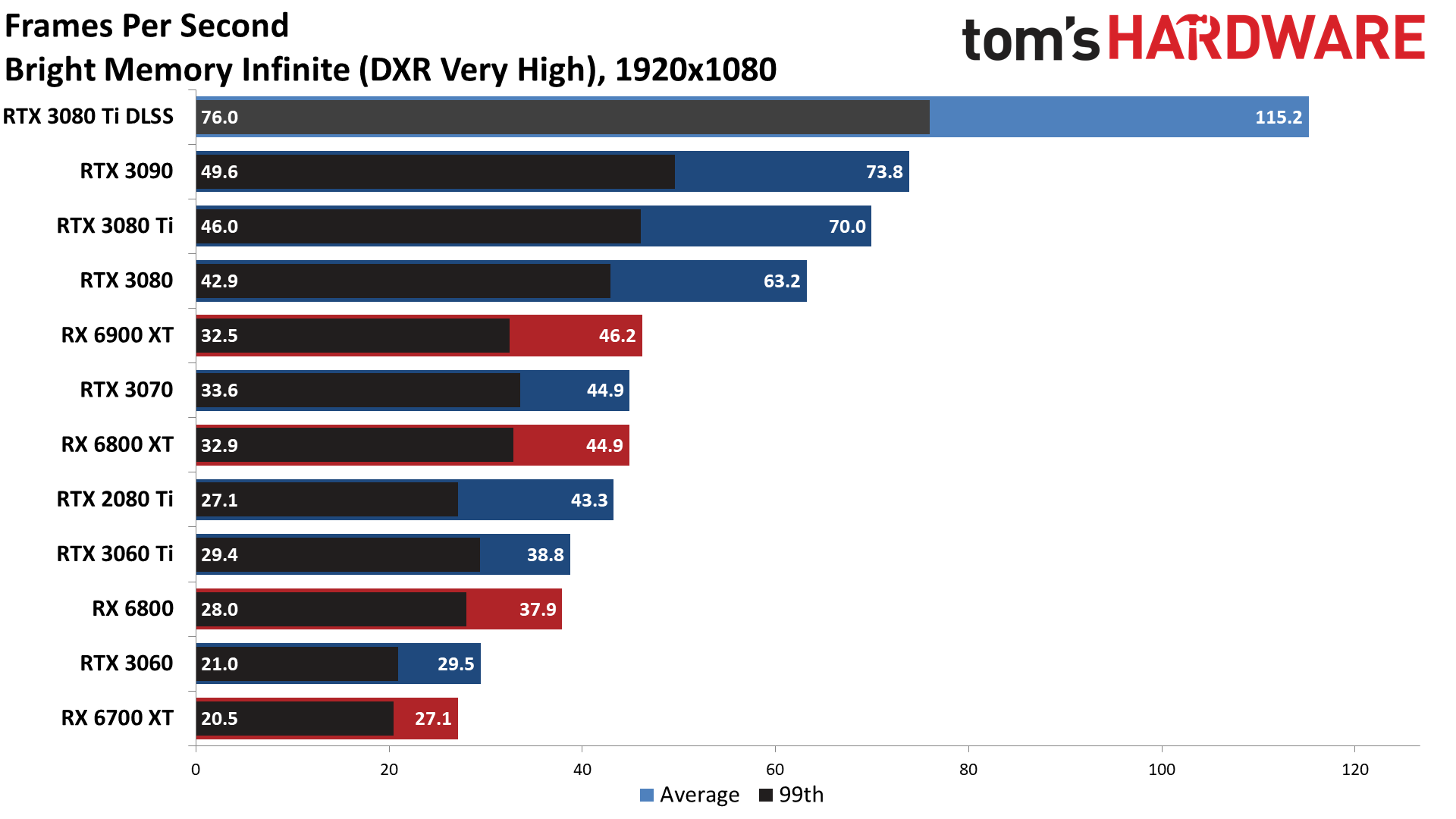
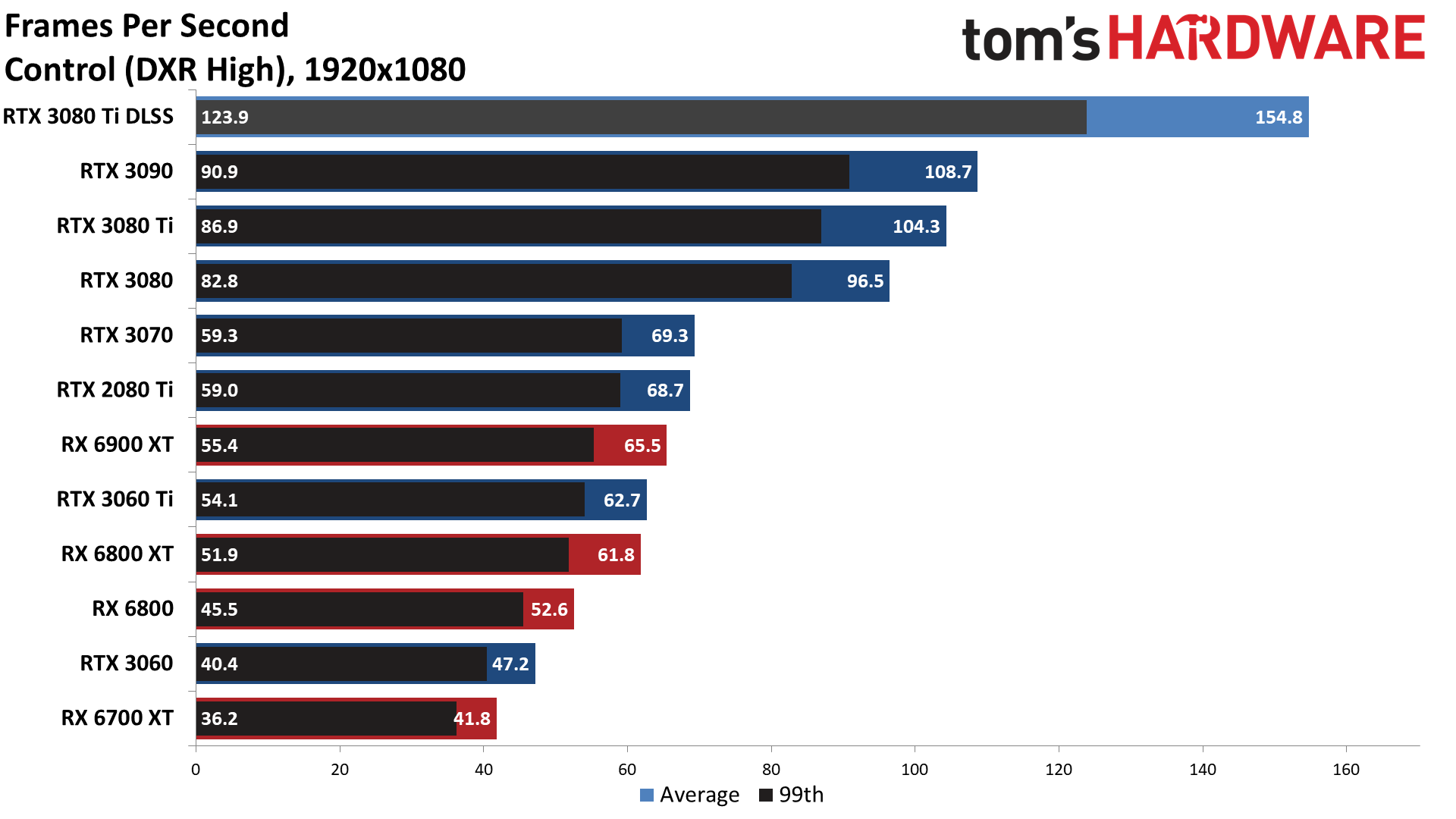

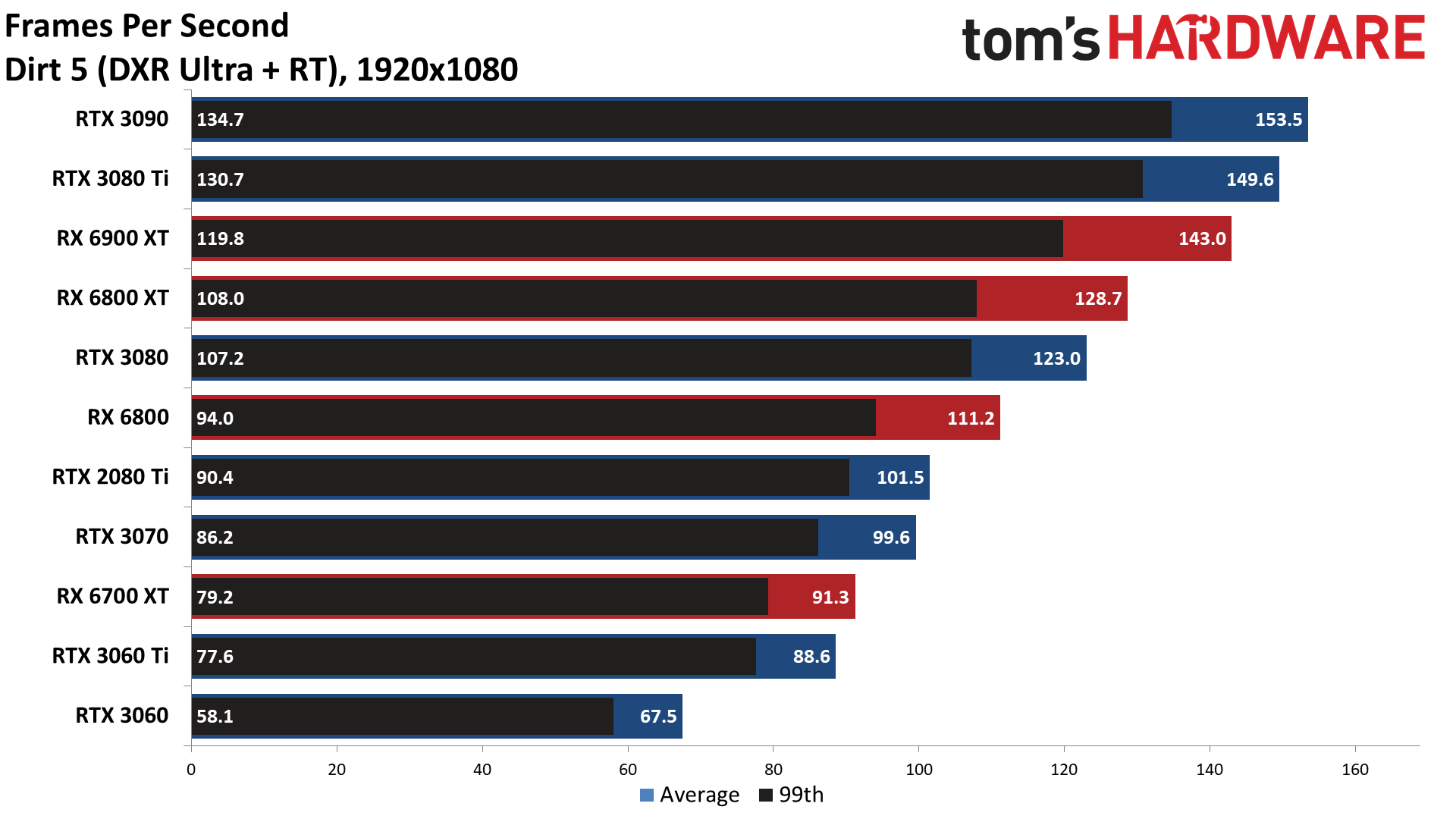


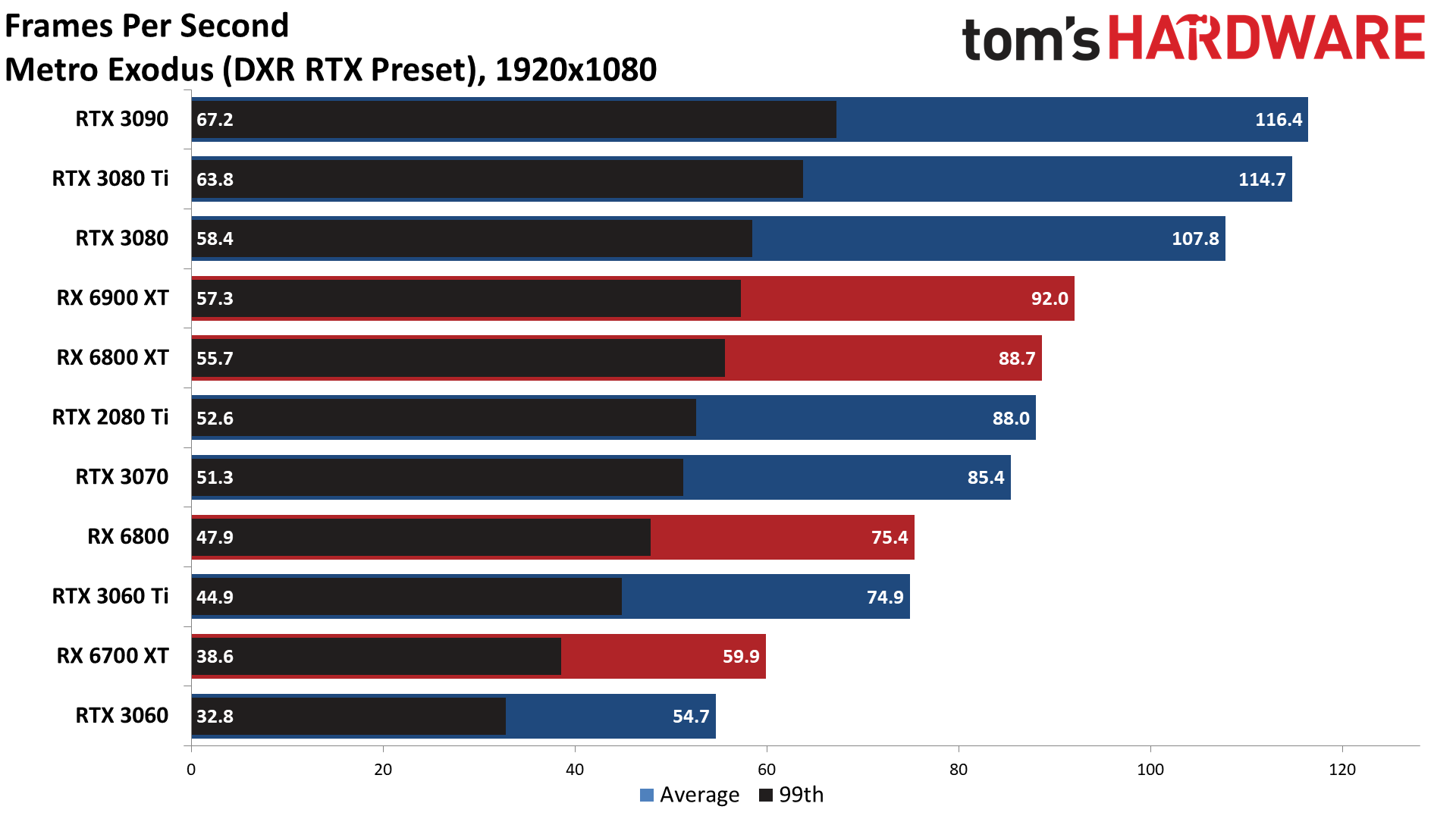
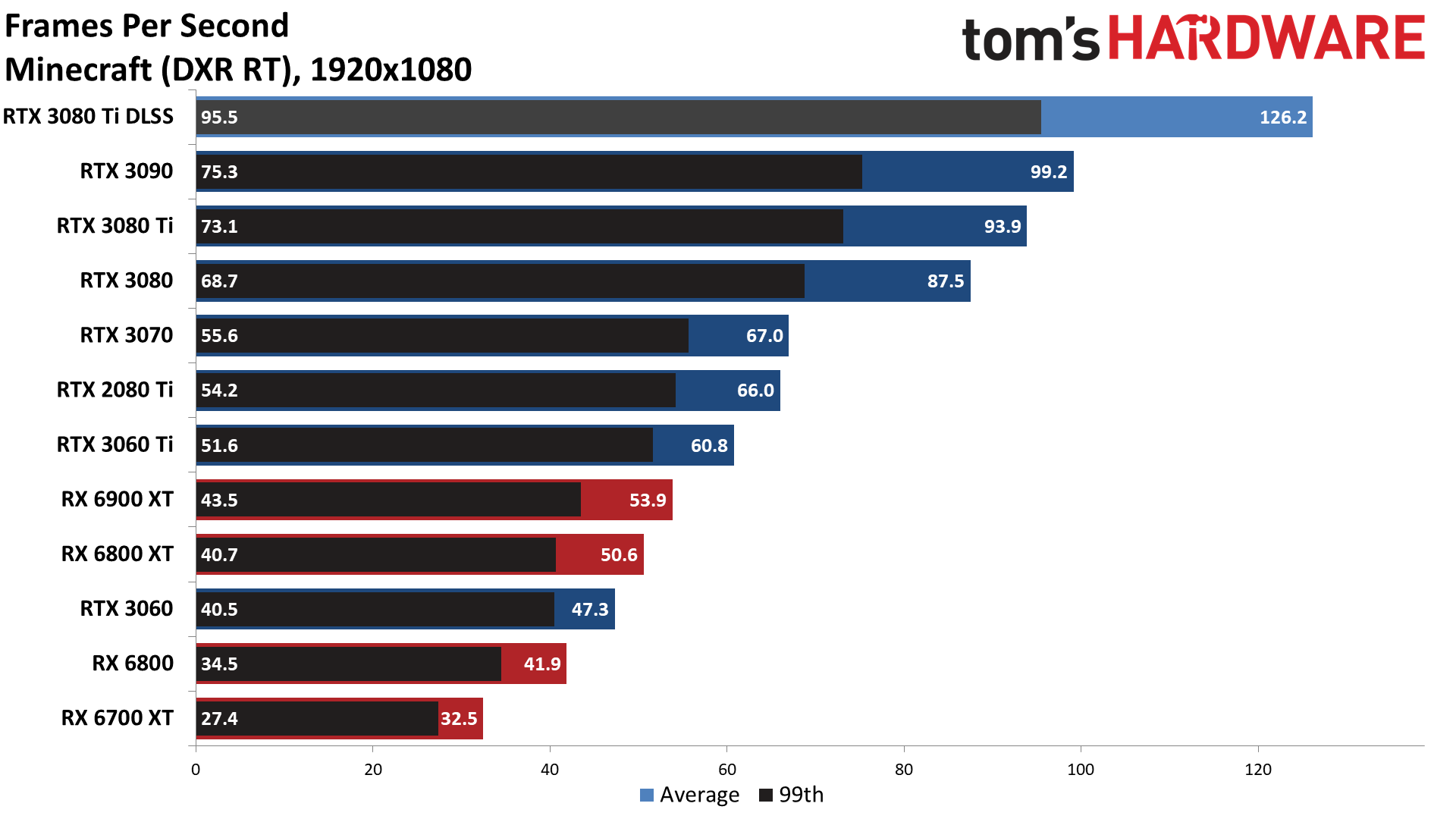
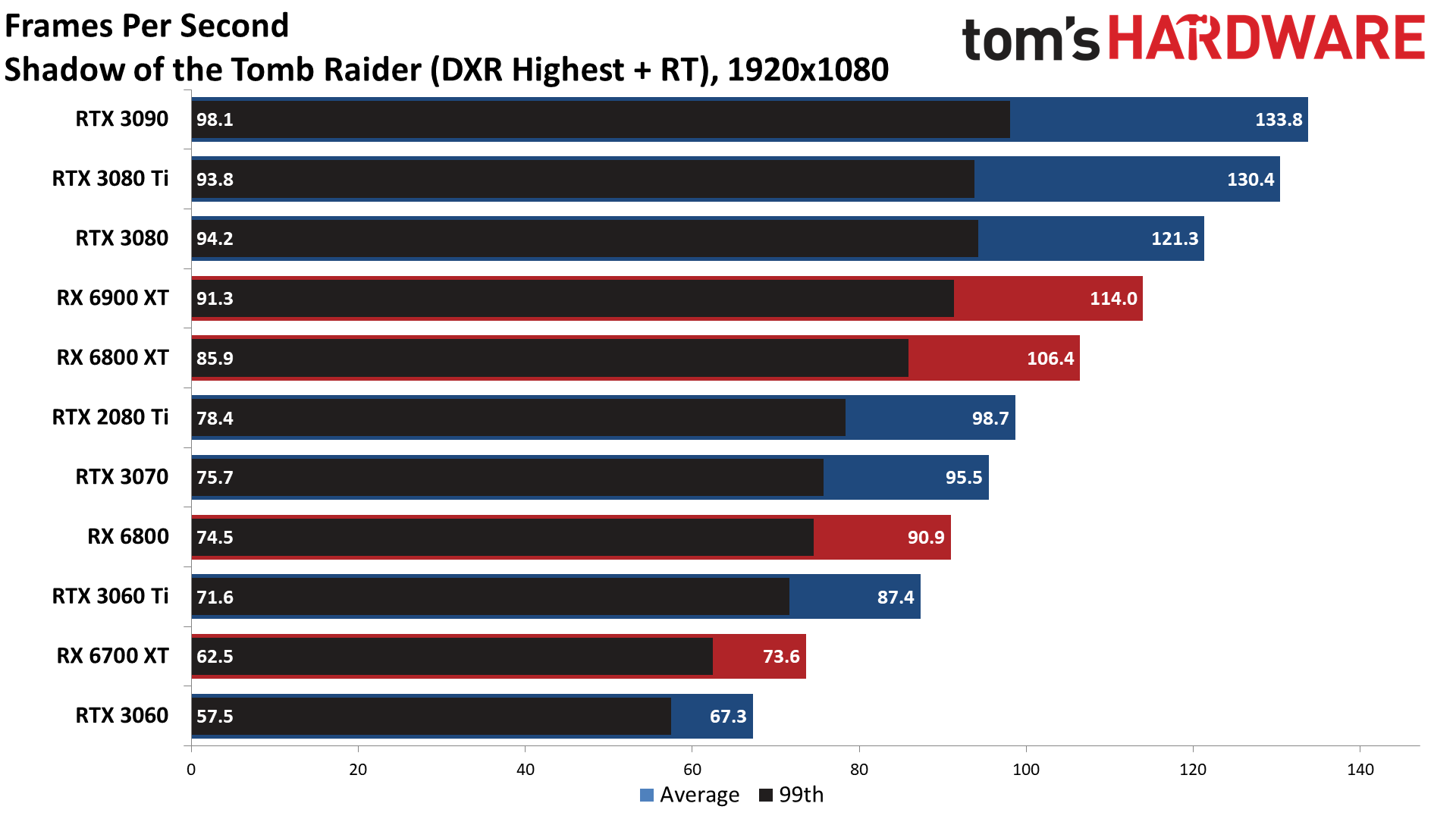
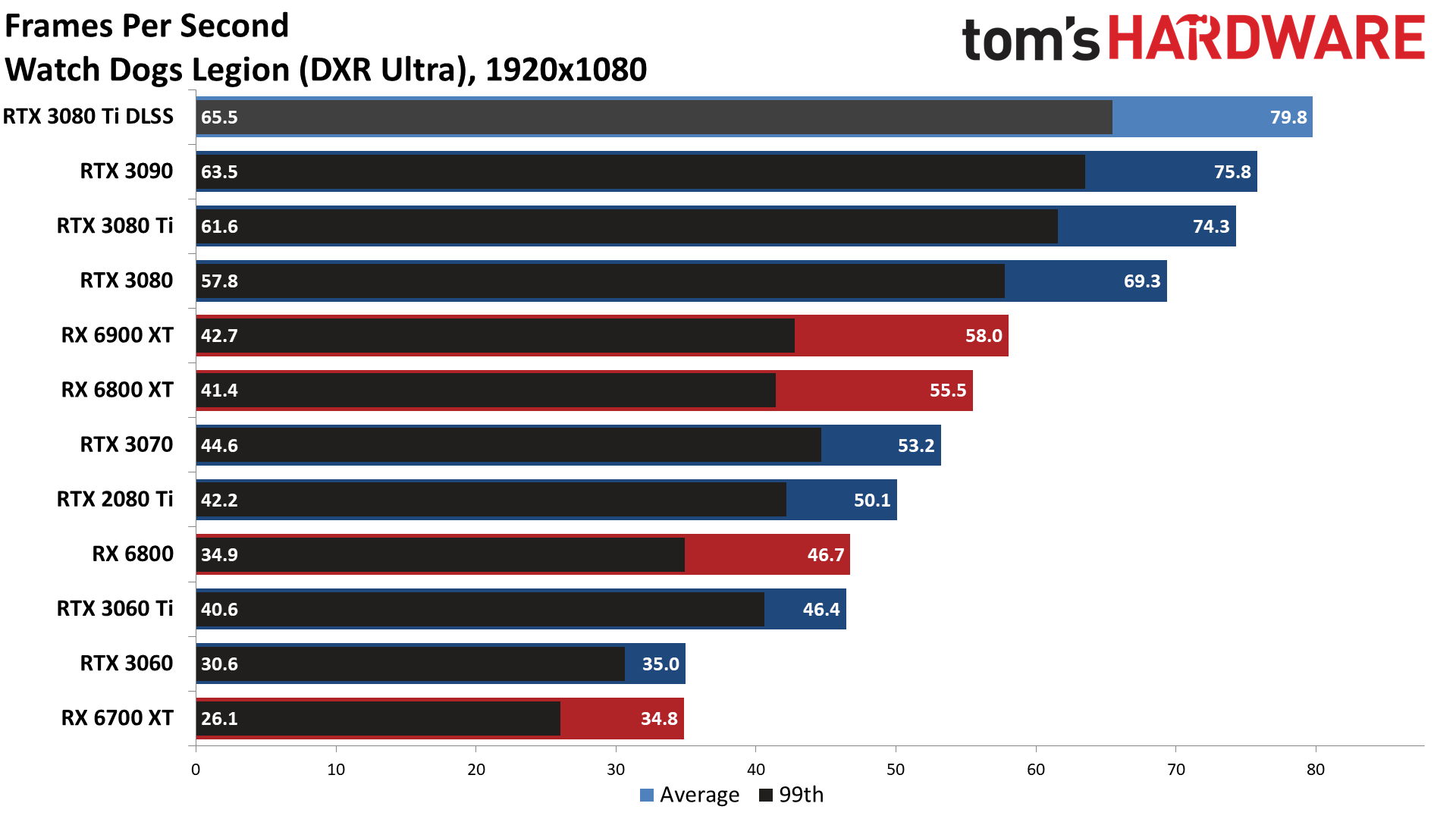
Even 1080p can be taxing with all the ray tracing effects enabled. The RTX 3080 Ti continues to come in just behind the RTX 3090, beating the closest AMD card by more than 20%. Dirt 5 and Godfall are the outliers again, with RT only used for shadows — what we'd argue is generally the least impressive use of ray tracing.
While the various games are all promoted either by Nvidia or AMD, we'd say Fortnite is probably the best 'neutral' look at how the cards stack up with RT enabled — mostly because Epic has a vested interest in optimizing Unreal Engine to run as good as possible on all GPUs. If you agree with that way of looking at things, the RTX 3080 Ti beats the RX 6900 XT by over 30% in Fortnite, even at 1080p.
GeForce RTX 3080 Ti: Power, Clocks, Temperatures, and Fan Speeds
Okay, we said 'power' but we actually don't have power results yet. Jarred recently moved halfway across the US, and in the process, his power testing equipment partially failed. The RTX 3080 Ti does appear to peak at around 350–360W, and we'll update this page with proper power testing using our Powenetics equipment as soon as we're able to replace the failed bricklet. In the meantime, here's a look at clock speeds, temperatures, and fan speeds.
We use Metro Exodus running at 1440p ultra (without RT or DLSS) and FurMark running at 1600x900 in stress test mode. Each test runs for about 10 minutes and we log the result to generate the charts. For the bar charts, we only average data where the GPU load is above 90% (to avoid skewing things in Metro when the benchmark restarts).
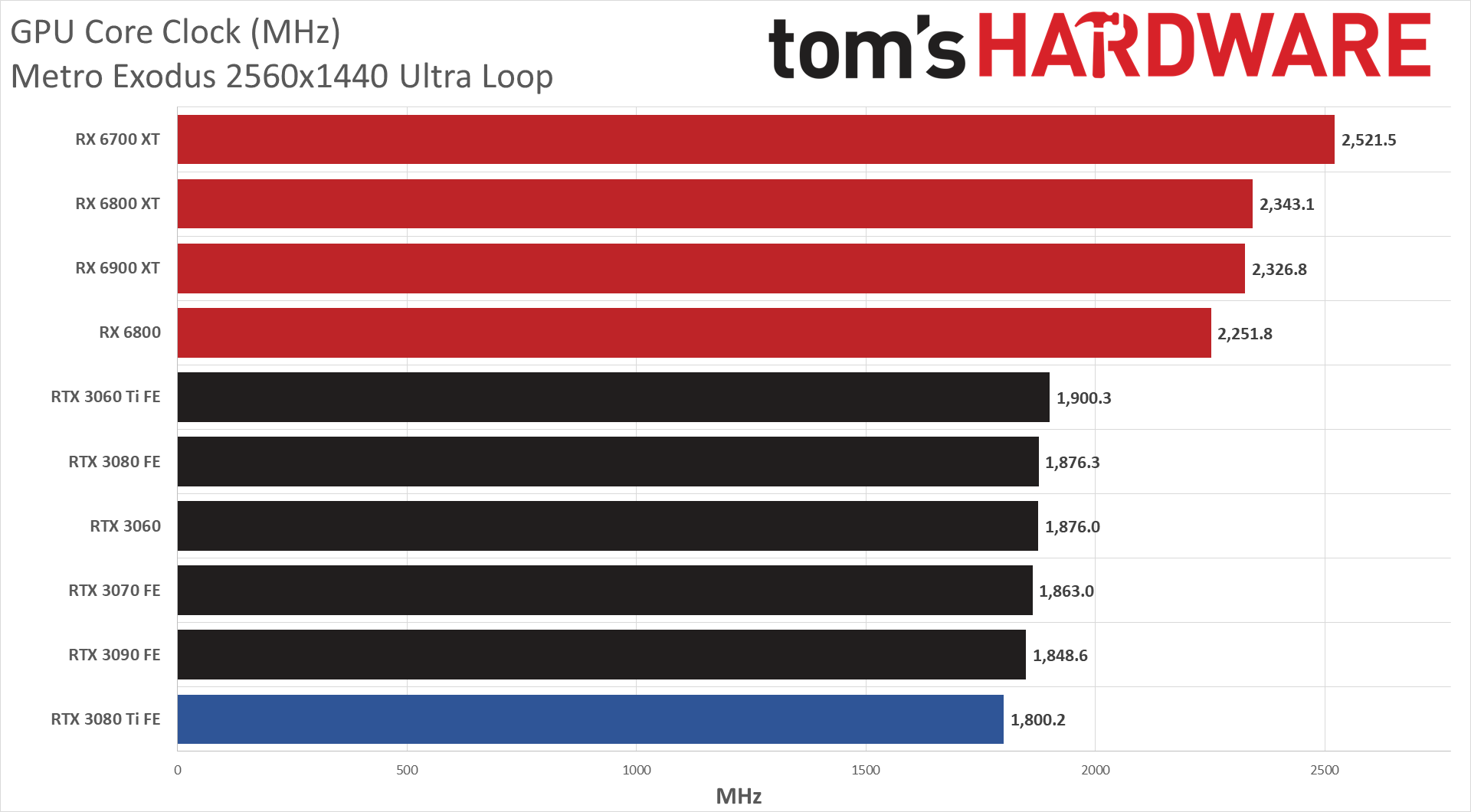
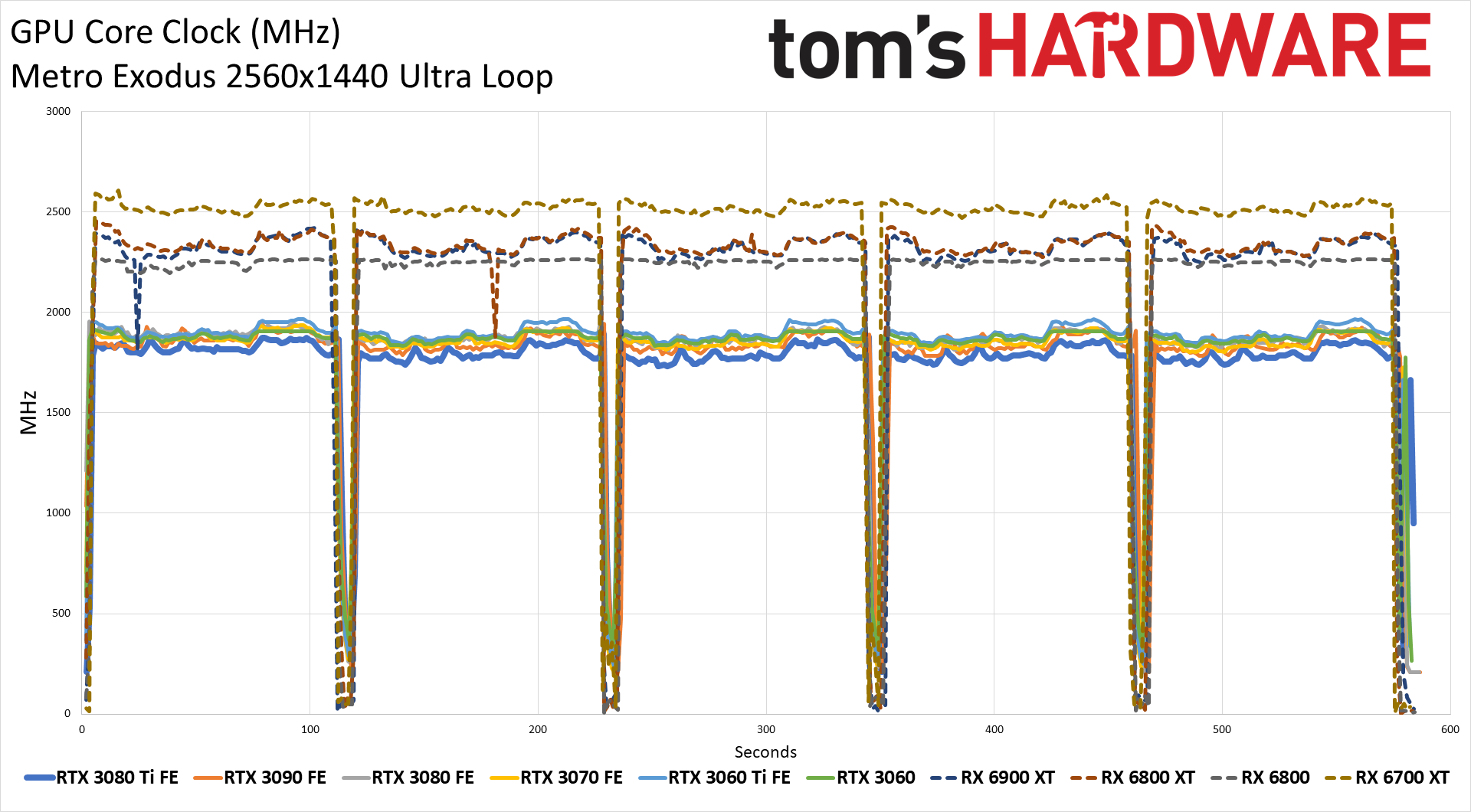
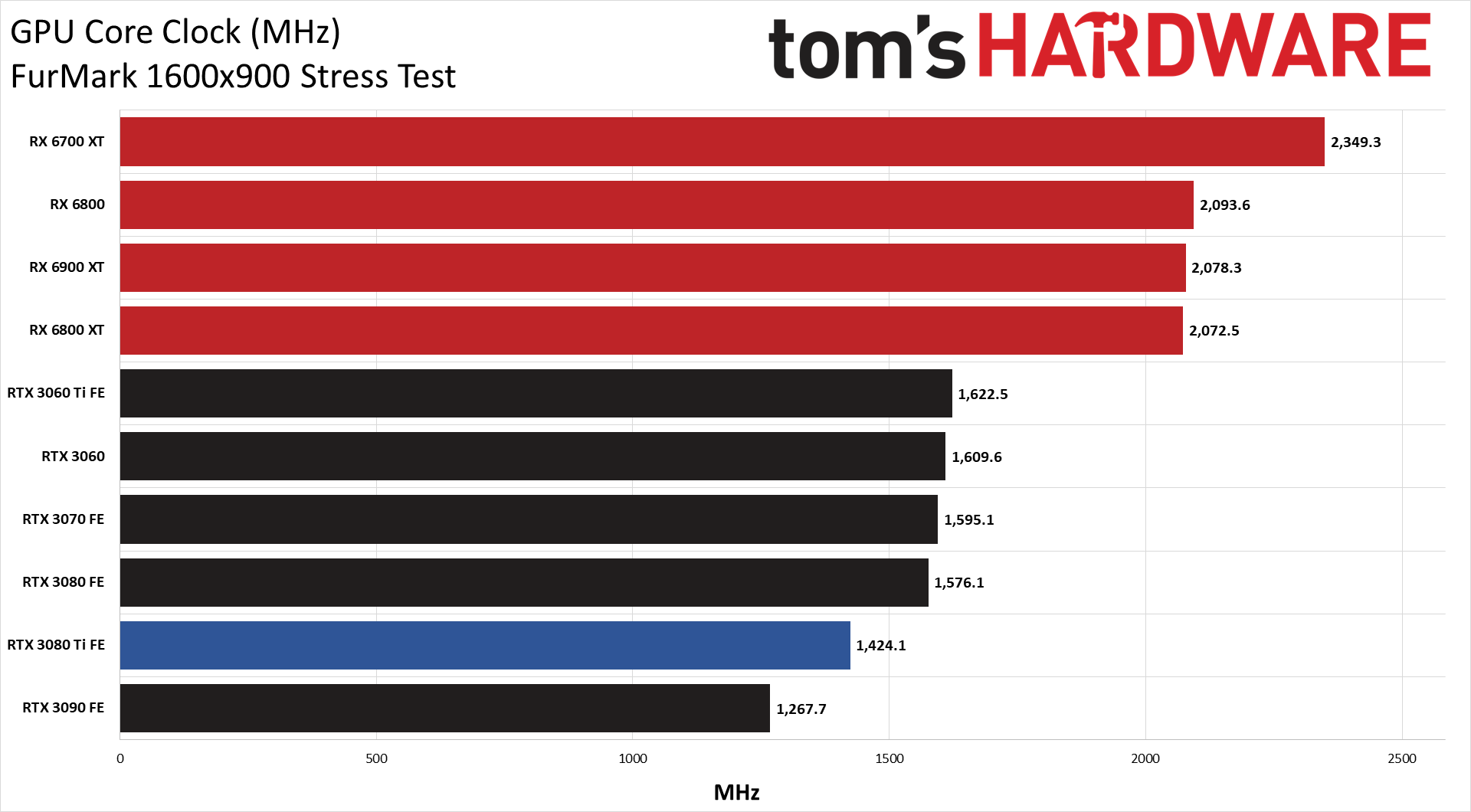

While the GeForce RTX 3080 Ti technically beat its rated boost clock of 1665MHz in Metro, averaging 1800MHz, it also delivered the lowest average GPU clocks out of any of the latest-gen GPUs. In FurMark, all of the GPUs clock much lower to avoid blowing past their TDP. Again, the RTX 3080 Ti exceeds the base clock of 1370MHz, but not by much.
AMD's RDNA2 cards are tuned for much higher clocks, but we would have liked to see the 3080 Ti land a bit closer to the 3090 here. A large part of the deficit likely comes thanks to the unmodified RTX 3080 cooler, which certainly doesn't appear to be coping all that well with the added power and heat, as we'll see in a moment.
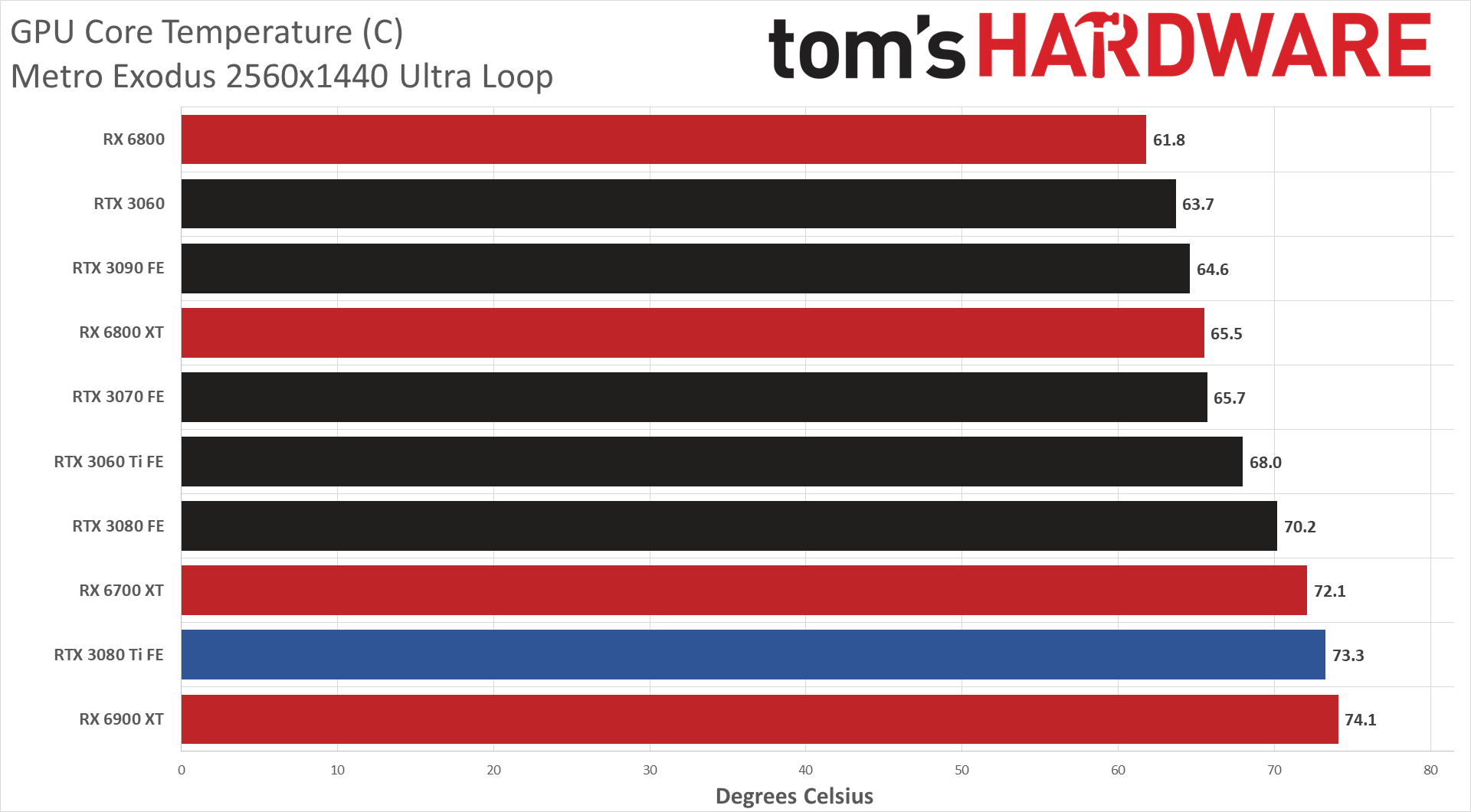
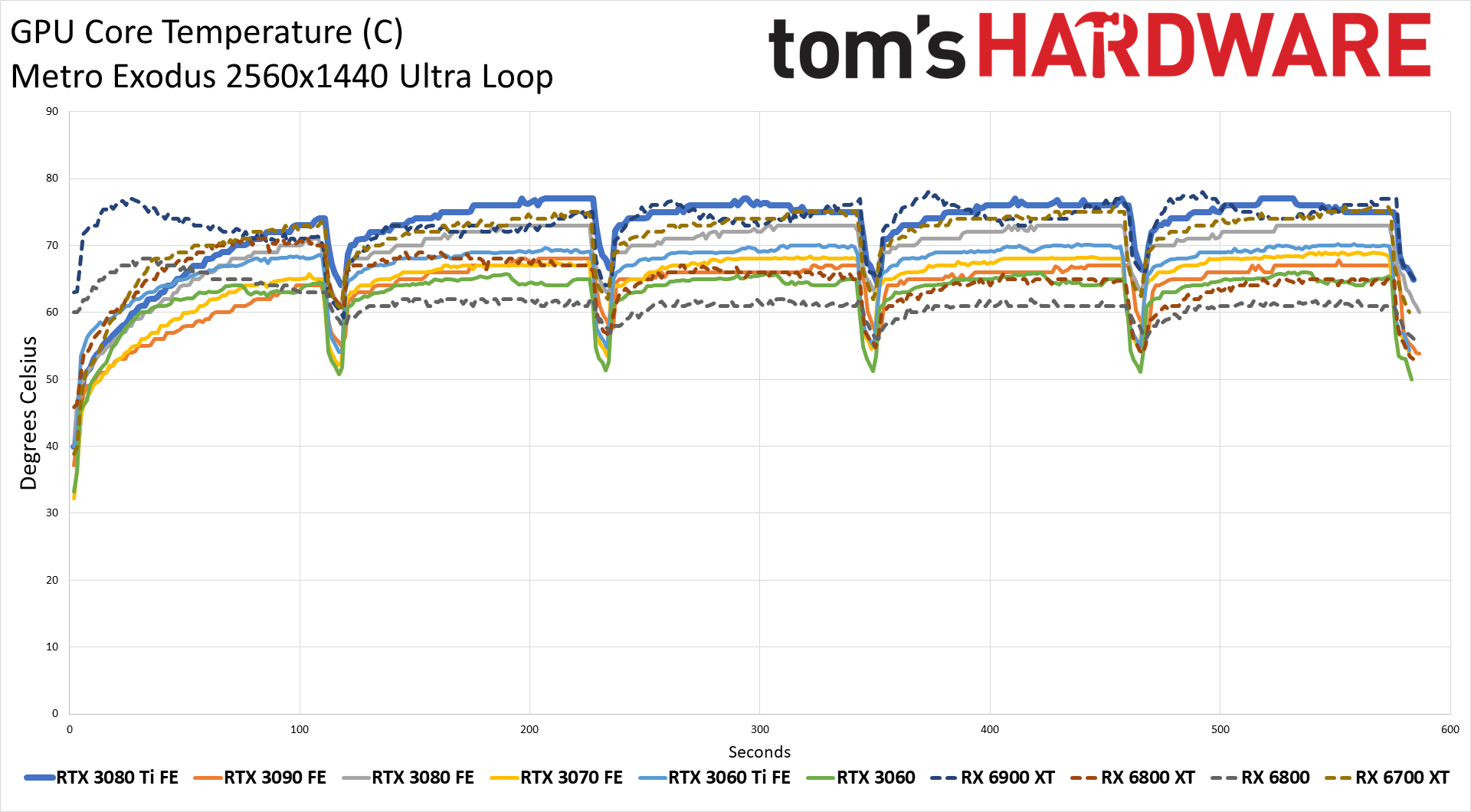

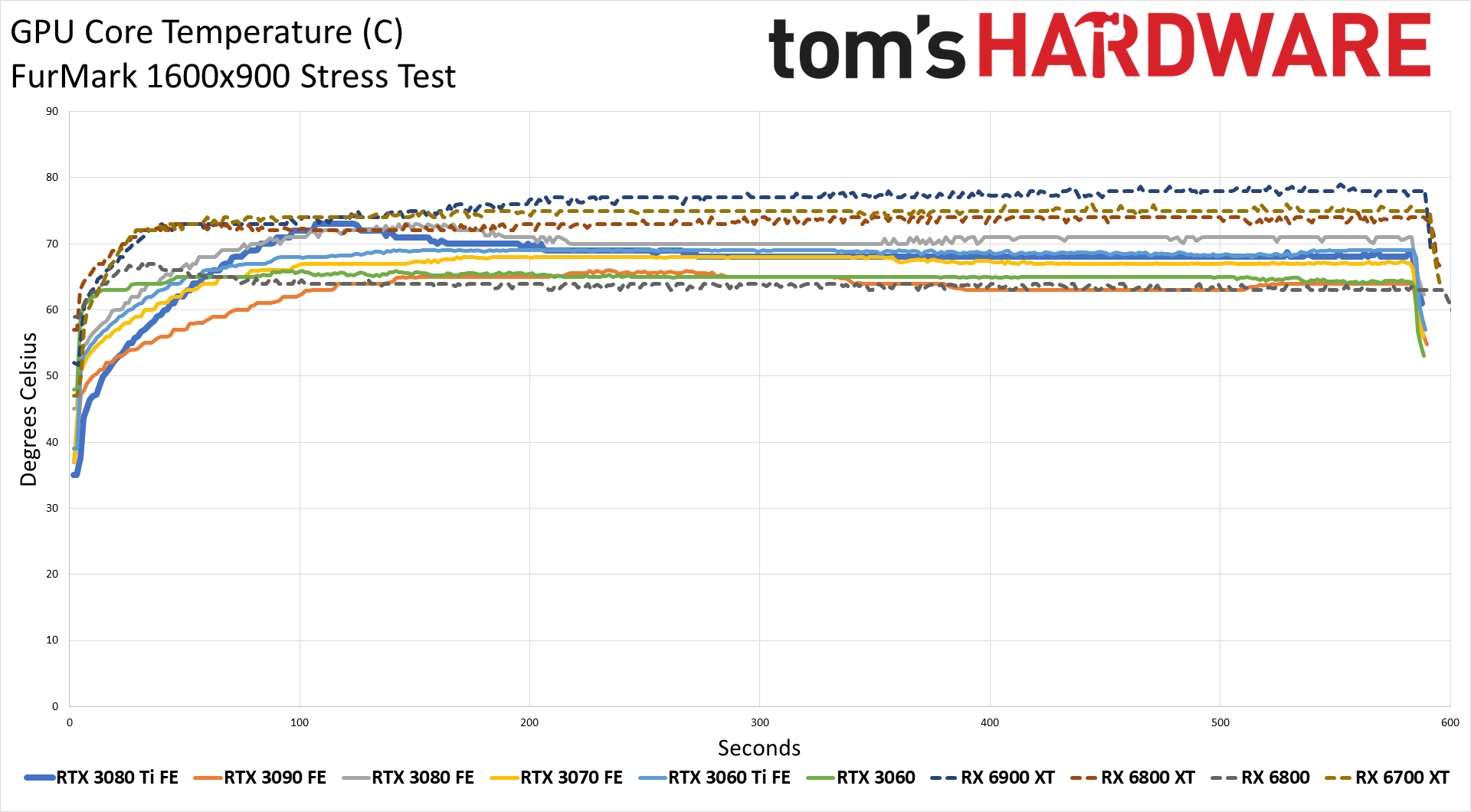
Interestingly, temperatures don't look too bad in FurMark, but the 3080 Ti was one of the hottest running cards in our gaming workload. 73 degrees Celsius (C) on the GPU core isn't particularly worrisome, though we did see GDDR6X temperatures well above 100C when gaming at 4K in multiple games. Again, we really wish Nvidia would have done a bit more to improve the RTX 3080 Ti Founders Edition design — better GDDR6X thermal pads might have sufficed.
As we stated earlier, it's not the GPU thermals alone that are important. We've seen numerous instances over the past nine months where cards with GDDR6X run hot on the memory. Fresh from the box hardware represents the best-case scenario for the hardware, outside of modding the card yourself. If the RTX 3080 Ti already hits peak temperatures of 104C on the memory in some games, we expect that to get worse over time.
We've seen this on lots of previous generation cards, like the RTX 2080 Ti, where one Founders Edition card we tested ended up having to spike fan speeds to 100% every 60 seconds or so while gaming just to keep thermals in check. If you have any RTX 30-series card with GDDR6X memory, we recommend keeping an eye on temperatures and keeping the heatsink and fans clear of dust with regular cleanings. Not that we don't recommend that as a general rule regardless, but it will likely prove even more important on the current generation of cards with 300W and higher TDPs.
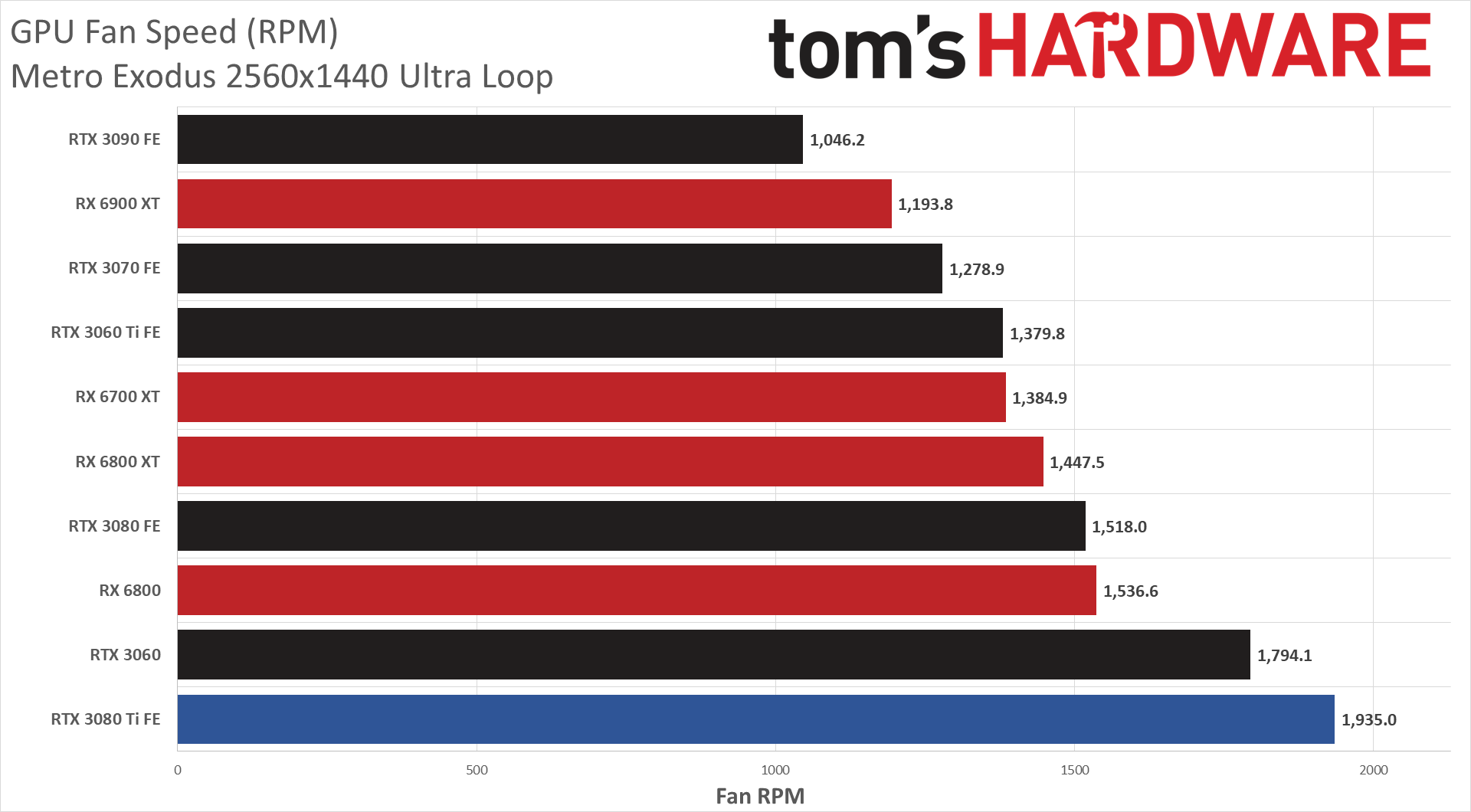
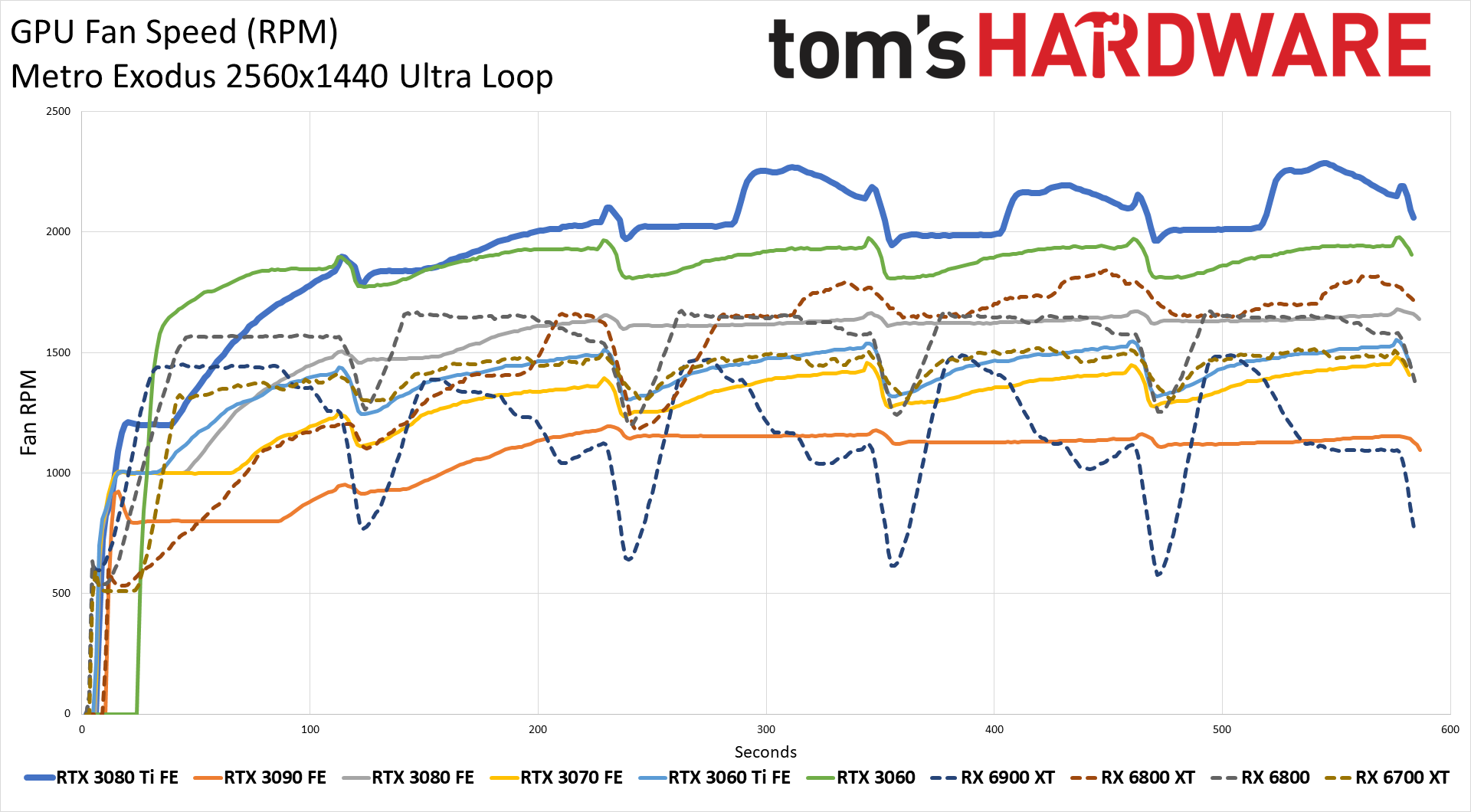
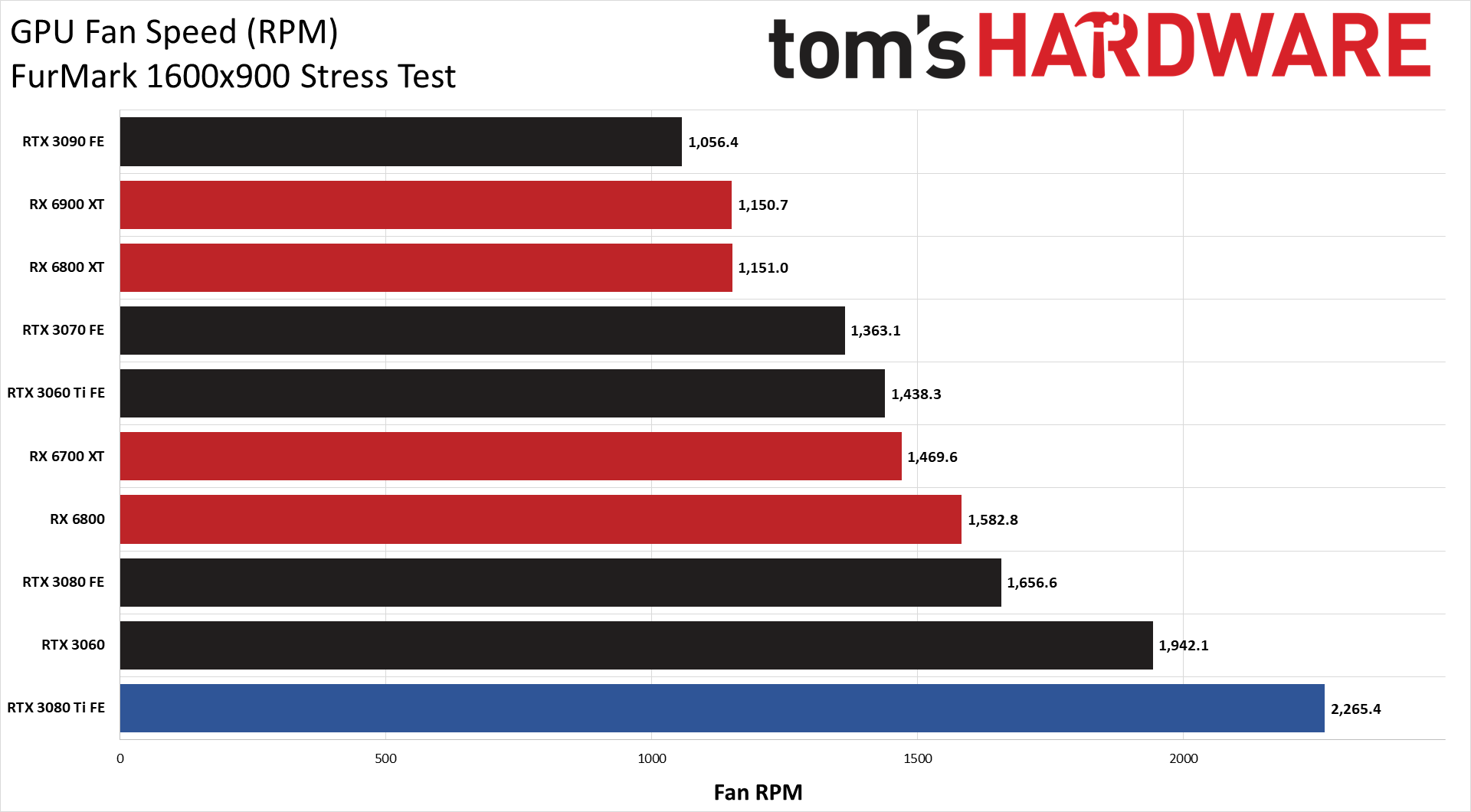
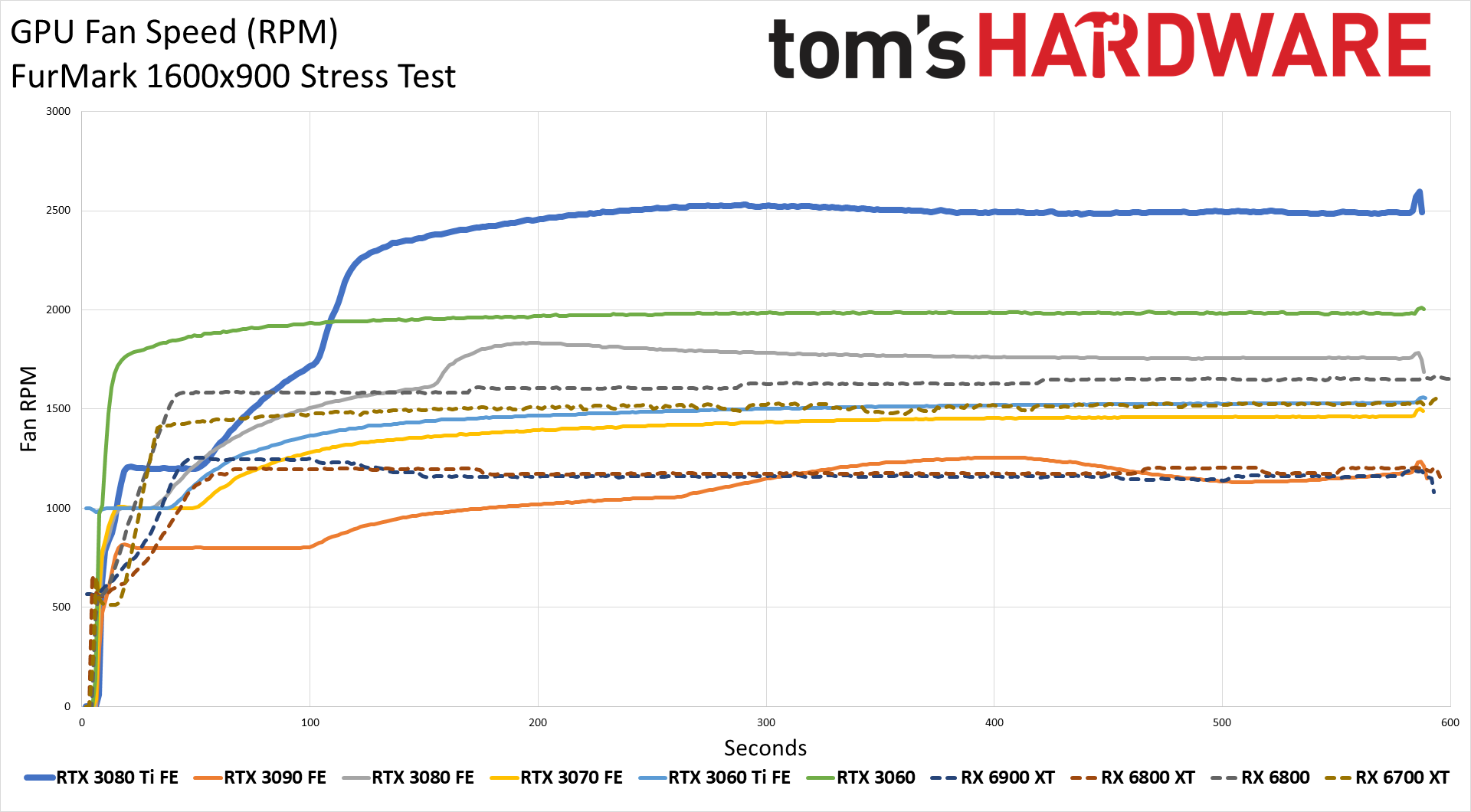
The corollary to the relatively weak thermal performance of the RTX 3080 Ti is that it also had far and away the worst fan speeds. We're used to seeing 2000+ RPM only when overclocking or using cards with lackluster coolers. Which we suppose applies to the 3080 Ti Founders Edition. The average fan speed during our Metro test was 'only' 1935 rpm, but each loop of the benchmark only lasts about two minutes. Running any taxing game for an hour or two will easily push the fan speed into the 2250 rpm range, unless you have a case that provides a lot of airflow (and probably even then).
GeForce RTX 3080 Ti: Skip the Founders Edition
Nine months after Ampere first appeared in the form of the RTX 3080 and RTX 3090, Nvidia is back with a mid-cycle refresh it's calling "the ultimate Ti." Nvidia makes reference to the GTX 1080 Ti, which admittedly was a great card back in the day. It was priced $150 above the GTX 1080 at launch and actually inherited the GTX 1080 Founders Edition launch price, all while delivering about 30% better performance. Even today, gamers with GTX 1080 Ti cards can still run every game out there — just not at maxed-out settings. That's a pretty high bar to clear, and frankly, the RTX 3080 Ti doesn't come close.
The RTX 3080 Ti isn't awful, but if you're willing to plunk down $1,200 for a graphics card — in theory, because we all know these are going to end up selling for closer to $2,000 or more for the foreseeable future — spending $300 more to double your VRAM and get a better cooler with the RTX 3090 seems like a better plan. Instead of a marginally higher price than the RTX 3080, the MSRP is 70% higher and the RTX 3080 Ti is only about 10–12% faster on average. Plus, as we mentioned above, the Founders Edition cooler can't keep up with the additional GPU cores and GDDR6X memory.
The RTX 3080 Ti is far more similar to the RTX 2080 Ti than the 1080 Ti — except it's nine months late to the party, which is probably just as well since GPU shortages will likely continue throughout the rest of the year. By the time we're able to stroll into a retail shop or check out of an online store without battling bots and shortages, we might be looking at the next generation Hopper and RDNA3 architectures.
There's potential for far more promising third party cards, but then we still have the price conundrum. It's been an incredibly bleak year for graphics cards so far. This card was probably originally slated to be a $999 competitor to the RX 6900 XT, but in the current market, Nvidia has bumped the price to reap some of the profits that the AIBs and suppliers have been enjoying. Since everything we'd like to recommend ends up costing twice as much as it "should," and much of the price gouging doesn't end up going to Nvidia (or AMD), this is what we get. If you thought the RTX 3090 was too expensive when it launched at $1,500, be prepared for slightly lower performance, half the VRAM, and higher street prices on the RTX 3080 Ti. Well, higher than the 3090 launch price, at least, since the RTX 3090 now basically sells at Titan RTX and Titan V levels these days.
Fundamentally, there's nothing wrong with the RTX 3080 Ti on paper. Even the price might be tolerable for those with deeper pockets. But unless we see a dramatic increase in supply — or a massive decrease in demand (which might happen, as mining profitability has dropped quite a bit during the past month) — finding one in stock at a reasonable price will be an exercise in frustration. Anyone still hoping to pick up a 3080 Ti should also opt for a third party card with higher factory clocks and a beefier cooler. We'll be looking at some of those cards in the coming days.

Jarred Walton is a senior editor at Tom's Hardware focusing on everything GPU. He has been working as a tech journalist since 2004, writing for AnandTech, Maximum PC, and PC Gamer. From the first S3 Virge '3D decelerators' to today's GPUs, Jarred keeps up with all the latest graphics trends and is the one to ask about game performance.
-
Heat_Fan89 Reply
If it came with 20GB of RAM it would have been ideal. I have an RTX 3080 in an HP Omen prebuilt and all i'm reading is that if you already have an RTX 3080, it's a terrible idea to upgrade.thepersonwithaface45 said:Double the price for 25% more performance? Am I reading that right?
Then the potential upgrader needs to understand according to leaks that the RTX 4000 series should double the performance of the current 3000 series cards. Even if you don't have an RTX 3080 I still see paying a lot more for a marginal improvement over the base 3080 is a no go for me. -
ingtar33 just buy it.Reply
dont queston the predatory pricing
dont question the hideous price/performance ratio
reward nvidia for its greed -
thepersonwithaface45 I mean it was obvious for current 3080 owners to not even try for this 'upgrade' but really? $1200? 300 less than a 3090?Reply
Like why would I settle for a 3080ti if it's only 300 more dollars separating me from a 3090? The size of the damn thing? I don't understand. -
NoFaultius After reading the introduction I was disappointed that the charts did not contain the 2080ti for comparison purposes. I expected it to be there after the initial chart listed the specs of the 2080ti against the 3000 cards. As a 2080ti owner, I agree with the author that this is the first upgrade path made available to existing 2080ti owners and its inclusion in the data would have made sense. Plus, I personally would have like to see it there on the charts so I could see my current card vs all the potential upgrade paths into the newest generation of cards from AMD and NVIDIA ;-PReply -
spongiemaster Reply
Where are you getting a 3090 for $1400? The original MSRP was $1500 for the FE edition. If you can't get one of those, the aftermarket starts around $2000. Ebay, you're looking at over $3000.thepersonwithaface45 said:I mean it was obvious for current 3080 owners to not even try for this 'upgrade' but really? $1200? 200 less than a 3090?
Like why would I settle for a 3080ti if it's only 200 more dollars separating me from a 3090? The size of the damn thing? I don't understand. -
thepersonwithaface45 Reply
I go by retail, I have a microcenter near me!spongiemaster said:Where are you getting a 3090 for $1400? The original MSRP was $1500 for the FE edition. If you can't get one of those, the aftermarket starts around $2000. Ebay, you're looking at over $3000.
But I did fix the price lol
